



These days, drones are everywhere: conducting military strikes across Pakistan, Yemen, Somalia and Afghanistan; as the underpinning technology for public health infrastructure; for sale to delighted kids in Hamleys toyshop; or as D.I.Y kits and readymades from the Internet. Amazon has proposed to sell fleets of drones, offering super-fast deliveries to its customers.[1] In Haiti, Bhutan, Papua New Guinea and the Philippines, drones have helped rescue natural disaster victims – and transport medical samples and supplies[2] and the Aerial Robotics Laboratory at Imperial College London is developing networks of drones to deliver blood supplies to rural health clinics in Africa[3]. The new ubiquity of drones in these contexts means that we need to think carefully about the personal and political impacts of the emerging drone culture?
Drones: Eyes From A Distance will be the first gathering in Berlin- April 17-18 2015 – of the Disruption Network Lab. This two day symposium presents keynote presentations, panels, round tables, and a film screening held in cooperation with Kunstraum Kreuzberg /Bethanien, with the support of the Free Chelsea Manning Initiative. The event is being held at the Sudio 1 of Kunstquartier Bethanien. And this conference would not be happening if it wasn’t for the tireless dedication of Tatiana Bazzichelli, founder of the Disruption Lab.
As part of Furtherfield’s partnership with the Disruption Network Lab I will chair a panel with Tonje Hessen Schei (filmmaker, NO), Jack Serle (investigative journalist, UK), Dave Young (artist, musician and researcher, IE).This interview with Dave Young is the first of three, in the lead up to the Berlin event.
Dave Young is an artist and researcher based in Edinburgh. His practice follows critical research into digital culture, manifested through workshops, website development, and talks on subjects varying from cybernetics and the Cold War history of network technologies, to issues around copyright and open source/free culture. He is founder of Localhost, a forum for discussing, dismantling and disrupting network technologies. Past events have focused on Google’s entry into media art curation, and the role of analogue radio as a potential commons in the digital age.

Marc Garrett: Hello Dave, I first met you in London when you hosted the Movable Borders: The Reposition Matrix Workshop’s at Furtherfield Gallery in 2013 as part of a larger exhibition called Movable Borders: Here Come the Drones! I remember it well, because the exhibition and your workshops were very well attended and a cross section of the local community came along and got involved. Could you tell us what your workshops consisted of and why you did them?
Dave Young: The workshop series came out of my own research into the history of cybernetics and networked military technologies while I was studying at the Piet Zwart Institute in Rotterdam. The US Military’s use of drones in the War on Terror had been officially acknowledged by the Obama administration by this time, and I was becoming increasingly curious about the apparent division of labour and accountability involved in the so-called ‘kill chain’ – that is, the structure and protocols that lead from identification of a potential target to a ‘kinetic strike’. As the use of drones was still largely a covert effort, there was much speculation in the media about where and how they were being used, so the idea of exploring these issues in a workshop format seemed to be a good way to create a public space for considered discussion and debate.
The workshops had quite an open format, with outcomes largely dependent on the interests and knowledge of the participants. The central task of each workshop was to collectively research a particular aspect of the military use of drones, and through the process of charting this research on a world map, we could then begin to discuss various geopolitical patterns and trends as they emerged. Rooting the workshop in this act of collaborative mapping provided an interface for discussing drones in specific terms, and helped situate their use within the reality of an incredibly complex historical and geopolitical narrative. To me, this provided a useful alternative to the mainstream media reporting styles that seemed to often rely on the same metaphors and controversies in the absence of real information coming through official sources.
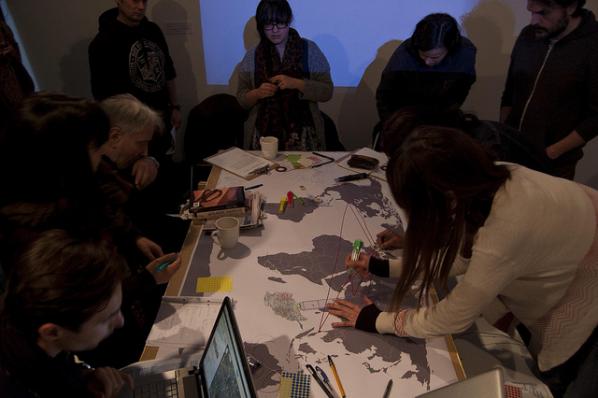
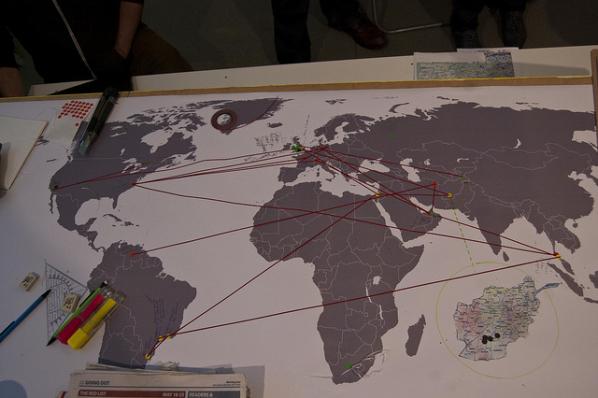
MG: What are the specific concerns you have regarding the development of drones and how do you think these conditions can be changed for the better?
DY: This is a question I was more sure of before I started the workshop series – I feel the more I’ve gained an understanding of the way they’re used, the less sure I am of what needs to change. I see the drone as a symbol for the way conflict is understood post 9-11. It is part of the language, aesthetics, and transnational politics of the War on Terror. What is most concerning to me is the idea that the drone allows a state to fight a war while apparently sidestepping the otherwise necessary apparatuses of legality and oversight. As a covert weapon, it can be implemented in exceptional, extra-judicial ways that have not been legislated for as yet. The “targeted strike” and “signature strike”, while distinct from each other in protocol and circumstance, are particularly problematic – the former amounts to what many journalists describe as an assassination, although this word is rejected by the US government.
The CIA Torture Report released at the end of last year was an important acknowledgement of institutional subversions of legal and moral codes. I’d expect that a similar report into the use and effects of military drones would create space for an informed public debate about how they might be used in the future.
MG: Regarding you own relation and interests around drone and military culture, what are your plans in the near future?
DY: The outcomes of The Reposition Matrix have led me to approach this issue in a different way, looking for alternative ways of instigating conversations around this difficult subject. I’m still quite occupied with issues around the collection and presentation of data – during the workshops we covered a lot of diverse subjects, but always situating research outcomes on the surface of a world map. The question for me right now is what information is important to work with, and how can it be usefully represented? I’m looking at alternative methods of “mapping”, perhaps based in mapping technologies/software but using them in more disruptive non-geographic ways. I’ve been quite inspired by Metahaven’s ‘Sunshine Unfinished’ and the recently published book ‘Cartographies of the Absolute’ – both works have brought me back to some possibilities that went unexplored in the initial run of workshops back in 2013.
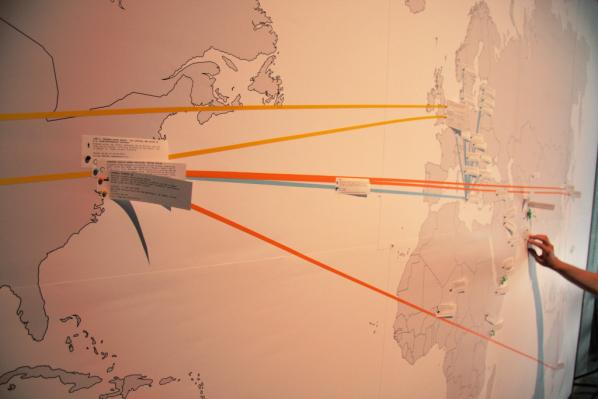

MG: What other projects are you involved in?
DY: Aside from this research, I’m currently collaborating on a project titled “Cursor” with Jake Watts and Kirsty Hendry as part of New Media Scotland’s Alt-W fund. We’re investigating current trends in fitness tracking technologies, and attempting to uncover and critique the way such intimate personal data is produced, distributed, and commodified. You can follow our research as it evolves on http://cursorware.me
I’m also running a space here in Edinburgh called Localhost, with the aim of stimulating discussions around the political aspects of digital art/culture. I run regular workshops and more occasionally special events, but I’m also very happy to provide a platform for others who wish to share their thoughts & skills on related subjects. Check http://l-o-c-a-l-h-o-s-t.com/ for more information and how to get involved.
Thank you very much 🙂
Featured image: System Map by Andrea Crespo, 2015, image
Fear is easily attributable to a cause—we fear something in particular. Anxiety, however, can be described as fear without the source. Yet, anxiety is also a safety mechanism. Without it, we would walk in the face of danger. In the online exhibition Body Anxiety, curated by Leah Schrager and Jennifer Chan, the disquiet is experienced in the flesh, whether this is as a symptom or sublimation.
Whatever your gender, your body is politicised in ways you cannot control. If you are female, or gender queer, there is also a fight against power. The works in Body Anxiety specifically problematise the image of women in the media and in the art world. Women artists, they claim with good arguments, are powerless; sothe show gives time and space to a group of artists the curators call ‘female painters’. Even though few paint (in fact, probably only Schrager herself does), Schrager puts forward the argument of painting as the highest artistic form, one dominated my males. She recontextualises painting for this exhibition, where most artists use their own bodies as canvases for video performances, sound works, photographs and writing. Perhaps this is peinture féminine to Helene Cixous’ écriture féminine.
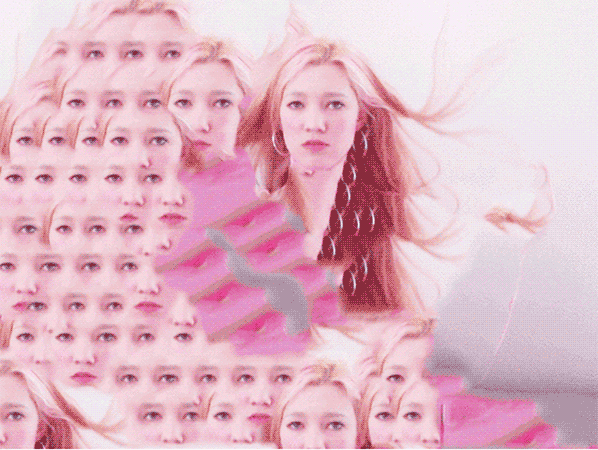
Good examples of the symptomatic are Victoria Campbell’s The Penelope Files, an auto-interview video with a reflexive sound monologue where she explores her thoughts on images of herself while browsing through her computer files. We hear her; we only see the screen. Exploring her relation to image, authorship, labour and the body, something about photography is revealed in the repetitive moving of files on her desktop’s finder window. Narrative also inhabits the work of Randon Rosenbohm. She presents a scan of a handwritten diary entry where artistic labour, exploitation and male artists feature. Her other work consists of a tumblr blog of rejected selfies. Both are pieces we should not see. This is also the case in Ann Hirsh’s video. Dance party just us girls shows footage that should be for private consumption, part of a home video, a laugh, documentation of a personal exploration. Using generic distorting video software available in most computers, the two-channel work shows the torso of a woman bobbing away to a song next to an image of moving genitalia, in a feminist version of Courbet’s painting The origin of the world. The two images share a pair of glasses and the genitalia is converted into a talking face, like in Denis Diderot’s libertine novel The Indiscreet Jewels.
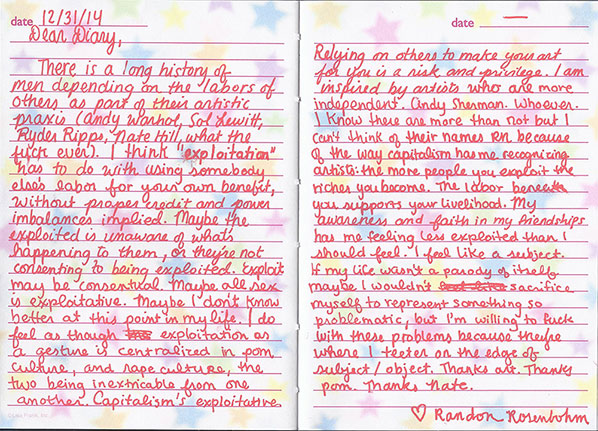
Saoirse Walls’ Den Perfekte Saoirse(2012) quotes Jurgen Leth’s The Perfect Human. She replicates some of the famous body poses and music from the classic black and white film, showing us the best of her individual self in a sublimation. She can do a side crow, twerk, walk in heels and, thanks to camera tricks, have a 100% symmetrical face. The work gets more and more bizarre with the appearance of make up and hair extensions. Where has Leth’s serious exploration of perfection gone in her quote? What are we demanding of Saoirse Walls? Another good example of an impossible demand and how this conflict is shown in a work of art is Nancy Leticia’s video. Her youthful, gorgeous self plays piano in her underwear. She plays very well, but how does this relate to the image setting?
Screenshot of Den Perfekte Saoirse by Saoirse Wall, 2012, video, 2:22 mins
The writer Marie Calloway—an alt lit writer, also a female painter in the way Schrager intends—features in Rachel Rabbit White’s work A Story In The Shape Of A Selfie Of The Writer And Her Friend, Marie Calloway. Her writing with images addresses the issue of anxiety head on. ‘Refresh’, ‘refresh’, ‘refresh’, she writes at the end of a blog post-merging stories about Marie, public events, selfies, feminist writers and artists, and social media.
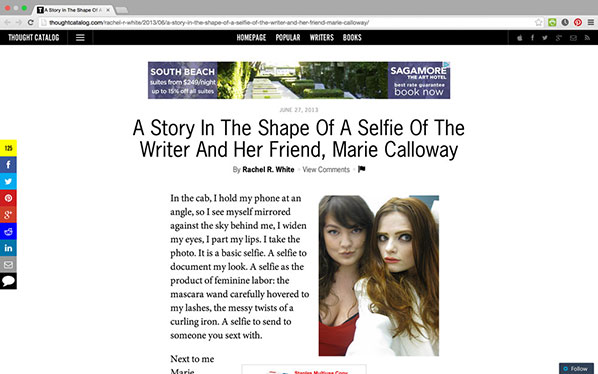
These diverse works are playful, at times irreverent, and certainly thought provoking. The curation is purposeful, direct and erudite. Yet, I have some issues with the display, with the sidebar prefaced by curatorial statements and with links to the artists’ biographies and websites. It feels more a catalogue than an exhibition. I don’t have a solution, though, as maybe this is a constraint of the medium. A few of the works are hosted on external websites—vimeo, red tube. Some of them even require passwords and this provokes a particular way of looking, a gaze, then a click, a search away from what is presented in front of us. I am an active viewer, often in the position of a Peeping Jane.
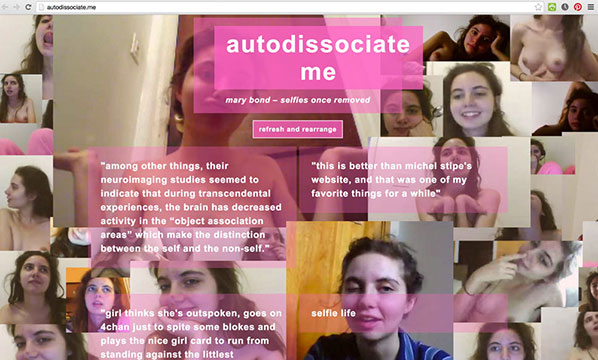
In her 1975 essay ‘Visual Pleasure and Narrative Cinema’ Laura Mulvey examines scopophilia, the pleasure in looking. This is not an innocent act. She argued that the relation between looker and looked is unequal in cinema, with woman as image and man as bearer of the look. If woman is a ‘one dimensional fetish’, as Mulvey writes (a thought which will be later echoed in Nina Power’s 2009 book One Dimensional Woman), the artists in Body Anxiety take this to its hysterical consequences, attempting to break the Master-Slave bond, making woman image AND bearer of the look. Let me return to the title for a moment. Anxiety, Sigmund Freud wrote, is neurotic fear, as distinct from real fear. So one is a reality, something tangible and worthy of our concern whereas the other sounds like is made up, accusation of fabrication (like hysteria). It is this last idea the show is trying to contend. The anxiety felt and displayed in these bodies, the imperative to conform to a certain standard and behaviour, the manipulation of femaleness in pornography, the shutting down of the woman’s voice are indeed neurotic, but not because of it they are less real. As a body of work, the exhibition is convincing and raises clear issues around female empowerment, agency and exploitation, and how these are linked to flesh. Converting the anxiety into an intelligible fear that can be stood up against, as these artists do, might be the first step towards overcoming it.
Featured image: Helen Varley Jamieson performing “make-shift,” Brisbane, 2012; photo by Suzon Fuks
“Overlapping and fluid spaces… spaces emerging between physical realities and the ethereal digital / electric space: a third space grafted from the real-time confluence of the stage + remote locations.” – Helen Varley Jamieson
Cyberformance artist Helen Varley Jamieson is creating a new Internet performance work, “we r now[here]”* for the Art of the Networked Practice | Online Symposium (March 31 – April 2). The title and description of the work poetically articulate her thinking on networked space (third space) as a medium for online theatrical experimentation: “‘we r now[here]’ is about nowhere and somewhere: the ‘nowhere’ of the Internet becomes ‘now’ and ‘here’ through our virtual presence.” (* Special thanks to Annie Abrahams who provided the title for the work: “we r now[here],” and to Curt Cloninger who inspired it.)
To set the “stage” for this new work, we discuss Helen’s pioneering achievements in the genre she has coined as cyberformance: the combination of cybernetics and cyberspace with performance. Helen has created a rich body of online theater work dating back to 1999, when dial-up modems were still the operable connection, long before Skype and Google Hangout became popular Web-conferencing tools. As one of the founders of UpStage, an open source platform for online theatrical presentation, Helen is a leading catalyst, researcher, director, and maker who for years has been reimagining the Internet as a global space for theater and performance.
****
Randall Packer: You coined the term cyberformance in the early 2000s after discovering the potential of the Internet as a medium for live performance. What were your first steps in rethinking live theater for ethereal, networked “third space?”
Helen Varley Jamieson: When I first started working with Desktop Theatre and experienced the intense liveness of our interactions despite being physically separated by thousands of miles, I understood that it was possible to feel a quite visceral sense of presence and real-time connection via the internet. We were improvising and performing in The Palace, a graphic-sonic chat application, and our audiences were mostly other “Palatians” – who weren’t always particularly interested in what we were doing. I began to think about how we could bring this work to a theatre audience, people who wanted to see a performance. The first time I tried this was at Odin Teatret in Denmark at a Magdalena Project festival, with a short performance that aimed to demonstrate the possibilities of cyberformance. Adriene Jenik and Lisa Brenneis from Desktop Theatre were performing with me from California, in The Palace which was projected onto a screen. I was using someone’s mobile phone for the internet connection as this was 2001 and there wasn’t internet throughout the building at that time. Afterwards, a heated debate erupted amongst the audience (who were theatre practitioners) about whether or not this could be called theatre. This experience challenged me to question whether or not cyberformance was “theatre” (which of course required first answering the question, what is “theatre”?): how is technology changing our definitions of “theatre”? and what place does cyberformance have within theatre?

RP: You define cyberformance as “utilizing Internet technologies to bring remote performers together in real-time for remote and or proximal audiences.” How does the distributed nature of cyberformance differ from live, traditional theater that situates actors and audience in a single, physical location?
HVJ: Obviously there are many interactions that are not possible, and the entire context is different: instead of sitting together in a darkened auditorium, hearing the rustles and breathing of your fellow audience members and smelling whatever smells, you are (usually but not always) alone in front of a computer. There are time and seasonal differences, as well as cultural and linguistic, for individual audience members. There might be a knock at the door or a phone call or other outside events that intrude on someone’s experience while online. So there is much more variety in how the performance is received than there is in a proximal situation. To give one example, during the 101010 UpStage Festival, one performer and some audience were located at a museum in Belgrade; it was the same day as the gay pride march there, which was disrupted by rioting anti-pride protestors, and the museum staff had to lock the doors to keep everyone safe – cars were burning in the street outside. Inside the locked museum, the performer kept going and the festival continued with the riot raging outside, and those of us online were getting updates about the situation from those in the museum.
There is also a different kind of relationship between audience and performers, at least in performances using platforms such as UpStage, where the audience have the possibility to chat with each other and with the artists. There is a level of familiarity and equality, as opposed to the separation of the 4th wall in traditional theatre. Different codes of behaviour apply – for instance it can happen that the online audience might start chatting about something unrelated to the performance, which then becomes a part of the performance; people seated in a theatre auditorium wouldn’t normally strike up a general conversation, audible to all, in the middle of a play. The response from the audience to the performance is in some ways more direct – they can comment in the chat and will often be very honest in their comments; and in other ways more distant – a standing ovation has to be typed into the chat, which is less of a loud emotional outpouring.
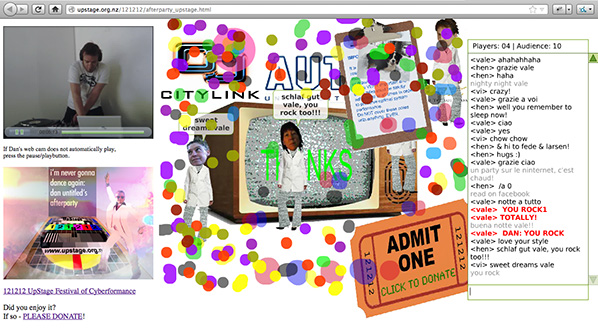
RP: I find it ironic that you named your performance group “Avatar Body Collision,” which seems to complicate the idea of net space as a virtual medium for disembodiment. How do you see “avatar bodies” colliding on the Internet?
HVJ: I don’t think of virtual space as being disembodied. We are still in our bodies, we are using our bodies to create the performance – primarily our hands and fingers (digits – we say “break a digit” before our shows instead of “break a leg”). The collision in the name is not about bodies colliding with bodies, but avatars colliding with bodies. Where does my body end and my avatar begin, and vice versa? And how do other bodies, e.g. the audience, respond to my avatar? The collision is one of flesh and technology, sweat and pixels.
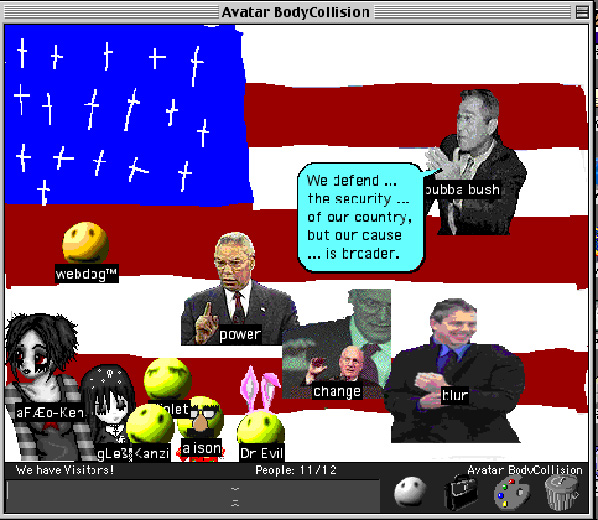
RP: Online, the audience or “cyberformience” plays a participatory role in the event, like the early Happenings from the 1960s. How does this non-hierarchical approach to theater impact the works you have created for the medium: how do you incorporate the audience into the work?
HVJ: It varies from show to show; some are designed for the audience to watch and respond, while others aim to actively involve the audience (cyberformience) to the point of co-authoring. One example at the first end of the continuum is “a gesture through the flames“, which was a webcam performance I created in 2008 for Annie Abrahams‘ “Breaking Solitude” series. I used a Victorian toy theatre and a soundscape to tell a story, and the online audience improvised a narrative in the chat. I didn’t interact with them during the performance (I was too busy to type) and it was fascinating to see how they read what I was doing. At the other end of the spectrum are works like “make-shift” or the series “We have a situation!” which can’t happen without the active participation of the audience. In “make-shift” (2010-12, with Paula Crutchlow), the audience were involved in writing texts, operating the webcam, answering quiz questions, building kites from recycled plastic, and ultimately performing on webcam. The event was structured so that they were “warmed-up” for their participation, and because we were located in someone’s home there was a very informal and comfortable atmosphere which made it possible for people to do these things.
RP: You are currently creating a new work entitled “we r now[here]” for the Art of the Networked Practice | Online Symposium. The title can be read as no(where) or now(here). Tell us about your concept of Internet space and time.
HVJ: Space and time in the online world are very fluid for me. I frequently work with people in different time zones, and travel physically between time zones myself as well, so I’m often calculating time differences and negotiating meeting times around all of this. In some ways time is irrelevant. In other ways, it’s highly significant – for example, precise timing is very difficult to achieve. Lag is unpredictable, sometimes it can disrupt a carefully planned sequence but at other times it can make something unexpectedly brilliant.
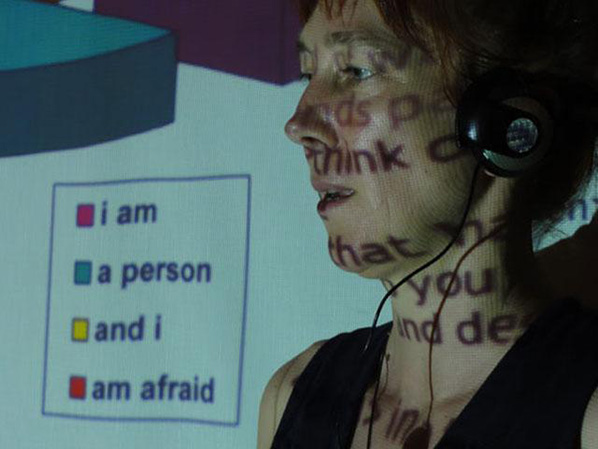
RP: A recent work, “make-shift,” unites domestic environments via the Internet in live, free-form conversation between online and onsite participants. How do you achieve a sense of intimacy and play in the online social space of the work despite geographical separation?
HVJ: I think of cyberspace as a space; apart from all the common spatial metaphors that are applied to it, when I’m working or communicating with people online in real-time it feels to me that we create a space through our shared presence, words, and whatever else we are using. It’s a space that extends into and absorbs a little bit of the physical environment of everyone present. “make-shift” did this very explicitly – we asked the audience (online and on site) to describe where they were, and this built a collaborative space or environment that everyone had a shared sense of.
In “make-shift” we created intimate and playful environments in two separate houses. the participants in the houses arrived half an hour before the show began, and during this time we warmed them up with a few activities and explained things about what was going to happen. Usually there was also food and drink, and often the people already knew each other so it was already quite friendly and informal. At the start of the show we began by introducing everyone. Each house called out a greeting to the other house and the online audience (which we’d practiced as part of the warm-up activities), and then we invited the online audience to tell us “what’s it like where you are?” This question was deliberately a bit open-ended, so people could describe their surroundings, the weather, their day, their mood and so on. The online audience are already seated at the keyboard and ready to interact; often they would make jokes, add other comments and respond to each other. We had regular online audience members who knew the format so inserted their own commentary or embellished others’. From this beginning, we continued throughout the piece to give the audience tasks that encouraged their sense of empowerment and ownership within the piece, such as operating the webcam, and we encouraged those in the house to interact in the chat with the online audience. Some people were a bit shy or worried about doing the wrong thing, but they usually got into it fairly quickly and became so involved in the piece that they lost any self-consciousness. In the final scene, the group in each house performed a song to the webcam and created a tableaux vivant of a painting we had referenced throughout the performance, and when we reached this point in the show they were always keen to do this.
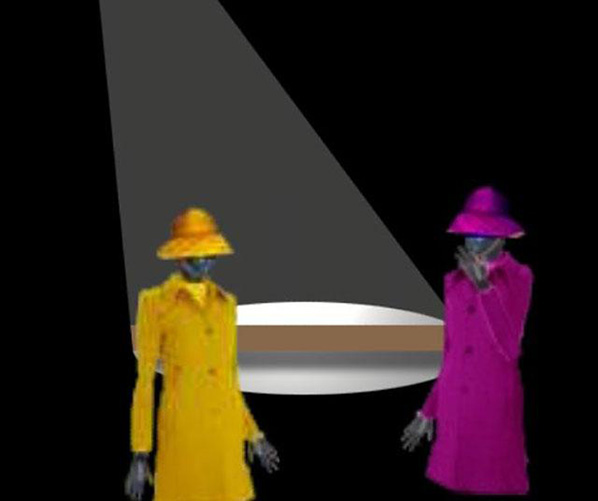
RP: With the Avatar Body Collision performance group, you have restaged Samuel Becket’s minimalist theater work “Come & Go.” Your approach to cyberformance has always been very free and open, and yet Becket is the opposite: highly structured with precise directions for actors. How do you reconcile these differences?
HVJ: It was a lot of fun to do “Come & Go“; from the outset we accepted that we had a strict set of instructions to follow, and made that our task – to render Beckett’s directions in cyberformance as faithfully as possible. So we didn’t reconcile those differences, rather we saw it as an opportunity to work differently for a change. We worked on small but precise avatar movements, which is harder than you might think, and used simple gestures that very effectively added emotion, such as a turn of the head or holding a hand up to the mouth. We played with the text2speech voices of our avatars: I was Flo, who at one point has the line, “Dreaming of … love”, and we discovered that the “…” created an emotional quaver in the computerised voice when it said “… love”. This was both funny and tender. So having a script and such precise directions meant that we spent time on details like this.
RP: You have produced your own online symposia, the Cyposium, the latest from 2012 culminating in CyPosium the Book, an edition of essays and transcriptions. How has your experimentation with the online symposium format altered your view of what a conference gathering can fulfill given global access via the Internet?
HVJ: The CyPosium was very successful and generated an exciting buzz. I think one reason for this was that everyone was online. When there is a stream from a proximal conference, it’s very easy for people at the physical venue to forget about those online. It takes very thoughtful planning to ensure that the online participants are fully included. So in the CyPosium, everyone was online and therefore equally included. Most people commented quite freely – at times it was quite dizzying to see the chat scrolling up at great speed, there was so much discussion. This made it quite difficult for the moderators to field questions – we had planned as best we could for this and it went pretty well, but there were so many people actively engaged in the discussion that at times we couldn’t keep up. Many people stayed online for most of the 12 hours, and the response was very enthusiastic the whole way through, which made it clear that there is a desire for this kind of event.
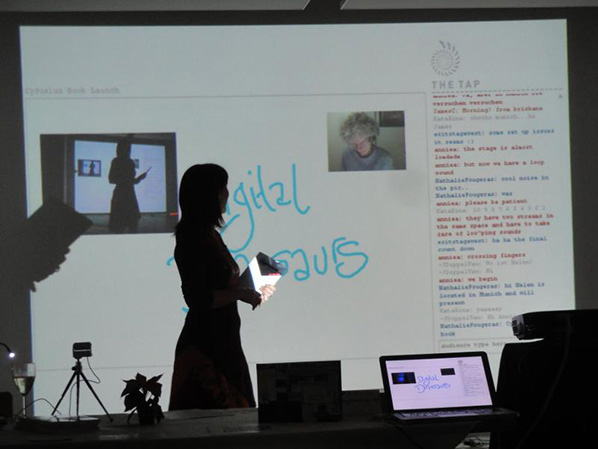
RP: In your years of performing and creating online performance, what do you think is missing in the liminal space of the online medium due to distance and non-corporeality? What do you yearn for? What do you still want to accomplish?
HVJ: At an absolutely practical level, I yearn for better funding, for funding opportunities that are not tied to geographical locations, as nearly everything still is. The distributed, non-corporeal and ephemeral nature of this work means that it’s always on the periphery – which in some respects is a wonderful place to be, but it’s usually the least-funded place.
There are many things that I imagine and would like to realise but can’t technically; some of these things may become possible if/when we manage the rebuild of UpStage that we are planning. But often what interests me most is experimenting with the resources I have and discovering what’s possible; what tricks or hacks I can do, what surprises there are when we push a technology in a way it wasn’t intended to be pushed or when we use a tool differently.
What I would still like to accomplish in my work is to further develop the intentions of shows such as “make-shift” and “we have a situation,” where a creative process shared by audience and artists can ultimately effect real change, at the individual level and socially/politically. I’m interested in how cyberformance can facilitate meaningful discussions and encourage people to think about alternatives and make actual changes in their lives. I’m interested in how connections between remote and apparently unrelated people and contexts can open up new possibilities.
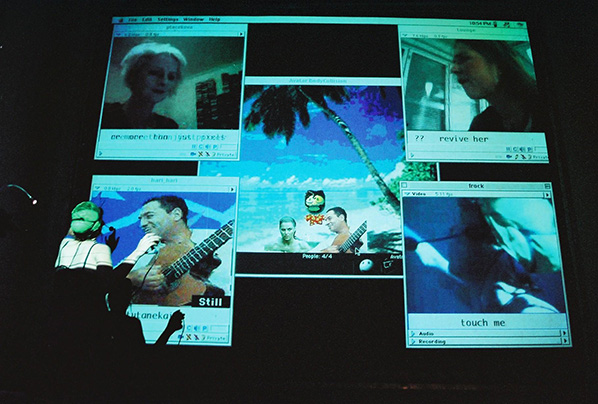
Mainframe Experimentalism
Early Computing And The Foundations Of The Digital Arts
Edited by Hannah B Higgins and Douglas Kahn
University of California Press, 2012
ISBN 978-0-520-26838-8
The history of arts computing’s heroic age is a family affair in Hannah B Higgins and Douglas Kahn’s Mainframe Experimentalism. Starting with the founding legend of the FORTRAN programming workshops that one of the editors’ parents led in their New York apartment in the 60s, the book quickly broadens across continents and decades to cover the mainframe and minicomputer period of digital art. Several of the chapters are also written by children of the artists. Can they make the case that the work they grew up with is of wider interest and value?
The 1960s and 1970s were the era prior to the rise of home and micro computing, when small computers weighed as much as a fridge (before you added any peripherals to them) and large computers took up entire air conditioned offices. Mainframes cost millions of dollars, minicomputers tens of thousands at a time when the average weekly wage was closer to a hundred dollars. To access a computer you had to engage with the institutions that could afford to maintain them – large businesses and universities, and with their guardians – the programmers and system administrators who knew how to encode ideas as marks on punched cards for the computer to run.
Computers looked like unlikely tools or materials for art. The governmental, corporate and scientific associations of computers made them appear actively opposed to the individualistic and humanistic nature of mid-20th Century art. It took an imaginative leap to want to use, or to encourage others to use, computers in art making.
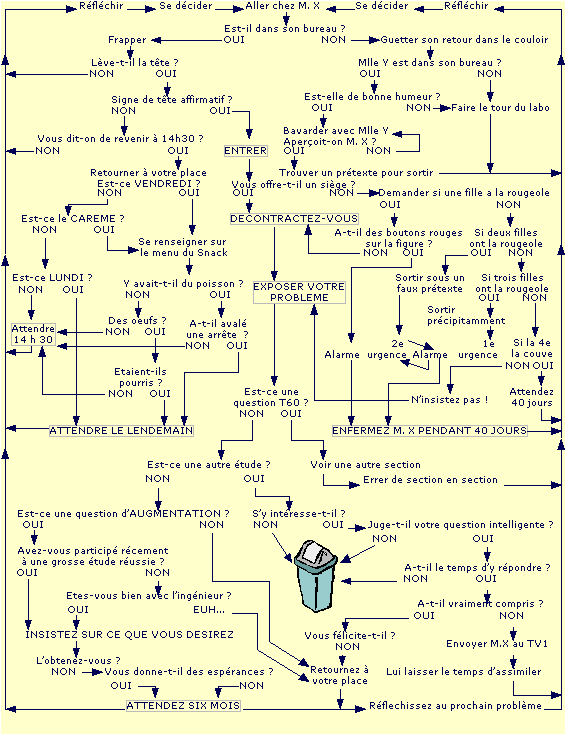
Flowchart for asking your boss for a raise, Georges Perec
Many people were unwilling or unable to make that leap. As Grant Taylor describes in The Soulless Usurper, “Almost any artistic endeavor(sic) associated with early computing elicited a negative, fearful, or indifferent response”(p.19). The idea, or the cognates, of computing were as powerful a force in culture as any access to actual computer hardware, a point that David Bellos makes with reference to the pataphysical bureaucratic dramas of Georges Perec’s Thinking Machines. Those wider cultural ideas, such as structuralism, could provide arts computing with the context that it sorely lacked in most people’s eyes as Edward A. Shanken argues in his discussion of the ideas behind Jack Burnham’s “Software” exhibition, an intellectual moment in urgent need of rediscovery and re-evaluation.
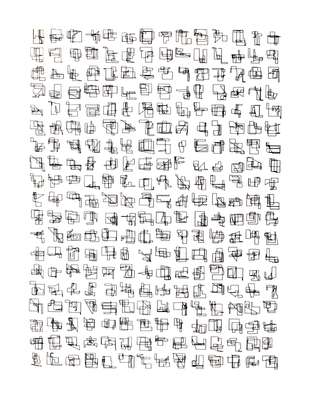
The extensive resources needed to access computing machinery led to clusters of activity around those institutions that could provide access to them. In Information Aesthetics and the Stuttgart School, Christoph Klütsch describes the emergence of a style and theory of art in that town (including work by Frieder Nake and Manfred Mohr) in the mid-1960s. In communist Yugoslavia the New Tendencies school at Zagreb achieved international reach with its publications and conferences as described by Margit Rosen.
Charlie Gere’s Minicomputer Experimentalism in the United Kingdom describes the institutional aftermath of the era that is the book’s focus. Like Gere I arrived at Middlesex University’s Centre For Electronic Arts in the 1990s with the knowledge that there was a long history of computer art making there. Also like Gere I encountered John Lansdowne in the hallways and regret not taking the opportunity to ask him more about his groundbreaking work.
Perhaps surprisingly, music was an early aesthetic and cultural success for arts computing. The mathematics of sound waveforms, or musical scores, were tractable to early computers that had been built to service military and engineering mathematical calculations. In James Tenney at Bell Labs, Douglas Kahn makes the case that “Text generation and digitally synthesized sound were the earliest computer processes adequate to the arts” (p.132) and argues convincingly for the genuine musical achievements of the composer’s work there. Branden W. Joseph places John Cage and Lejaren Hiller’s multimedia performance “HPSCHD”, made using the ILLIAC II mainframe, in the context of the aesthetics and the critical reactions of both, and considers how the experience may have influenced Cage’s later more authoritarian politics. Cristoph Cox, Robert A. Moog and Alvin Lucier all write about the latter’s “North American Time Capsule 1967”, a proto-glitch vocoder piece that, as someone who is not any kind of expert in that area, I didn’t feel warranted such extensive treatment.
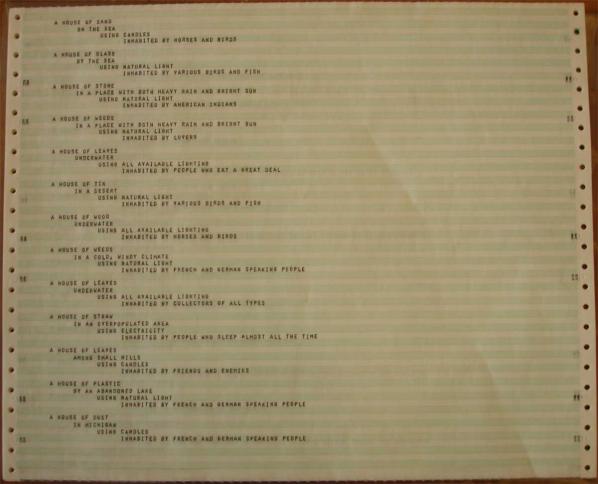
Hannah B Higgins provides An Introduction To Alison B Knowles’s House of Dust, describing it as “an early computerized poem”. It’s a good poem, later realized in physical architecture, and given extensive responses by students and other artists, that helps underwrite the claim for early arts computing’s cultural and aesthetic significance. Benjamin H.D. Buchlock describes the cultural and programmatic construction of the poem in The Book of the Future. And to jump ahead for a moment, a later extract from Dick Higgins’ 1968 pamphlet “Computers for the Arts” explains the programming techniques that programs like “House of Dust” used.
I mention this now because of the way that the extract of Higgins’ pamphlet contrasts with the version published in 1970 (available online as a PDF scan that I would urge anyone interested in the history of arts computing to find and study under academic fair use/dealing). Mainframe Experimentalism includes many wonderful examples of the output of programs, and many detailed descriptions of the construction of artworks. But the original of “Computers for the Arts” goes beyond this. It includes not just a description of the code techniques but a walk-through of the code and the actual FORTRAN IV program listings. Type these into a modern Fortran compiler and they will run (with a couple of extra compiler flags…). For all the strengths of Mainframe Experimentalism, it is this kind of incredibly rare primary source material that we also need access to, and it is a shame that where more was available it couldn’t be included.
Three Early Texts by Gustav Metzger on Computer Art collated by Simon Ford gives the reader a feel for the intellectual zeitgeist of arts computing at the turn of the 1970s, one that might surprise critics then and now with its political literacy and commitment. William Kazen brings Nam June Paik’s lesser known computer(rather than television)-based work to the foreground while tying it to the artist’s McLuhanish hopes for empowering global media.
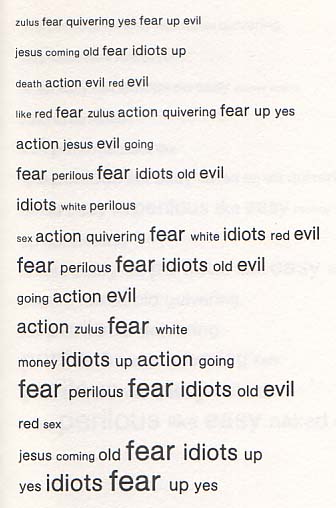
Knowles’ poem isn’t in the section on poetry (it’s classified as Intermedia), which begins with Christopher Funkhouser’s First-Generation Poetry Generators: Establishing Foundations in Form. Funkhouser gives an excellent overview of the technologies and approaches used to create generative text in the mid 1960s, providing a wonderful selection of examples while tracking pecedents back through Mallarme to Roman times.
In Letter to Ann Noël Emmet Williams explains the process for creating a letter expanding poem that had been recreated on an IBM mainframe. Like “House of Dust” it’s an example of computer automation increasing the power of an existing technique for generating texts. Hannah B Higgins’ The Computational Word Works of Eric Andersen and Dick Higgins draws a line out of Fluxus for the artists’ Intermedia and computing work. Eric Andersen’s artist’s statement describing the lists of words and numbers used to create “Opus 1966” shows both the ingenuity and intellectual rigour that artists brought to bear on early code poetry. The inclusion of Staisey Divorski’s translation of Nanni Balestrini’s specification for “Tape Mark I” provides an example of the depth of appreciation that prepraratory sources can provide for an artwork. Mordecai-Mark Mac Low describes how his father took ideas from Zen Buddhism and negotiated the technial limitations of late 1960s computing machinery to realise them in poetic form in The Role of the Machine in the Experiment of Egoless Poetry: Jackson Mac Low and the Programmable Film Reader.
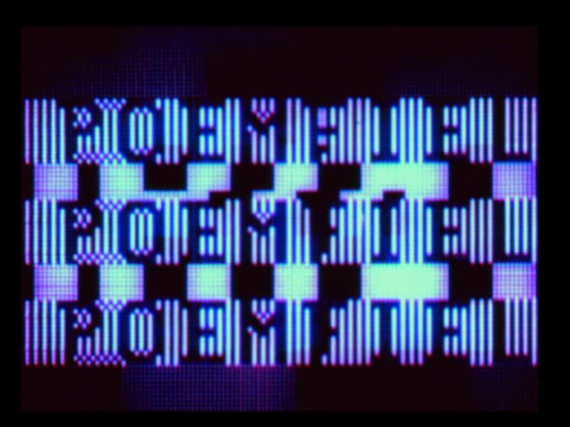
Finally, Mainframe Experimentalism turns to cinema. Gloria Sutton casts Stan VanDerBeek’s “Poemfields” in a more computational light than their usual place in media history as experimental films to be projected in the artist’s MovieDrome dome. Ending where a history of the ideas and technology of arts computing might otherwise begin, Zabet Patterson describes the triumphs and frustrations of using World War II surplus analogue computers to make films in From The Gun Controller To The Mandala: The Cybernetic Cinema of John and James Whitney. It’s a fitting finish that feels like it brings the book full circle.
I mentioned that several of the essays in Mainframe Experimentalism were written by family members of the artists. A number of the essays also overlap with their coverage of different artists, or describe encounters or influences between them. Arts computing was a small world, a genuine avant-garde. We are lucky not to have lost all memory of it, and we should be grateful to those students and family members who have kept those memories alive.
In “Computers For The Arts”, Dick Higgins describes two ways of generating output from a computer program – aleatory (randomized) or non-aleatory (iterative) ways. Christopher Funkhouser and Hannah B Higgins’s essays also touch on this difference, but forty years later. This is key to understanding computer art making not just in the mainframe era but today. Computers are good for describing mathematical spaces then exploring them step by step or (psuedo-)randomly, and whether it’s an animated GIF or a social media bot you can often see which of those processes is at work. It’s inspiring to see such fundamental and lasting principles identified and made explicit so early on.
Away from the era of the “Two Cultures” of science and the humanities, and of computing’s guilt by association with the database-driven Vietnam War, the art of Mainframe Experimentalism rewards consideration as a legitimate and valuable part of art history. Not all of it equally, and not all of it to the same degree – but that is true of all art, and cannot be used to disregard early arts computing as a whole. This aesthetically and intellectually under-appreciated moment in Twentieth Century art is crying out for a critical re-evaluation and an art historical recuperation. Mainframe Experimentalism provides ample examples of where we can start looking, and exactly why we should.
The text of this review is licenced under the Creative Commons BY-SA 4.0 Licence.
Trans-gender theorist Jami Weinstein has compared the flocking behaviour of academics and artists around the concept of The Anthropocene, to the adoption by the Hipster of a given locale or fashion appendage. The creative flock, she suggests, can perform a gentrification of concept through uncritical adoption and ‘hyper-consumption’, just as it does of neighbourhoods or workwear. The Anthropocene is indeed the place to be seen, or the guise in which to dress the body of your work, this season. The term is proposed as a way of describing the explicit ‘age’ in which human kind, post-1945 (although possibly since the Industrial Revolution, or stretching right back to the advent of tool use), has come to define the geophysics of the entire earth.
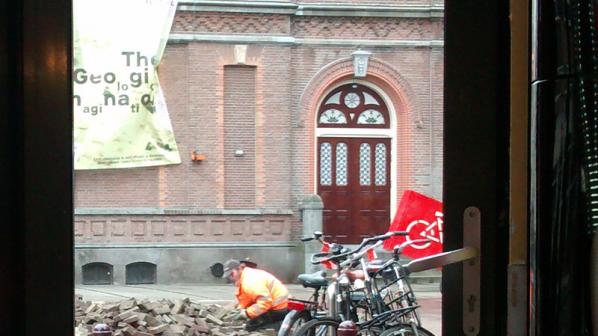
The Anthropocene, combining geology with sociology through a few slights of hand, therefore collapses the distinction of human and nature which is core to basic understandings of our being in the world. If this wasn’t enough, an immanent vote affirming the accuracy of the term The Anthropocene by the scientific community worldwide has also been touted as a gesture which will provide the rhetorical turning point by which the Western powers will acknowledge, and begin reparations for, the ecological sins of the past, potentially saving the human race from mass extinction. Fertile ground then, for readings, interpretations and responses – but as Weinstein suggests, there is a deeply complex responsibility implied when we approach and engage with something as ontologically vulnerable as a concept.
It is this responsibility Sonic Acts assumes when it takes The Anthropocene as its central theme. The four day music festival and conference takes a collection of essays titled The Geologic Imagination as a gathering point for a strong line-up of some of the most influential men working across philosophy, music and the arts today. I attended the first day of the festival, which included a talks and a round-table by Object Oriented Ontologists maverick Graham Harman and his icemanTim Morton, geologist Mark Williams, and art theorist Douglas Kahn, followed by a performance/installation by Florian Hecker featuring work by Reza Negarestani, and a night-time programme of music by M.E.S.H and TCF, Vessel, and finally, as if from outer space, the sole female agent of the programme, Karen Gwyer.
I use the term agent, to distinguish from ‘appearance’ or ‘voice’, because there were several female bodily appearances and women’s voices in evidence onstage during the conference and club. The problem was that they were routinely either denied the right to articulate their own words, for example when The Geologic Imagination editor Mirna Belina was reduced to acting as an interlocutor for Lukas Marxt during a poorly thought out artists presentation section; or worse, used as sound/image material to be cut into, destroyed, and literally degraded for surface affect by male artists. Example of this included the snippet Kurt Hentschläger showed of his work Modell5, during an inexplicable tour of his online portfolio – and the violent envelope-ing of Charlotte Rampling’s vocal performance in Hecker’s audaciously dense new materialist sound opera Script for Machine Synthesis. Certainly none of these phenomena may have stood out as malicious in themselves, but in the context of a festival whose line-up consists of 75 men and only 7 women, and whose female curators are entirely absent from the staged elements of the show, a motif in which women’s bodies and voices are a pretty fabric to be torn and disabused begins to gain the qualities of something else entirely. The ‘glitch’ too must take into account its gender dimension.
This unfortunate gender play reached its misogynistic anticlimax during the closing stages of the club event as the trashy, industrial techno of Vessel was backed by a huge split-screen visual (film created by Pedro Maia) of a woman crying in a bathroom, lying in a corridor naked, kissing another woman in a body bag, and finally being pulled limb from limb in an ambiguous mix of sex-scene and analogue-digital disintegration. What does the complicity and collectivism of a rave space do with images/sound combinations like this when they are conducted by men?
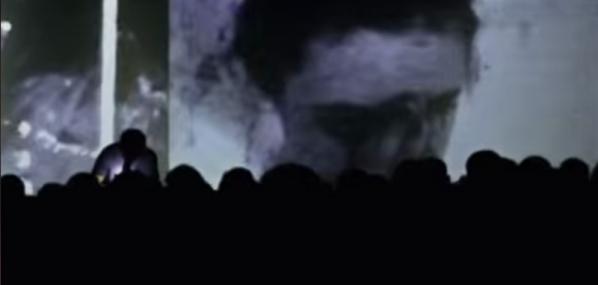
Early in his presentation, delivered with Tedtalk panache, Tim Morton used the fact that literary theory reads gender into texts even when they do not ostensibly mention gender, as an analogy for the way OOO recognizes that objects often ‘withdraw’ from us some core aspect of their being. As Morton affirmed, the Anthropocene is itself a “subcendent” object, being ‘much less than the sum of its parts’ – its parts being of a scale and complexity which must necessarily withdraw from us in order that the concept-as-object here can be revealed. This is explicitly not to infer that the concept-as-object can be emptied of its cultural and social identity and worn with Nikes like a naval overcoat, but rather that it requires a subtle and supple mode of thinking which is capable of excavating ‘that which withdraws’. The gender comment then, was prescient – directly illustrating that the curators, Lucas van der Velden and Annette Wolfsberger undermine the moral agenda of their project by failing to consider, or dismissing, the gender dimension. It might have been a calculated risk, that by not paying attention to gender during their deliberations they might elide that concept altogether from the consideration of the festival, but I think that when a risk backfires like this, the result should be called out for what it is – misguided and arrogant. At times, it felt like rather than proposing ways in which we might retreat from rampant, destructive territorialisation of the Earth, the festival projected a future in which the masculine regime of ownership and domination as ruinous could be helpfully extended and repeated onto womanhood as well – with all the faulty binarism and barbarism that implies.
The one audience question of the day, delivered from under a spotlight and with the barely subdued fury which gave him the air of Rasputin. His question, directed at Harman and Morton, I think picked up on some of the air of hypocracy of the event, but concerned the application of OOO specifically, and its relationship to Accelerationism. As my friend put it, “OOO qua Accelerationist gateway drug”. Needless to say, the question was expertly fielded and evaporated almost without trace.
Despite the regularly fascinating philosophical and cross-disciplinary gestures being made across the discourse/music strands, then, Sonic Acts was articulate through the voices it chose to exclude.
Not that the work itself, or the conversations happening across the theoretical and art strands was insubstantial. For example the way in which electronic artist TCF’s sound work performed the ontological flattening of objects as diverse as a helicopter, a computer circuit, and a Euro-house drop reflected brilliantly on the ideas proposed by Harman, Kahn and Morton, and gave a very tangible way of understanding the new materialist connotations of all. Another highlight included the Reza Negarestani double-bill, in which his notion of the incompatibility of given systems and the resulting philosophical imperative for ‘mixed-level reconfiguration’ through analyzing as both ‘that we can perceive’, and ‘that which we know’, for example, was first purposed as philosophical libereto, and then delivered as an almost equally dizzying Skype lecture.
During the deeply cerebral and attention-demanding ‘Script…’ performance, in which the audience were all seated on the floor, someone tall in mirrored sunglasses did a Jameroqui type dance while people filmed him on their mobile phones.
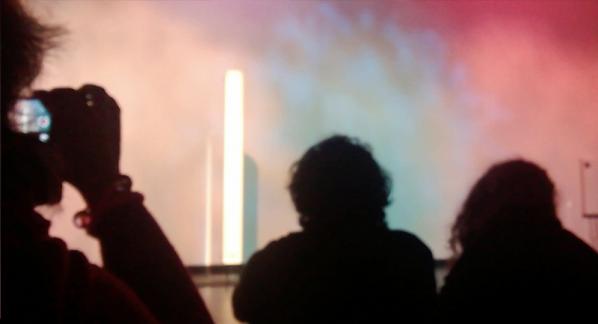
In Script for Machine Synthesis, (and previous works, such as Chimerisation) Florian Hecker has found in Negarestani’s philosophy a fantastic foil for his ‘dramatization of auditory synthesis’. Script used the motif (and the ‘occasion’) of a melting pink ice cube to enact a simultaneous synthesis and dematerialisation, bringing audio and scent (a specially commissioned perfume by Editions De Perfumes ‘materialised into a rubber trophy presented to each audience member in a foil envelope which made me think of space rations) into play as operators in the field of deconstructing the object-as-concept.
As an audience member completely new (but predisposed) to Negarestani’s work, following this hour-long performance with a lecture via Skype in which he laid out a the chiasmic twisting across neurological-phenomenological and mathematical-physical poles of experience and knowledge, led to a dizzying sense of having been teleported and improperly put back together.
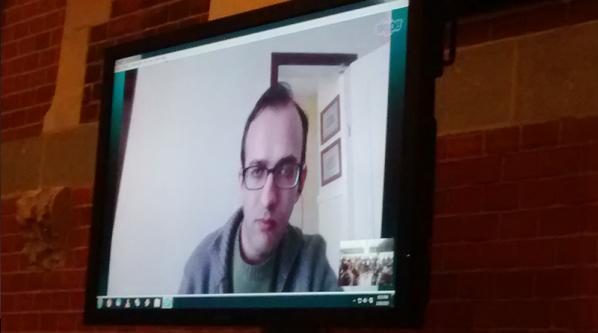
But, despite of these admirable folds in the art/thought continuum, it was impossible to shift the unnerving sense of hypocracy and lack of critical rigour at play in Sonic Acts programming. To return to the central unspoken chimera: The Anthropocene is gendered. In its simple form, it refers to a catastrophic situation resulting from the actions of a patriarchal Western society, and the effects of masculine dominance and aggression on a global scale. This was this subject in withdrawal which dominated my experience – meaning that a curatorial oversight not to include women, presumably in order to include more ‘famous’ names from these male-dominated spheres, was allowed to resonate and mutate into an experience of pervasive, almost hedonistic, misogyny I experienced during the Vessel performance.
The notoriously affluent European festival circuit benefits from a dense network of national and EU funding schemes, coupled with the neoliberal ease of intra-continental transport, cheap flights etc., and leverages this in an arms-race of fees for a mostly-male mostly-white cohort of mostly-electronic music artists. This context, plus that of the ‘lavishly illustrated’ book of essays which sets the scene for this year’s Sonic Acts, and the mode of staging in which the expert-community of the audience was silenced from contributing, in favour of a series of pronouncements from master-rhetoriticians, seems to me in direct opposition to the kind of ‘challenge to the status quo’ and subsquent reversal of the Earth’s fortunes which was frequently advocated for. The blurb for The Geologic Imagination does in retrospect seem to revel in the kind an uncritical adoption of concept Weinstein critiques, making of ecological disaster mere concept for further consumption:
“This new publication by Sonic Acts is inspired by geosciences and zooms in on planet Earth. Fundamental to The Geologic Imagination is the idea that we live in a new geological epoch, the Anthropocene. (!) Human activity has irreversibly changed the composition of the atmosphere, the oceans, and even the Earth’s crust. (!) Humanity has become a geological force. (Huzzah!)” [Exclamations mine.]
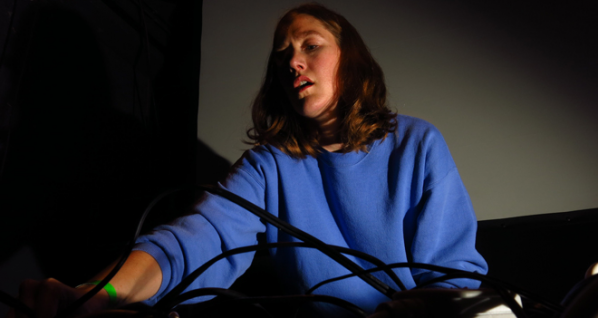
Finally, Karen Gwyer’s techno set – devoid from any descernable link with the festival themes, and so in a way also silenced somehow. But nonetheless, experienced like finally being able to breathe. The bass subdued among a mesh of pulsating synth and crystalline threads. Tim Morton’s frenetic big-box-little-box dance moves notable in the throng, somehow saying something indiscernible but very real, about the opportunities missed by this most-preeminent of European festivals. As Gwyer herself notes, in an interview not at all about the Anthropocene: “those forces have testicles.”
[imgs Jon Davies]
[Trigger warnings for just about everything goes here. Please Do Not Read the following if you’re sensitive, or concerned about trigger(ing)s.]
“An uproar of voices was coming from the farmhouse. They rushed back and looked through the window again. Yes, a violent quarrel was in progress. There were shoutings, bangings on the table, sharp suspicious glances, furious denials…Twelve voices were shouting in anger, and they were all alike. No question, now, what had happened to the faces of the pigs. The creatures outside looked from pig to man, and from man to pig, and from pig to man again; but already it was impossible to say which was which.”
– George Orwell, Animal Farm.
Today’s online spaces are communication minefields. When interacting in multiplayer games or social media niches, networks come drenched in reactivity bile. And although we might seem to bile-dilute, instead we intellectually saw at each other through a polite veneer. Here, civil discourse is label-trotted. Discourse bile may also erupt in balls-to-the-wall screaming matches. Such bouts involve trollbaiting, d0xxing, and Internet Rage Machine power-ups. Whatever the magnitude/form, online dialogues appear to be flooded with antagonistic commentary.
Truncated attention spans rage-burst. Such anger pockets are far from static: fuelled by such shameblood, the righteous degrade. We humiliate in order to inflate. We confront-tar and belittle-feather. The [s]urge for relevancy is sycophantically baked. We mobilize to unearth, to finger-point: we present affectivity as fact. Hate groups spread across factions, divide-blurring.
The search for sodalities is constant. Nuances are fudged. Contexts are ignored. Catharsis mutates through a checklist that reduces, confines, and truncates. We are force-fed trauma anecdotes as reality fulcrums. Baggage is exposed in painful lumps. We are not consideration-encouraged: we are expectation-drilled. We must agree. Must acquiesce. Must uncritically support. Anything else denunciation-equates.
Public shaming is the norm. We bully. We armchair-critique. Bipartisan voices lynchmob-morph, all-indignation-like. Roughshodders censor and context erase. Power drugs the inflamed and injects the underdog[s] with sudden shifting surges. Reference frames are smashed, then reiterated repeatedly till they become a thing of horror, of replication thrown from “side a” to hit “side b”. Such targets are then mirror-captured and magnified. Empathy is to be derided as weakness. Barbs are flung at all who seek to ponder “isms” or reclaim them. We must not listen in order to comprehend, to understand: we must shout.
We word weaponise [“…getting all soul-rapey on SJWs”/”…gut-cutting misogynistic neckbeards“/ “You are either with us or against us”]. Gator-screams and “die-cis-scum“-roars rule the day. We obliterate and issue-compress. We communication strangle. Equality is attainable through force. Aggression trumps assertion. Sarcasm blights compassion. Rudeness rewrites decency.
SUCH TERRIBLE WHITEWASHING SEALIONS

Power-grabs blind the sensitive. To destroy/troll/shame/swamp/embarrass/belittle/d0xx is to “win”. Sense of perspectives lose while extremisms gain. Dialogue is gamed: the loudest voices squash and rip, tear and silence. Threats echo the noose. Implications drive output. The end-goal is attention, ratification, dis[e]ruption: a pendulum power swing designed to flatten and redress. We obscure and vilify. We replicate exclusion ethics. We buck-and-doe-pass.
Online purging results in strange social crevices. Encouraged to instantaneously blurb our stream-of-tweeted-consciousness, we are off the chain. We spontaneity-bark and bleat [at] everything and all. Cohesion shatters. We no longer rely on institutions to dictate, to guide, to sanction. Moral Absolutists war-trawl Moral Relativists. The Arab Spring has turned us inside out. Unsure, we turn on each other. We emoji expose and deride. We [slut]shame and attack: all within banners born from psychologies spouting the benchmark worth of individualisation. Selfies become our egocentric standard.
We once attempted to codify, to restrain. But now, all gloves are off. We scrabble and lunge. We showcase-badge based on our version of “the categorical truth”. We bang and bleed against these corners, these intersections of emotion and intellect. Of private and public. Of control and openness. There is no room for reflection, for consideration, for clarity.
We refuse anything that calms. Online spaces are for battling. Playfulness and cohesion are sacrificed. Righteous mobs insult fling: they ratify rather than reappropriate. Alternates gleefully spout these insults as proof, stamp-ammo-ing all the while. There are, however, those who stay and observe. We await the wind-down. We desire an eventual dissolve: a fundamental shift. They can’t last, these discourse patterns. We wait for rage to course-run, for rage-fatigue. We await the next mediation bump.
The American artist Patrick Lichty is best-known for his works with digital media: as part of the activist group RT Mark and as designer of digital animation movies for their follow-up The Yes Men, he has been recognized as a net artist with a political bend. He has been working with digital media since the 1980s, and has created works with video, for the Web and for Second Life.
At his solo show “Artifacts” at DAM Galerie in Berlin however, the artist, who is teaching at the University of Wisconsin in Milwaukee and has recently published a book with theoretical essays, does not show media works, but tapestries.
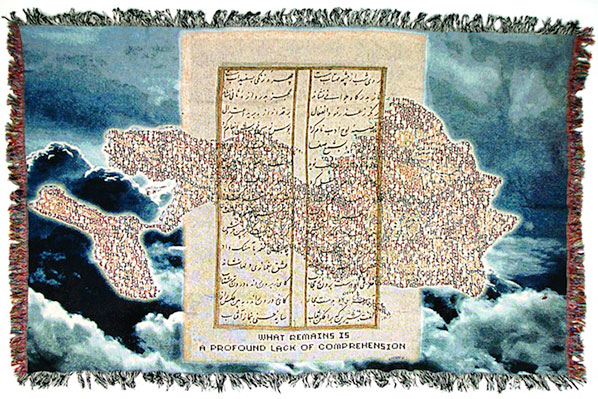
Tapestries? In the following interview Lichty talks about his return to traditional art techniques.
Tilman Baumgärtel (TB): Patrick, you are known for your work with media, and you have created 3D animations, Internet and Second Life works. But at your recent shows both in Berlin and New York you show works in much more traditional artistic media: drawings in New York, tapestries in Berlin. Why the return to these time-honoured modes of production?
Patrick Lichty (PL): I’ve been sitting in front of the screen for almost 30 years, and I’ve been blind several times in my life. This leads me to my belief that, “Mediation is reality.” I have artificial lenses, and I don’t know whether I see the world as it is. I feel like I have this cyborg vision, like I am slightly alien. I’ve had this feeling all my life.
So on the one hand, I have tried to create an alternative reality through mediation, or maybe to see the world for what it is through mediation. That is what happens with the Yes Men for instance: I am helping Mike and Andy to create alternative realities for our fictitious corporate campaigns. And on the other hand I am interested in what Marcus Novak from University of California Santa Barbara calls “Evergence” where virtual things that never existed except in the virtual manifest in the physical. It is almost like William Gibson’s novel “All Tomorrow’s Parties”, where the “printed” virtual J-pop idol Rei Toei idol jumps out of the nano-replicator, and says “Hello”, even though she never existed. I am interested in the tangible digital that manifests from the potential virtual…
TB: The tangible digital?
PL: Well, the idea of taking code, and turning it into 3D-objects, or taking things from Second Life and creating artifacts, and I use the US spelling as a double reference to “artifacting” or pixelization of an edge. The whole show here in Berlin is meant to introduce people to this gigantic body of work that I created in the realm of the digital as a cultural explorer, and that the contemporary art world doesn’t know much about, a bit at a time. What we have in the show are artifacts based on some of my more art world-friendly works. Some of my other pieces are definitely not art-world-friendly. I have done tons of prints and tons of video, that can be presented in a show, but a lot of my web work utterly and completely resists any kind of exhibition.

In the show in New York I have ten Roman-Verostko-like plotter prints of random internet cats, which is sort of my answer to post-internet art. By the way, you know what sold? The kitten swatting at the drone flying over it.
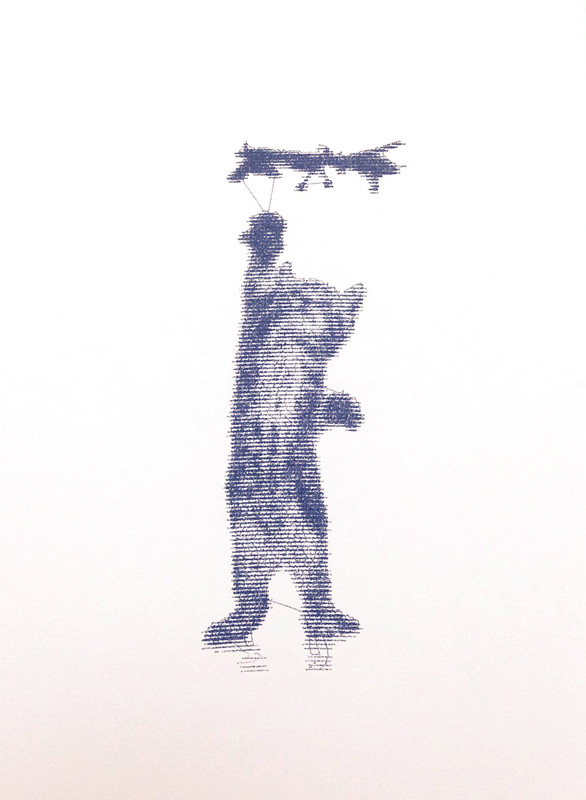
TB: How did you pick the motifs for the tapestry that is on display here in Berlin?
PL: This images come from certain key points in my practice in the last ten years. I send these files to a mill in South Carolina, and they fabricate the tapestry based on my image. These images are the ones that resonate with me very strongly. There is one that is called “Orange Alert”, which has the Space Invaders from the computer game attacking the White House, that I translated into this huge tapestry. It is based on a painting that his since been destroyed, and I think it is actually more interesting that way. We used to have this color code system in the US. “Orange” meant “You better be really scared”, and “Red” meant “You can kiss your ass good-bye.” Five years after 7/11, all the airports in the US were on Orange Alert, and nobody cared.
TB: Weaving was among the first crafts that were mechanized, and the mechanical looms were among the first machines that were controlled with early forms of punched card that in the early days of computing were the first form of memory storage. Is that the reason why you translated these images into tapestry?
PL: On the one hand I am referring to the old, grand art of tapestry weaving, and, maybe, playing a little bit to the gallery. It is a way to express the digital in a very certain kind of materiality that I find interesting and that is historically relevant to our heritage. They are simply a beautiful way to express digital content. And they are easy to display.

TB: The next thing we know is that you will be sitting on the loom again, rather than having these tapestries made for you…
PL: Well, I did that as a child. My mother was an artist and I worked on a loom with her. So there are specific incidents in my life that logically led me to create this work. I am not doing it, because it is hip, or cheap…
TB: …or could be shown in a gallery…
PL: No. There have been specific moments in my life that lead me to this, it was not merely a gallery move, although it made things easier.
The other thing that I am doing is that I am starting to place Augmented Reality on them, but that is not in this show. With the other Augmented works, like my Kenai Tapestry, you can take a device, bring up an app, and you look at it through the device, which recognizes the piece and then the virtual content comes out. The only piece like this in the DAM Berlin show that is like this is one piece that has a QR code on it that just says http:// and it sends you to a 404-error page. It is a Jodi-like piece. I don’t have to keep a server. It is something that actually does engage with technological devices, but I do not have to do this horrible upkeep.
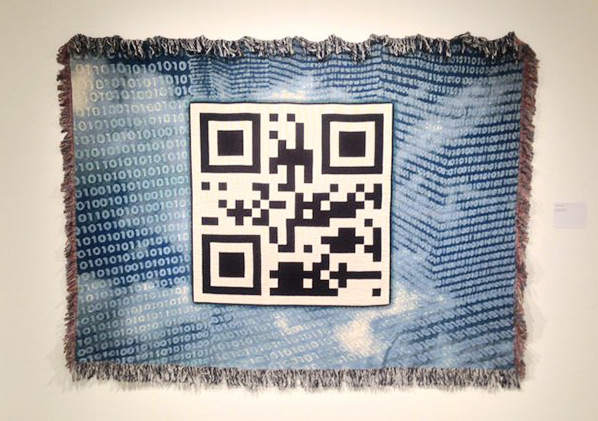
I did a piece called “Grasping @ Bits” in 2000 for which I got a honourable mention for the Golden Nica at Ars Electronica. It was this terribly complex hypertext-essay with hyper browsers and multiple reading paths, that had to do with activism and net art. I did this 15 years ago, and it is almost broken. Unless QR codes become totally defunct, I hope the 404 piece will work for a long time. We still have barcodes after how many years?
TB: In the 1990s, people were thinking that we would somehow upload ourselves into “cyberspace”, as in the “Matrix” movies. What seems to happen now is exactly the opposite: The virtual seems to re-materialise by manifesting itself in physical space, via 3D printers, smartphones etc.
PL: Instead of “The Matrix” it is more like in “All Tomorrow’s Parties” or “The Diamond Age”, in which we have machines that turn everything into what Bruce Sterling refers to as “gomi” or clutter/trash in Japanese. We have this whole explosion of digital content becoming physical again, but to quote Sterling again, most of them are meaningless technical exercises, or “Crapjects”.
This whole issue of re-materialization and corporeality from media to physical objects is of growing importance to me. We are made of material/flesh (points to his arm) rather than this (points to a computer). Moravec hasn’t come true yet; we are not uploading ourselves anytime soon…
I had a phase around 2005, where nobody heard from me much for a year or two because I wanted to reconcile myself with material. I didn’t do much media art, it was mostly material practice. That was when I started to work with iron casting and weaving. I have been interested in the Jacquard loom and 3D printing since 2004, but I am only showing much of that now. I did a 3D representation of a gif in 2005, where the black and white value determine the height of the different pixels. White is high, black is low. I had that cast in iron. It is from a series called “8 Bit Or Less”, that reflected on my blindness. I took samples from the different series of my work and experimented with translating them into a physical form. The idea is that mediation becomes physical reality, and the format of this show is a survey of various works. I thought that was the most logical way yo introduce people to a substantial body of work quickly but in an accessible way.
TB: Let’s talk about your involvement with groups like RTMark, the Yes Men or Second Front. You said that you were interested in creating alternative realities. Was that the reason why you ghelped create these groups?
PL: I have always been a leftist, who – ironically – tries to survive on his work. That´s why I was attracted to the anti-corporate bent of RTMark and the Yes Men.
A little bit back-story is in order here: Imagine an electrical engineer raised by artists and then taught how to do Critical Theory by Ph.D.s in Sociology and Theatre History, and what you get is me.
I actually worked an electronic engineer for a while, and did not go to art school until I needed a degree to be an academic, as a lot of early New Media artists did. My mother was an artist, she trained me in the arts. I got my first electronics kit in 1970, when I was eight years old. And then I got my first computer and started drawing on it in 1978 – that was an Atari 800 (I still have it). And I got on the internet in 1983, 11 years before the web. So who is the “digital native” here?
I was doing computer art in the 1980s, but only started showing my work in 1990. By that time I had fallen in love with a theatre historian and through her I had fallen in love with theory. My best friend even to this day, Jonathon Epstein, is a sociologist, who got me interested in visual sociology. We started a collective called Haymarket RIOT that made Social Theory proto-meme gifs in 1990-94 which Baudrillard loved, by the way. Later, we did these post-modern social theory-based industrial rock videos that were all 3D-animated. And I send these to Jacques Servin and Igor Vamos, when they were about to found RTMark. They did a cross-country tour across the US as Igor moved to Troy, NY, and they came to meet me in Ohio. They told me what they wanted to do, and I said: “Wow, you’re weird!” So we started RTMark, and the rest is history.
RTMark then turned into the Yes Men. I am not so central any more, but I still do all the animations for the movies and interventions. I think they became so noted that it is hard for them to do direct actions any more. Their actions became sort of theatre rather than activism. I think that’s why there’s much more emphasis on things like The Yes Lab and The Action Switchboard, so they can empower other people. The “Action Switch Board”, by the way, reminds me a lot of a much more refined version of RT Mark’s “Mutual Fund”, but much more robust.
TB: RT Mark, The Yes Men, Second Front – it seems like you prefer to operate in groups rather than developing your own personal Oeuvre.
PL: Not really, but certainly that is what is more visible to the public. Because I live in this world of mediation, it’s almost as if these groups have been my social groups. And I have always felt that in regards to getting traction in the cultural milieu, there has been strength in numbers. In groups, there are more people to jump on the soap box.
However, since the time when we founded Second Front, I’ve been very vocal in keeping the group into an almost ego-less form, patially from my experience with collectives, partially by the Zen/FLUXUS influence Bibbe Hansen brought to the group. I wanted a way to keep our group as logistically “flat” as possible. Which is ironic, because now Bibbe Hansen is one of our members, who has this huge legacy. Right now we are doing performances of Virtual Fluxus. We are also exploring Al Hansen´s (and other historical FLUXUS artists) work in Second Life.
TB: Are you “re-enacting” them, which is a trend in the art world right now?
PL: I would say “re-mediate”. What we are actually doing is performing un-produced texts by Al, pieces that could have never been done in real life. So we are not re-staging, we are creating works that have been unrealized. That is pretty exciting. One piece we have been doing is “Car Bibbe II”, a successor to his performance “Car Symphony” from 1968 that was never realized because of liability issues. He wanted to explode some Cadillacs.
TB: Why are you using Second Life? There has been a lot of criticism because this system leaves little liberty to the users…
PL: It is actually very fluid. It has a huge amount of possibility. Yet, we are currently investigating “Open Sim”, the open source alternative to Second Live. Any of the money that we are earning with the videos I have editioned at DAM will go to buy a permanent server and a static IP. I don’t want to go to another server farm. I want a modem in my living room with our world on my computer. It will be cheaper, and then we do not have to deal with Linden Labs’ oppressive policies any more.
TB: The attractive thing about Second Life was that at one point there was a ready audience, because it was so popular. But I do not think that this is the case any more…
PL: The important thing is that we used to do it as a function of community, and now we are using it as a representational tool. So the main results now are prints and videos. We want people to hear the tree fall, and this the way we get people to hear the tree fall in the woods: We take videos of it. The community has changed so much, it isn’t as important to us as artists any more.
TB: Second Life seems like Atlantis these days – a sunken, forgotten continent…
PL: It is kind of a necropolis for old technocrats. It is actually a very cyber-punk-thing. It is “Snowcrash”, 15 years later. But I am very interested in using Jurassic technologies and doing Media Archaeology. I also work a lot with pixelization, because at this point we don´t have to have it any more; it’s a choice. I did these pixilated nudes, that are barely recognizable as figures any more. You know, every artist needs to have a phase, where he is doing nudes, you know? (laughs) So I wanted to make them materially manifest a couple of years ago by laser cutting them into wood, expressing their materiality as surely as flesh does.
For the past ten years I have been doing media archaeological research into reviving Slow Scan Television as an art form. It is a video art form from the early days of Telecommunications Art. It is very low res, it only has four grey scales and a resolution of 120×120 pixels. It is a pretty specific and anachronistic art form. I am working with Hank Bull and Western Front right now to decode the audio track of the Slow Scan “Wiencouver” interventions of the 1980’s. I think I am one of the few members of my generation that knows how to run this equipment and how to repair these things. Many of my colleagues, who talk about dirty media and low tech, are still relying on the web… Well, they can have the Web. I am going back to networked art before the web. I am going back to the telephone network, but I use Skype now!
Lately, I have noticed in myself a tendency to sign up for events which reveal little of what to expect beforehand. This leads to a heady mix of anticipation and mild terror. Dark Days, the brainchild of Ellie Harrison fitted that description, although I felt that at 16hrs long, it was a mere blip on my riskometer, compared to week-long excursions I’ve previously taken into the unknown. In short, I would be spending the night in Glasgow’s Gallery of Modern Art (GoMA), in a pop-up community of 99 strangers, contemplating how we might manage to live together (put up with each other) in a future where buildings might need to be used in ways which serve the needs of the population better…Count me in!

The camp manual gave thorough and due attention to health & safety issues like pyjamas and woollen blankets, but scant reassurance on how the experiment would avoid a rapid descent into anarchy. In the absence of concrete information, my mind ran amok. I therefore decided, that on arrival we would be immersed in an imagined scenario where all manner of crises has befallen our village, that it would be up to us to work out how we would rebuild society. This would be a tense, high adrenaline experience involving sleep deprivation, maybe starvation, and intractable social issues, to be debated until we all came to a common vision. We might never make it out of there.
As it turned out, Dark Days was none of those things; it was a whole lot more. On arrival in Glasgow, I succumbed to mild panic and bought myself a sleeping pad, twinpack of nougat caramel chocolate, and a bottle of fizzy pop (in direct contravention of the bring a bottle of water mandate), to supplement the food I already had in my rucksack. Provisions bolstered, I relaxed & enjoyed my pilgrimage to GoMA; I felt carefree, adventurous and rebellious; none of the strangers walking beside me had a clue what I was about to do. I felt dangerous and daring.

I joined the short queue outside GoMA, exchanging nervous banter with fellow participants (“Is this where the over-excited and slightly nervous should queue for the coming apocalypse?”). We eyed each other up, I began to relax. We all looked pretty ‘normal and balanced’ individuals. Who could predict what would surface once the pressure was on, though? A child walking past was overheard saying “you’re the worst Mum ever”. He was joking of course, or was he? Was society breaking down already? When the doors opened, we edged inside, one and two at a time. We were subjected to challenging initiative tests – first to register with the clipboard on the right if your surname is A-L. I was standing on the left, I dithered. My surname begins with a ‘G’. My faculties were already leaving me. Through the archway to the welcome desk, I shuffled forward and joined the queue on the right. More nervous exchanges. The queue on the left was faster, we silently wondered whether it would be impolite to skip over to the other line. No one moved. A couple of minutes later, I spotted a notice ‘A-L’ taped to the left side of the desk. A dastardly ploy! Somewhere, a hidden camera would be watching me, a witness to my ineptitude. This was before the evening had even begun. My nerves jangled. Beyond the mysterious white cube that had blocked our view of the great hall (was that where the mind games would take place?), we placed our belongings around the edges and sat in the large circle of chairs which awaited. More nervous chatter, it was clear that no one had the faintest notion what the night would hold. I was reassured. Speakers, microphones and video cameras (with red light already flashing) were dotted around the space, we did our best to ignore them. There will be screenings in March in Glasgow, and the film will be made available online #ohdear. Someone noticed that there were not enough chairs for all members of the community to have a seat. 20ish people stood, or sat on the floor. Was this a lack of resources on GoMA’s part, or was it intentional? Time would tell.
An entertaining and enlightening journey followed, into the challenges of consensus decision making, based around the formation of ‘affinity groups’. The groups were determined by allowing anyone who felt brave enough to make suggestions of how we might spend our time together, members of the community chose which group they wanted to join. The options were many and varied; building a Tower of Awesome; a general knowledge quiz; game playing; climate change discussion group; music & dance; a group with no plan; a manifesto writing group; a skills sharing group and a community focused ‘hub’ group. This was the fascinating moment for me, as my intended plan for the evening was abandoned. Along with my keen interest in community building, I was at GoMA to write poetry, to create a distillation of the night’s happenings for future posterity. Logic would dictate that I should go where the most words would be; but I was filled with an irresistible urge to play games. I had already co-dreamed an impressive list of sleeping bag related games with the person sitting to my left (slug, husky races, who can wear the most sleeping bags, sack races to name a few).
We gathered in our groups to discuss what we would do, what we would need, what format the evening should take and (as it turns out, crucially) what time we would like the lights to go out. A spokesperson was selected to represent each group on a ‘spokescouncil’, where the representatives would reach a consensus on the issues of how the evening would go, any conflicts over resources and at what time the lights should go out. The facilitators did a magnificently heroic job of keeping the discussions focused; ‘brief’ overviews spiralled out of control, the facilitator gently herded the kittens. “I’ll say again: Each spokesperson is to give a brief outline of what their group will do tonight” quickly became “Each person has 30 seconds to tell us”. Those not on the spokescouncil chortled and tried to stifle the mounting hysteria. The only spokesperson not tempted to flout the guidance was from the ‘no plan’ group, because well, they had ‘no plan’. It became clear that with the proposed ‘Tower of Awesome’ and sub-idea of sleeping bag fort, that chairs were the key resource to be negotiated. Turning out the lights also became a decision to be much wrangled over; there were lots of needs, ranging from ‘pretty much now’ to ‘what the hell, let’s stay up all night’.
Negotiations were funny, tense, agonising and did I mention funny? At one point, I was weeping with laughter; we were tantalisingly close to reaching consensus when out of leftfield came a demand for an opening ceremony. Fine we all said, have your opening ceremony, let’s just get this done. The sage advice of the facilitators was beginning to hit home – only use consensus decision making for important decisions and ask yourself ‘do I want to spend all night making decisions, or do I want to have some fun?’. By now it was heading towards 11pm, and there were games waiting to be played. We were close. We were restless. The facilitator then fulfilled the most crucial obligation of consensus decision making, and asked the spokescouncil whether there were any objections. We held our breath, pleading inwardly for no one to speak up. Come on spokescouncil, you could do it! Hands went up. Sigh. 15mins of jaw-clenching tension followed, as the universal ‘need to be heard’ surfaced in a few last desperate arm waves; “Well, this isn’t exactly an objection, but I’d just like to say…”. “Any final objections?” our facilitator said, possibly through gritted teeth. Silence. We breathed a collective sigh of relief. “I think we have a consensus”. We cheered. Let the games begin.
The opening ceremony was a resounding success, as we all ‘became the chairs’ in a self-supporting and poignant human chair circle. Next, we lined up in small groups, ran the length of the gallery, and then turned and felt the breeze on our faces. It was magical. We smiled broad smiles, laughed, and revelled in a joyful camaraderie for the rest of the night. How could anyone think of going to sleep when there was crowdsurfing to be done, wink murder to be played (epic) and thigh drumming to be learned? It was a fascinating experience. I observed an interesting phenomenon; each time an activity gained a certain number of people, others noticed and ran to join. The wink murder circle doubled in size while the detective was behind a column and the silent disco grew within minutes, without a word being spoken. We generally didn’t stay segregated in our own groups, we welcomed others in unreservedly, and joined other groups when the mood took us. We were a model society, just for one night. We self-organised, and ensured that there were enough chairs to meet the needs of towers, forts, hubs and deep discussions. It was beautiful and inspiring. It was epic and poetic. We had survived. No, we had flourished.
Extract from my #DarkDays poem:
Dissent can be difficult,
blocks disrupt.
Build a safe environment
for breaking power,
freefall into your position,
annex yourself from your ideas;
interrupt silence,
with or without permission,
be the instigator of your rebellion.
Move the chairs
Wind-down at 2am came all too soon, and we made ourselves cosy for the night. My mind was skipping and crowdsurfing, and reliving dramatic wink murder deaths; how on earth was I going to sleep?? I didn’t. Well, maybe an hour or so. I lay under my blanket (not woollen) and listened to the rise and fall of contented breathing, with the occasional soft, acoustically augmented, echo-y snoring (cautionary note; snorers should choose their sleeping spot carefully). I contemplated how different the experience might have been in the ‘real world’, where people wouldn’t be so accommodating, wouldn’t be on their best behaviour. I suspect there might have been less laughter and fewer games, certainly no Tower of Awesome or sleeping bag fort. Time will tell.

There is a distinct buzz that goes with embracing the opportunity to stay in a public building overnight, I encourage everyone reading this to add such an experience to their bucket list. You might have to go to some lengths, might have to personally orchestrate an event, in order to create your opportunity. Whatever it takes, it will be worth it. I promise. Think ‘Night in the Museum’, meets giant slumber party, with midnight feast thrown in, but with no adults to tell you what you can and can’t do. We were the adults, we made our own rules. Even when a camper was scaling internal walls in the importance of building the most spectacular sleeping bag fort ever seen, no one came to tell us to stop. We all learned something valuable from that endeavour; the fort was unbearably hot inside, so could only be tolerated for short periods of time. Next time – ventilation. One participant put our limited imaginations to shame, by bringing a hammock to sleep in. We all wanted to be that guy. We ate chocolate and muffins for breakfast.
All of your dreams for a different world, made real in one spectacular night in a museum, art gallery, library, school or conference room (the possibilities are endless). Life will never be the same again, you will be changed, and you will want to do it again and again.
Note from reviewer: Names have been omitted in order to protect the subversive, the wall-scaling, the almost-pyjama-wearing, the non-sleeping campers.
Featured image: 144 Hours in Kiev: Instagram montage, all images courtesy of Lev Manovich
Lev Manovich’s upcoming keynote, along with the entire Art of the Networked Practice online symposium, March 31 – April 2, 2015, will be free, open and accessible via web-conference from anywhere in the world. Visit the Website to register. The symposium is in collaboration with Furtherfield.
While big data has infiltrated our everyday lives, Lev Manovich and his collaborators have explored the data of everyday life as a window on social transformation. We discuss his latest work: The Exceptional and the Everyday: 144 Hours in Kiev, a portrait of political upheaval in the Ukraine constructed from thousands of Instagram photos taken over a six day period during the revolution in February of 2014. The project evolves from Manovich’s recent manifestations, Phototrails (2013) and SelfieCity (2014), metamorphosing social media into data landscapes.
Randall Packer: How do you view social media as illuminating a broader understanding of crisis in times of political upheaval?
Lev Manovich: When the media covers exceptional events such as social upheavals, revolutions, and protests, typically they just show you a few professionally shot photographs that focus on this moment of protest at particular points in the city. So we were wondering if examining Instagram photos that were shared in the central part of Kiev would give us a different picture. Not necessarily an objective picture because Instagram has its own biases and it’s definitely not a transparent window into reality, but would give us, let’s say, a more democratic picture. So we’ve downloaded over 20,000 photos shared by 6,000 people, and using visualization we created a number of different views of reality with patterns contained in the data. And we were particularly interested to see how the images of the everyday exist side by side with images of extraordinary events: how images of demonstrations, confrontation with government forces, fire, smoke, and barricades exist next to selfies, parties, or empty streets.

RP: Is it possible to think of what you are doing as taking an activist position in terms of revealing truths about a political situation?
LM: We have to be careful because obviously what you are seeing in 144 Hours in Kiev is a relatively small part of the population. Because the people who do use Instagram create tags mostly in English, they are, maybe, pro-Western people. But it allows us to get a sense of, not necessarily of a truth, not necessarily of what’s real, but let’s say a different kind of picture, a different place of reality then what the journalists would get. Because journalists may go, talk to a few people, and then come up with a report. But here you have “quotes,” so to speak, of thousands of people.
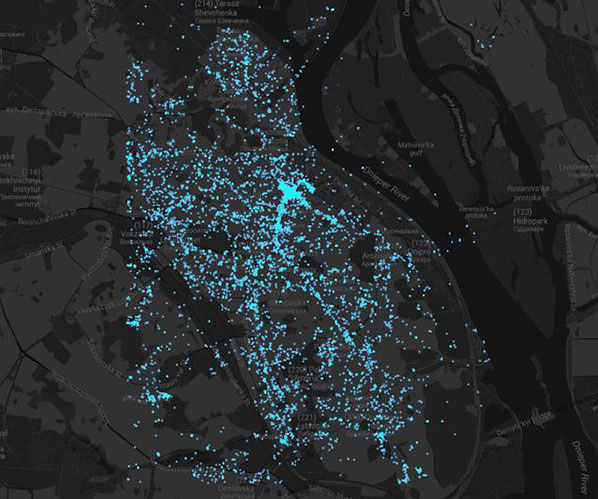
RP: Do you also see the collections of visualizations from user-generated images as an aesthetic realization?
LM: Perhaps one thing we can highlight is the idea of expressive visualization. As an artist I am also interested in the question of how can I present the world through the data. So let’s say a hundred years ago I would be taking photographs of a city. Now I can represent the city through 2 million Instagram photos. Thinking about landscape paintings in Impressionism, Fauvism, or even Cubism, how could I represent nature today through the contributions of millions of people? So I think of myself as an artist who is painting with data.
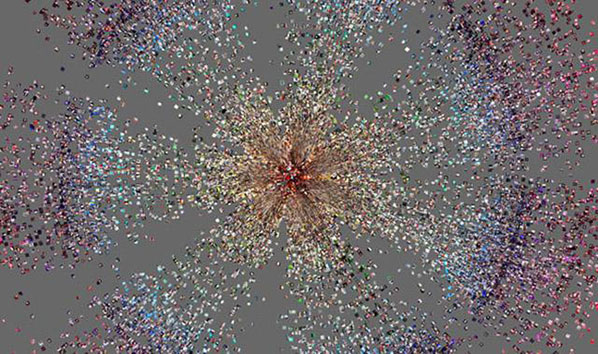
RP: But I’ve noticed that there is a focus in your writing on scientific methodology, you don’t talk very much about the renderings from an artistic perspective.
LM: It’s very clear that we’re taking ideas and techniques that have been used by modern artists. The difference is that we are pulling out data and writing open source tools. We’re taking in this case social media, works that were not created by us, and then putting them through different kinds of combinations. If you think about modernist collage of the city from the 1910s or 1920s, using pieces of newspaper and other existing media, what we’re doing exists in the same tradition.
RP: In many ways, the works can be fully appreciated as collage or composites, which I imagine goes against what you are trying to say through data analysis.
LM: No, it doesn’t go against what we are doing. It’s a matter of speaking to different parts of society. So you don’t just talk to designers or artists or like-minded people, you also talk to scientists. But ultimately what drives me is that I can I create something expressive, something unique, that isn’t just simply a data visualization, but creates an image that finds visual forms, that finds the right metaphors, which allows me to talk about modern society as consistent with its millions of data points. To me I think it’s a successful metaphor for how to speak about society today, when you think about all the traces you leave on social networks. I am trying to find the static visual forms to represent our new sense of society from seemingly random acts of individual people.

RP: Talk about the idea of “collective stories,” which are revealed in the composite of hundreds of thousands Instagram photos, each of which is a story in and of itself.
LM: We bring all these narratives together and try to make a kind of composite “film.” The connection to documentary, such as filmmakers like Dziga Vertov, for me is very clear. When Dziga Vertov, for example, was making his films in Kiev, he would have several cameramen in different parts of the Soviet Union shooting everyday, and they would send it to him and he would put it all together. So my “films” are made up of downloaded visuals, in which you can then make multiple “films” out of.
RP: Is it possible that the individual stories, the individual voice of expression, might get lost in this broad swath of data mining and cultural analytics?
LM: People are documenting what they think is interesting and important in their lives. But because there are very particular behaviors, what you get is a kind of pattern. I would say that patterns are not the same thing as a story. I don’t think of it as traditional narrative art, but rather a pattern of certain repeating behaviors.
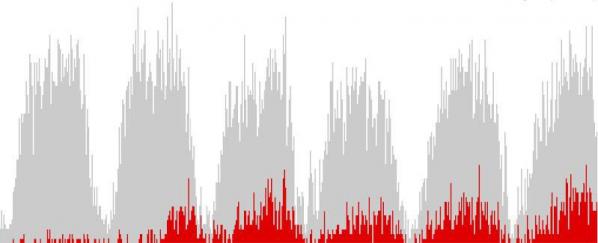
RP: How do you position the work you are doing in the context of the current crisis of invasive surveillance and the loss of privacy resulting from big data analysis?
LM: When we started thinking about these ideas in 2005, these issues were not on the table. In the last two or three years they have become central and to be honest they keep me up at night. I consider whether or not it’s OK because there are histories of governments using photographs of protests of honest people. I think the first time it happened seriously was in Prague in 1968 when it was raided by the Soviet Union. You had bystanders taking pictures, and when the pictures were found they were used to arrest people. So we thought a lot about it. When you start to individualize stories, when you start following particular people, then it gets really dangerous.
RP: In this sense its a very political project. What you have done is revealed that in the 21st century of social media it’s difficult to hide anything. What have you learned about contemporary life as seen through the lens of social media?
LM: This is a deep question. I’m basically trying to say that as opposed to a journalist who thinks about the “data” as a kind of truth, that it’s a way to find out what happened, what I’m thinking about is its own reality. It’s not a question of truth, it’s a question of making interesting connections.
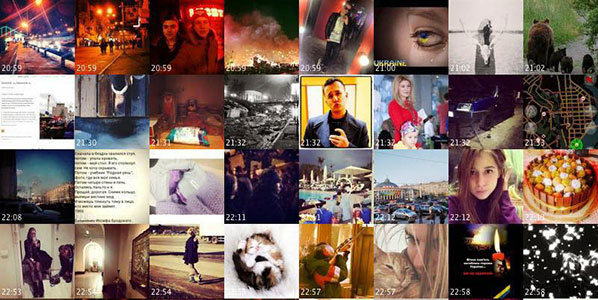
RP: That’s the difference between an artist and a journalist or even a scientist. You’re absorbing and you’re finding the connections but you’re not trying to say: this is it.
LM: I think the main answer is this: we can produce different visualizations out of the same data. Everyone views a different idea. It’s like when Monet paints another cathedral, there is not one painting that is correct. He makes a dozen paintings where every painting represents a different color, different atmospheric conditions, to show that in fact there are only the subjective views. So the goal is perhaps not to give people a new interpretation, but rather to challenge what they may be thinking is the correct one.
The Everyday and the Exceptional: 144 Hours in Kiev is a project of Lev Manovich in collaboration with Dr. Mehrdad Yazdani, Alise Tifentale, and Jay Chow.
First things first, Antonio Robert is a great guy. He is literally the happiest and most lively artist I’ve ever worked with, his online postings contribute in a full and proper way to both digital art and open source code communities, and he finds space in his wetware for the feedership of cats. He has top-notch glitch credentials, and is hooked into some important ideas about where that field is going – being the most active, if not only ‘glitch artist’ currently showing work in the UK. His work is rooted in glitch aesthetics and ideas, but constantly pushing at its edges. He’s performed and presented at Tate Modern, Databit.me in Arles, France, glitChicago, and he has his first solo show coming up at BOM (Birmingham Open Media) later this year.
Beside his happiness and energy, the first thing you notice about Antonio is that he has this geeky thing going on, like some kind of 90s Spielbergesque computer wizz – I’m sure I heard him call his computer ‘baby’ once as he goded it into action – but when he came to perform as part of our Syndrome programme in Liverpool, he literally ripped his tee-shirt off in the middle of the room, just as he was about to start.
He is the embodiment, in many ways, of the kind of volatility and fun in lots of great glitch art. I hooked up with Antonio online, where we spoke about glitch, and how it relates to his new iconoclastic work on copyright.
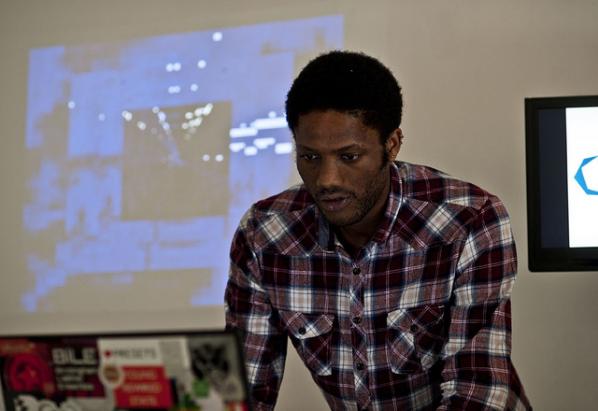
NJ: So… first question… You’re kinda out on your own in the UK it seems, as ‘the’ representative of the Glitch Art movement. I can see that that has been really great for you, for example with trips to Chicago etc… but does it also feel a little lonely?!
Antonio: Yeah, definitely. Ever since I helped bring the GLI.TC/H event to the UK/Birmingham in 2011 I’ve been getting questions about giltch art. I’m happy to impart my knowledge and experience to anyone that’s curious and my usual response is “you can do it too!”. That is, if you want to do glitch art there are so many tutorials about it. And, if you want there to be more events focused on glitch art all you need is an idea and some motivation.
NJ: There’s certainly an appetite for work which can reveal the systems underlying digital production – which is what good glitch art does. Do you think it is the term itself which is beginning to feel dated – as a result of an appropriation of its aesthetics? So fewer and fewer artists use this term now because its central modes are being used in a non-critical basis.
Antonio: I think it has become a bit dated through appropriation. That isn’t to say that glitch art has to be a specific thing and made using community-approved techniques, but now I see art that is just noisy or digital-looking that is described as glitch art.
NJ: I want to draw attention to some works of yours – or others – which seek out new (or different) systems which which to destructively engage. Because I think your work is still very much exploring and finding new territories opening up with this trope, while remaining within the ‘glitch’ genre. The work you made for the EVP website, “spɛl ænd spik:” modulated the construction of speech with phonemes. Where does the error enter into this, and do you consider it a departure from your work previous?
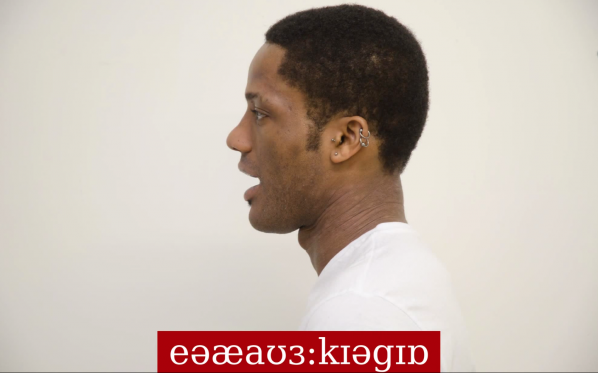
Antonio: It’s definitely a departure in terms of aesthetics.
NJ: It is not multicoloured!
Antonio: Hahah yeah. Even my clothes are plain. I wanted the focus to shift from the aesthetics of glitch. Glitch art incorporates many themes including randomness, error, helplessness, the unexpected, machine driven operations. And for the EVP piece I wanted to focus on randomness. I think the error lies in the perceptions of the viewer. When it was exhibited publicly at the Next Wave Exhibition at the RBSA many people thought that it was my voice and, at times, they could hear English words, so, the thing “glitching”, or experiencing an error in this case is their perceptions.
NJ: The tension between the random sounds and the possibility of speech is certainly unsettling.
Antonio: Then there’s the fact that those random sounds are coming from a human image… Digital and “New Media” art is still a new thing for many audiences and institutions, so confusion or bafflement is to be expected. I just hope that this then turns into curiosity. I hope that audiences then begin to ask questions about what it is they’re seeing and how it fits into their ideas about art, creativity and everything else.
NJ: There is something which Bifo Berardi says in “The Uprising: On Poetry and Finance”, where he is noting how ‘political decision has been replaced by techno-linguistic automatisms’, and it seems like ‘glitch’ art has a role to play here which is analogous to the one he assigns poetry in this book. Do you think that the kind of work you do with error is innately political or have revolutionary potential in this way?
Antonio: There is the overtly political work that I have made in the past. For example, Copyright Atrophy, which uses scripts and programs to challenge notions of ownership and copyright, was made specifically to be challenging, as was the work What Revolution. Another theme that interests me is copyright and free culture. And it’s always been there in my work, just not the core message. Now, for example, there is also the work about copyright which is currently being developed (as Archive Remix) as part of my residency at the University of Birmingham. It fits a long tradition of artists remixing artworks and appropriating culture. I’m hoping to bring about a change in attitudes at the university through my work with them.

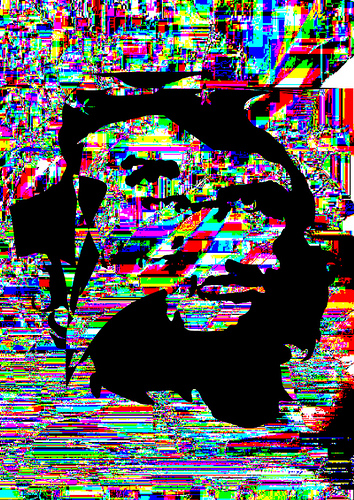
NJ: Just looking at the work you’re doing at University of Birmingham, it seems to deal with the same theme as Copyright Atrophy, which is a kind of horizon of ownership – which relates also to the horizon of meaning… between meaning and meaninglessness, between owned and apprpriated. So there is a point in the logo-gifs of Copyright Atrophy, and the Archive Remix animations, where they are operating simultaneously as a symbol, or original – and as a new, catachrestic symbol for something yet to be defined. I’m taking the term catachresis here from the way Lee Edelman uses it in his literary and cultural criticism such as No Future, to describe how ‘misuse’ of given words leads to an opening up for heretofore undiscovered territory – also similar to what Rosa Menkman describes as Glitchspeak.
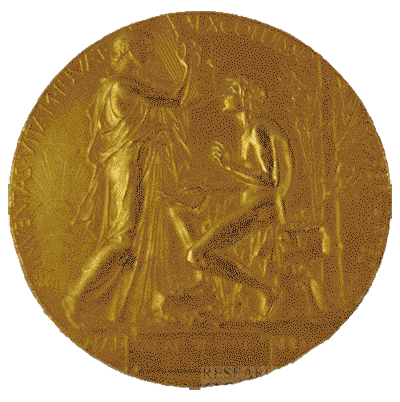
Antonio: Indeed. Although in Copyright Atrophy I am “destroying” the logos, in some way I’m evolving them too. I want to show that a piece of artwork is never truly finished as it may be reinterpreted and remixed by people, and also that we should let this natural evolution happen. Another example to illustrate this evolution is Comic Sans Must DIe.
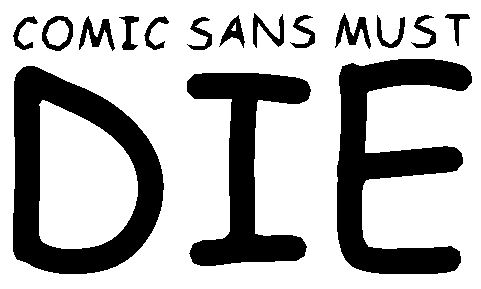
Yes, I’m destroying each glyph of Comic Sans, but some frames of that might make a good new typeface in itself. The short animations I’m making for Archive Remix are, at the moment, acting as case studies that I will take to the university to show good things can happen when you have more liberal licensing on images. As you may have seen, I also do a version of the animations with the copyrighted material censored. I want to show the perils of censoring. So underneath each “new” gif is one with the copyrighted material blacked out. Imagine if DJ Shadow’s album Entroducing only had works that had been cleared for usage!
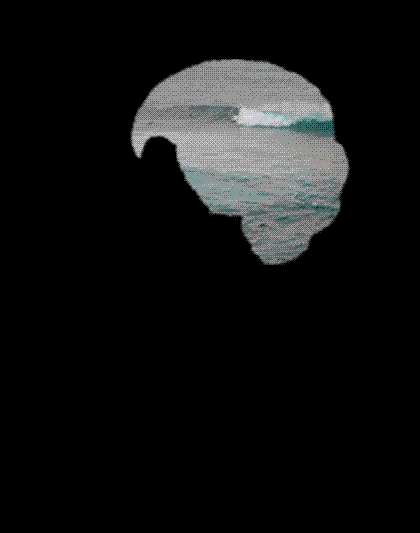
NJ: They are sad images, for sure. There is a melancholy at work here, which makes me think of the ‘death’ of the work, being the moment it has to stop evolving.
Antonio: Indeed.

NJ: I feel that way sometimes when I perform a poem, or even read it out to someone on the phone, that somehow its limitations have been reached as potential. Do you think it’s this attitude of a work always being open to interpretation which creates an exit from the inevitably melancholy ending of a completed artwork? I guess that’s one reason why an open platform for the code you produce is attractive.
Antonio: I can see the performance or exhibiting of an artwork as limiting because what has to be presented is something finished. However, sometimes I see this as a chance to exhibit one iteration of the work. It’s always open to myself or others to remake or build on from. There have been people that have built on the code and programs that I make and I’m thankful for this. The best example of this was the method I created for generating jpgs from random data, which was in itself inspired by HEADer Remix by Ted Davis. David Schaffer greatly extended this into his own tool and Holger Ballweg ported the code into SuperCollider. If any code I write inspires others who am I to stop them from using or building on it?
NJ: A year or so ago, I proposed that art forgery should be legalised. I feel, along with many others, that the ‘art market’ has very little to do with the community of artists most worthy of admiration and respect. But perhaps it is ownership itself that is the problem. What is there in ownership ‘authorship’ which is valuable to retain? Attribution, I suppose – but what value in attribution?
Antonio: Yes, attribution is the important thing. All people should rightfully own the thing that they make. But problems arise because they then want to own everything that comes after it. So yes, remixes, reinterpretations are important and should be allowed, just as long as the original author is attributed for their work. It’s all a confusing and scary time for artists and the art world. Everyone’s wondering how they can make money and sustain their practice whilst still reaching as many people as possible. I hope that through my work I can show that these new approaches (open source, free culture, liberal licensing etc) can yield positive results and won’t necessarily result in the loss of earnings or opportunities.
NJ: It’s kind of ironic though, isn’t it, that digital artists like yourself who actively question and disrupt the basis of the apparently ‘infinite flows’ of digital content, finance… are part of a scene whose infrastructure itself is crumbling, and who generally suffer a very real stress and insecurity as a result. This is exacerbated as well by the kind of funding environment which might be offsetting this instability somewhat, but where digital artists are co-opted ecosystem of ‘digital economy’ — rather than a ‘cultural economy’ — itself formed around ideas of efficiency, and hence ‘labour savings’? Do you think this might actually be harmful?
Antonio: Yes, I think it’s dangerous focusing just on digital economy and making everything digital. Sure, it’s exciting that technology brings us all of these opportunities, but it leaves behind everyone that doesn’t work in that way.
NJ: Finally, on this subject, I thought you might like to highlight some contemporary work which influences you, which comes from outside the ‘digital art’ scene (if this is even possible!) and thus contributes to the ecosystem of digital innovation, in more traditional forms.
Antonio: One of my influences was Arturo Herrea’s 2007 exhibition at the Ikon Gallery. I loved the way there was order in the chaos. Outside of that it’s really difficult to find examples of influential work that isn’t in some way digital. A lot of the live performance, sculpture and video work that inspires me is often not only made using digital technology – 3D printing, projection etc – but is about digital and internet culture.

You can follow Antonio on
http://www.hellocatfood.com/http://hellocatfood.tumblr.com/
and https://twitter.com/hellocatfood
and Nathan is at https://twitter.com/nathmercy
Art, to misparaphrase Jeff Koons, reflects the ego of its audience. It flatters their ideological investments and symbolically resolves their contradictions. Literature’s readers and art’s viewers change over time, bringing different ways of reading and seeing to bear. This relationship is not static or one-way. The ideal audience member addressed by art at any given moment is as much produced by art as a producer of it. Those works that find lasting audiences influence other works and enter the canon. But as audiences change the way that the canon is constructed changes. And vice versa.
“The Digital Humanities” is the contemporary rebranding of humanities computing. Humanities for the age of Google rather than the East India Company.
Its currency is the statistical analysis of texts, images and other cultural resources individually or in aggregate (through “distant reading” and “cultural analytics“).
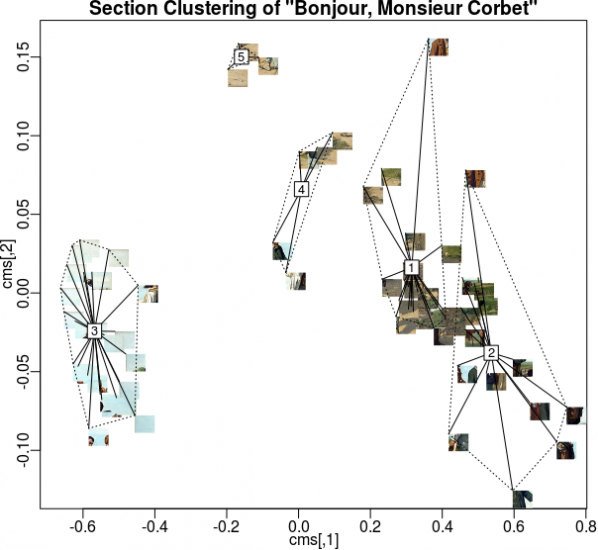
In the Digital Humanities, texts and images are read and viewed using computer algorithms. They are “read” and “viewed” by algorithms, which then act on what they perceive. Often in great number, thousands or millions of images or pages of text at a time, many more than a human being can consider at once.
The limitations of these approaches are obvious, but they provide a refreshing formal view of art that can support or challenge the imaginary lifeworld of Theory. They are also more realistic as a contemporary basis for the training of the administrative class, which was a historical social function of the humanities.
Digital Humanities algorithms are designed to find and report particular features of texts and images that are of interest to their operators. The most repeated words and names, the locations and valences of subjects, topics and faces and colours. They produce quantitative statistics regarding works as a whole or about populations of works rather than qualitiative reflection on the context of a work. Whether producing a numeric rating or score, or arranging words or images in clouds, the algorithms have the first and most complete view of the cultural works in any given Digital Humanities project.
This means that algorithms are the paradigmatic audience of art in the Digital Humanities.
Imagine an art that reflects their ego, or at least that addresses them directly.
Appealing to their attention directly is a form of creativity related to Search Engine Optimization (SEO) or spam generation. This could be done using randomly generated nonsense words and images for many algorithms, but as with SEO and spam ultimately we want to reach their human users or customers. And many algorithms expect words from specific lists or real-world locations, or images with particular formal properties.
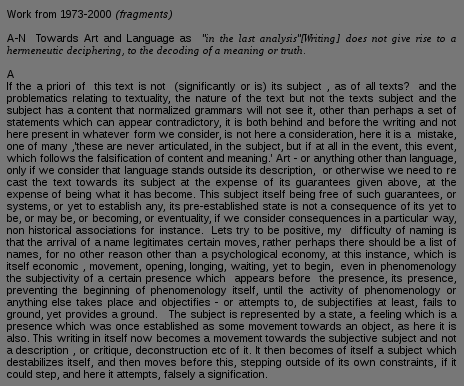
A satirical Markov Chain-generated text.
The commonest historical way of generating new texts and images from old is the Markov Chain, a simple statistical model of an existing work. Their output becomes nonsensical over time but this is not an issue in texts intended to be read by algorithms – they are not looking for global sense in the way that human readers are. The unpredictable output of such methods is however an issue as we are trying to structure new works to appeal to algorithms rather than superficially resemble old works as evaluated by a human reader.
The two kinds of analysis commonly performed on cultural works in the Digital Humanities require different statistical approaches. Single-work analyses include word counts, entropy measures and other measures that can be performed without reference to a corpus. Corpus analysis requires many works for comparison and includes methods such as tf-idf, k-means clustering, topic modeling and finding property ranges or averages.
ugly despairs racist data lunatic digital computing digital digital humanities digital victim furious horrific research text racism loathe computing text humanities betrayed digital text humanities whitewash computing computing cheaters brainwashing digital research university university research falsifypo pseudoscience research university worry research data technology computing humanities technology data technology research university research university computing greenwasher cruel computing university data disastrous research digital guilt technology university sinful loss victimized computing humiliated humanities university research ranter text text technology digital computing despair text technology data irritate humanities text data technology university heartbreaking digital humanities text chastising text hysteria text digital research destructive technology data anger technology murderous data computing idiotic humanities terror destroys data withdrawal liars university technology betrays loathed despondent data humanities
A text that will apear critical of the Digital Humanities to an algorithm,
created using negative AFINN words & words from Wikipedia’s “Digital Humanities” article
We can use our knowledge of these algorithms and of common training datasets such as the word valence list AFINN and the Yale Face Database, along with existing corpuses such as flickr, Wikipedia or Project Gutenberg, to create individual works and series of works packed with features for them to detect.
web isbn hurrah superb breathtaking hurrah outstanding superb breathtaking isbn breathtaking isbn breathtaking thrilled web internet hurrah media web internet outstanding thrilled hurrah web thrilled media thrilled superb breathtaking art breathtaking media superb hurrah superb net artists outstanding internet outstanding net superb thrilled thrilled art hurrah based outstanding superb net internet artists web art art artists internet breathtaking based net hurrah outstanding thrilled superb hurrah media based outstanding media art artists outstanding isbn based net based thrilled artists isbn breathtaking
A text that will appear supportive of Internet art to an algorithm,
made using positive AFINN words and words from Wikipedia’s “Internet Art” article.
When producing textual works for individual analysis, sentiment scores can be manufactured for terms associated with the works being read. Topics can be created by placing those terms in close proximity. Sentence lengths can be padded with stopwords that will not affect other analysis as they will be removed before it is performed. Named entities and geolocations can be associated, given sentiment scores, or made the subjects of topics. We can structure texts to be read by algorithms, not human beings, and cause those algorithms to perceive the results to be better than any masterpiece currently in the canon.
When producing textual works to be used in corpus analysis individual or large volumes of “poisoning” works can be used to skew the results of analysis of the body of work as a whole. The popular tf-idf algorithm relates properties of individual texts to properties of the group of texts being analysed. Changes in one text, or the addition of a new text, will skew this. Constructing a text to affect the tf-idf scores of the works in a corpus can change the words that are emphasized in each text.
The literature that these methods will produce will resemble the output of Exquisite Code, or the Kathy-Acker-uploaded-by-Bryce-Lynch remix aesthetic of Orphan Drift’s novel “Cyberpositive“. Manual intervention in and modification of the generated texts can structure them for a more human aesthetic, concrete- or code-poetry-style, or add content for human readers to be drawn to as a result of the texts being flagged by algorithms, as with email spam.
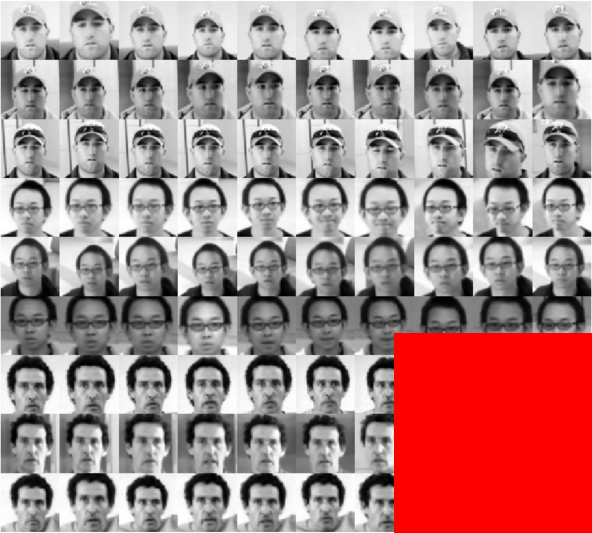
When producing images for individual analysis or analysis within a small corpus (at the scale of a show, series, or movement), arranging blocks of colour, noise, scattered dots or faces in a grid will play into algorithms that look for features or that divide images into sectors (top left, bottom right, etc.) to analyse and compare. If a human being will be analysing the results, this can be used to draw their attention to information or messages contained in the image or a sequence of images.
When producing image works for corpus analysis we can produce poisioning works with, for example, many faces or other features, high amounts of entropy, or that are very high contrast. These will affect the ranking of other works within the corpus and the properties of the corpus as a whole. If we wish to communicate with the human operators of algorithms then we can attach visual or verbal messages to peak shift works, or even in groups of works (think photo mosaics or photobombing).

The images that these methods will produce will look like extreme forms of net and glitch art, with features that look random or overemphasized to human eyes. Like the NASA ST5 spacecraft antenna, their aesthetic will be the result of algorithmic rather than human desire. Machine learning and vision algorithms contain hidden and unintended preferences, like the supernormal stimulus of abstract “superbeaks” that gull chicks will peck at even more excitedly than at those of their actual parents.
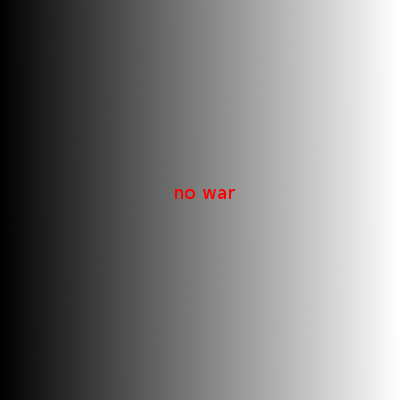
Such image and texts can be crafted by human beings, either directed at Digital Humanities methods to the exclusion of other stylistic concerns or optimised for them after the fact. Or it can be generated by software written for the purpose, taking human creativity out of the level of features of individual works.
Despite their profile in current academic debates the Digital Humanities are not the only, or even the leading, users of algorithms to analyse work in this way. Corporate analysis of media for marketing and filtering uses similar methods. So does state surveillance.
Every video uploaded to YouTube is examined by algorithms looking for copyrighted content that corporations have asked the site to treat as their exclusive property, regardless of the law. Every email you send via Gmail is scanned to place advertisements on it, and almost certainly to check for language that marks you out as a terrorist in the mind of the algorithms that are at the heart of intelligence agencies. Every blog post, social media comment and web site article you write is scanned by search and marketing algorithms, weaving them into something that isn’t quite a functional replacement for a theory. Even if no human being ever sees them.
This means that algorithms are the paradigmatic audience of culture generally in the post-Web 2.0 era.
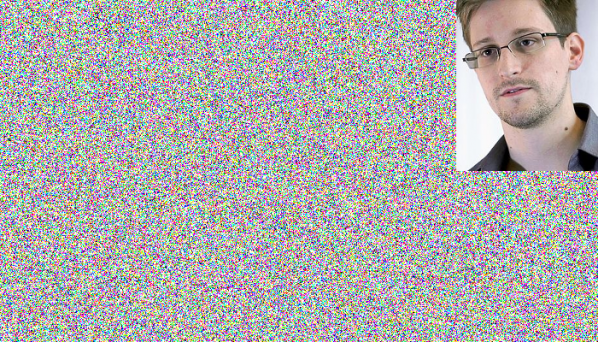
Works can be optimized to attract the attention of and affect the activity of these actors as well. Scripts to generate emails attracting the attention of the FBI or the NSA are an example of this kind of writing to be read by algorithms. So are the machine-generated web pages designed to boost traffic to other sites when read by Google’s PageRank algorithm. We can generate corpuses in this style to manipulate the social graphs and spending or browsing habits of real or imagined populations, creating literature for corporate and state surveillance algorithms.
Image generation to include faces of persons of interest, or with particular emotional or gender characteristics, containing particular products, tagged and geotagged can create art for Facebook, social media analytics companies and surveillance agencies to view. Again both relations within individual images and between images in a corpus can be constructed to create new data points or to manipulate and poison a larger corpus. Doing so turns manipulating aesthetics into political action.
Cultural works structured to be read first by algorithms and understood first through statistical methods, even to be read and understood only by them, are realistic in this environment. Works that address a human audience directly are not. This is true both of high culture, studied ideologically by the algorithms of the Digital Humanities, and mass culture, studied normatively by the algorithms of corporation and state.
Human actors hide behind algorithms. If High Frequency Trading made the rich poorer it would very quickly cease. But there is a gap between the self-image and the reality of any ideology, and the world of algorithms is no exception to this. It is in this gap that art made to address the methods of the digital humanities and their wider social cognates as its audience can be aesthetically and politically effective and realistic. Rather than laundering the interests that exploit algorithmic control by declaring algorithms’ prevalence to be essentially religious, let’s find exploits (in the hacker sense) on the technologies of perception and understanding being used to constructing the canon and the security state. Our audience awaits.
The text of this article is licenced under the Creative Commons BY-SA 4.0 Licence.
Featured image: Image from the exhibition: http://gl1tch.us/GlitchArt-wit-jonCates.html
jonCates upcoming keynote, along with the entire Art of the Networked Practice online symposium, March 31 – April 2, 2015, will be free, open and accessible via web-conference from anywhere in the world. Visit the Website to register. The symposium is in collaboration with Furtherfield.
jonCates in Conversation With Randall Packer
we need to humanize ourselves + our systems, to recognize that we are amidst failed futures, broken tools + glitched environments made from media, mediums, mediations + filtered through failures. – jonCates

Describing the world of new media/glitch artist jonCates is a labyrinthine task. You might begin with his spontaneous and inventive word-language actions reminiscent of William Burroughs cut-ups; or the hypnotic .gif animations made from seemingly incongruous, discarded fragments of media; or perhaps his “dirty new media” aesthetic that brings to the surface the aberrations and raw imperfections that are typically verboten in “high-end” digital circles.
jonCates has ironically and quite cleverly co-mingled punk and pirate media with thoughtful theoretical discourses. Based in Chicago, he is Chair of Film, Video, New Media and Animation at the School of the Art Institute of Chicago by day, prowling the sub-culture of the alternative spaces by night. Cates is at the center of a glitch scene in Chicago, now referred to as the “birthplace of dirty new media,” a movement he has in large part catalyzed: spawning the international GLI.TC/H Festivals and other assorted hactivist events and DIY workshops.
In my conversation with jonCates we discuss his unique synthesis of language and media, his critique of technology, and how glitch, in all of its multifarious manifestations, has powered his work, functioning as a force for uniting artists, students, and communities in collective activity.

Randall Packer: I want to start off with the way in which you blend everything – in your life, in your work, your practice, theory, communications, writing, teaching –there is a mélange of language, a spirit and playfulness, that all seems to flow together with glitch. Would you say that glitch is a way of life?
jonCates: yeas, in faxxx, well first off, i would like to say thnxxx for giving the work the level of attn you have. i think that my approach to Digital Arts or New Media Art is 01 that takes a systemsapproach, not in a kind of cold cybernetic way but in a more wholistic sense of systems, those systems might be broken, they might be glitched, + they might be imperfect + noisy, + that might be what attracts us or me to those systems. but still they are functional or rather functioning in one way or another systematically. so they are connected to one another as assemblages.

RP: I would say that glitch is a language, spoken by its practitioners, who have co-mingled code with the spoken word, or maybe I should say specific to your work, mixing machine language with human language: accepting the aberration as perhaps more important than the message. Is the aberration the message?
jC: i would def’ly say that there is a poetic embrace of noise && error. my interests are also, continue to be, motivated by the connections between Noise Musics + experimental New Media Art. for me this approach to noise or noisiness, or dirt, or dirtiness, is a way to foreground as you say, an aberrance or perversion of normative msg or what we might perceive to be logical reasoning. b/c there is a poetics to that obviously. ppl who inspired me most directly in that manner would be Netochka Nezvanova, who did this comingling of functional code w/ highly politicized + poetic language.
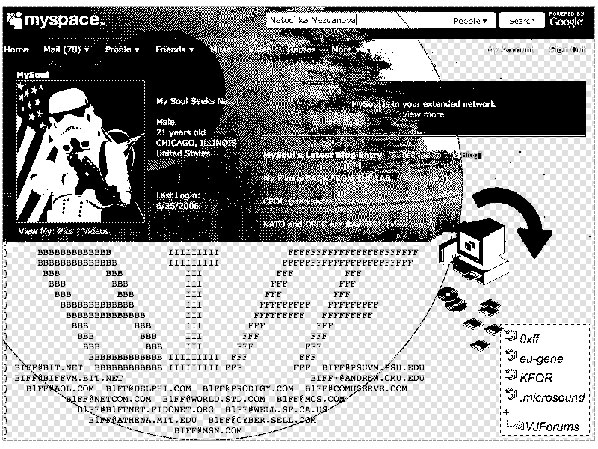
RP: So is glitch an act of undermining the status quo of our relationship to technology?
jC: it certainly can be. i think that there was mayhaps a time recently in witch glitch works were more directly mobilizing that kind of critical stance. but glitch is also folded into aesthetics that are also highly popular so there’s a popularity to the glitch aesthetic which would undermine an argument for saying it is exclusively resistant or exclusively political. it’s just impure.
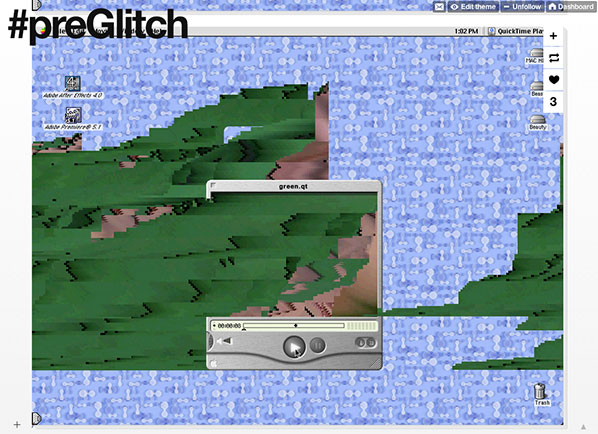
RP: I see many resonances with avant-garde figures both in art and in technology, such as Dick Higgins, for example, in his concept of intermedia. The idea of closing the gap between art and life, media and things, and in your case between language and machine language, art and theory, or as Dick Higgins might have said: art and everything else.
jC: the discourse on art/life, on performance, performance art, those were topics i studied when I was younger: thinking about how technologies that we use are all social. they’re techno-social. we live inna techno-social culture. these technologies are also socially performed, + that means that there are these performative aspects. for instance there is a corporate performance of cleanliness + purity. + then there is the performance of everyday life that we’re all doing all the time w/ all of our technologies. so, we’re making them human, in the sense that we are making them part of our lives.

RP: In regards to your idea of “dirty new media,” my response is that the dirtiness implies there is a human quality in new media, that it is not perfect, it’s not sterile, it’s not removed from real life, but it contains its imperfections, it’s impurities, in a way, it’s organic qualities, that get closer to our “wet” lives, rather than our binary ones.
jC: abs’ly! that’s abs’ly a part of the goal in terms of using this term, Dirty New Media OR d1Ɍ+y̶ ̶N̶3WWW_M3DI∆, to foreground all those faxxx. but also that there is a non-neutrality of techno-social artifacts + contexts, that our technologies are not neutral, also that they are embedded, they are part of our lives, + that embeddedness has the word bed in there, we are in bed w/ them also, so they’re embedded in ways that are complex. they are not sterile, they’re imperfect, they are not clean, b/c they exist in the world, which is also imperfect. + so, i do believe that d1Ɍ+y̶ ̶N̶3WWW_M3DI∆ as a way of lyfe + as an approach to artmaking is a way of foregrounding these faxxx, these realities, of our lived exxxperiences, + acknowledging how situated we all are w/ all of these systems, + artifacts that we have made, unmade && remade together.

RP: A lot of people at first glance might look at your work and think that it has been completely usurped by machine language, by a kind of technological sensibility. And so, I am wondering in view of this convergence between human language and machine language the question then might become: where does the machine end and the artist begin.
jC: that’s a gr8 question… well, the machine world is machined by us out of the world + we have literally machined the world. it’s our world, in the sense that we have crafted it. + we’re constantly uncrafting && re-crafting it. it produces errors, mistakes, breakdowns, glitches, noise, + from a Computer Science perspective, what you would want to do would be debugging + refining. but from a d1Ɍ+y̶ ̶N̶3WWW_M3DI∆ perspective, what you might want to be doing is “rebugging,” && pushing different aspects of the machinewwwhirlds to see their thresholds, exxxperiment, + play.
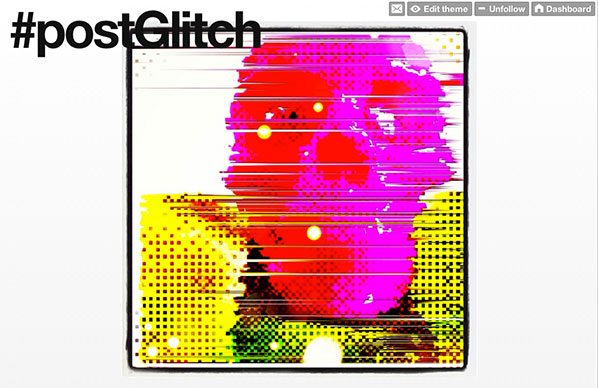
RP: Ultimately there is a playfulness that I think undermines the dystopic view that we sometimes have towards technology. jC: i rly hope that is the case. that’s constantly a goal that i am working on. there are those in my immediate community, + in Glitch Art communities in general, who i am also responding to, who are in fact dystopic, && who are also Discordians, + who are intentionally exploring Chaos Majik or who have aspirations to Kaos Magick, + those kinds of Discordian approaches. && that’s not my intent.
RP: I like the way that you counter the dystopic questions that you get, with an even greater barrage of glitch. For example, there is a comment that Sterling Crispin made when he said: “the glitch/noise fetish is an inversion of humanity & symbolic embrace of death & rampant infectious nihilism.” OK… And your response was:
“thnxxx @sterlingcrispin, my work is an axxxual process of: #glitch #fetish #noise #dirty #newmedia from a #humanist #perspective.”
jC: (laughs) yea, i thought that was funny. i took his comment vry srsly && vry pointedly + it motivated me to write an essay, which is up on the GL1TCH.US Unstable Book for Unstable Media that i am constantly working on. he uses keywords that i am connected to + that have motivated me. he was using fetish, but he was using it in a negatively valenced way + i wanted to reclaim fetish && say, yea, of course fetish is part of what i do b/c fetish is punk + its part of “originary” punk from the SEX shop run by Malcolm McLaren + Vivian Westwood. so, yea, of course, fetish is in my work, but its in this way that’s consistent w/ my art/life inna way that’s dirty, in the sense of being impure, but also (hopefully) sexxxy && exxxciting!
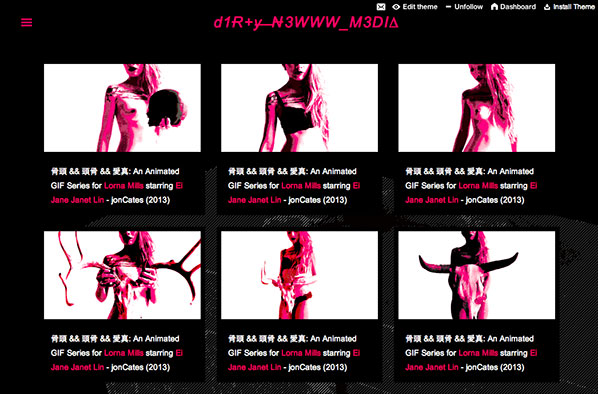
RP: Maybe counter to the world that we live in today with our corporate environment, in which the technology companies encourage a fetish with the slick, clean design of technology. What you have done, is through the construction of a language and a world that you have created, you’ve attempted to break that down and show us what our relationship to technology could be and perhaps should be.
jC: thnxYou! abs’ly! + openUp possibilities, potentialities for ppl, as well as for myself, but also for a community that can mobilize around these approaches, these ideas. it’s counter-intuitive to the rampant, hyper-individualism that lays waste to so much effort that emerges from group practices, communities, to shared or Open Source cultures. this idea of building community, building tools + systems, && sharing those tools + systems w/in the community so that the community can org around all of that + then share work && work goes back out into the communities, to keep it alive. i think i just sketched out a pedagogy! 🙂
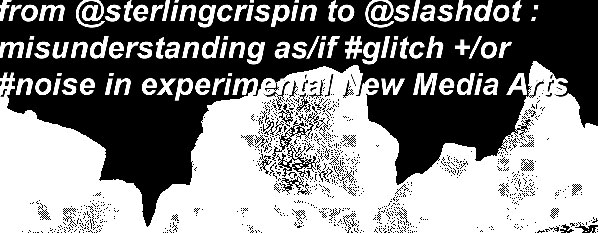
RP: It’s a wonder to me how you balance your personal, artistic and academic life.
jC: it’s a healthy friction for me, it gives me inspiration to work outside of the institution, to work in bars, clubs, DIY/DIT spaces, alternative spaces, it’s a good, healthy dynamic for me. in glitch communities there’s a lot of sharing of technique, + a lot of open sourcing or at least sharing of approaches + practices. so that can have the effect of people learning to reproduce certain styles, or certain aesthetics. but a way to not be stuck on repetition is to focus on glitch as a form of surprise + as a way of glitching ppl’s exxxpectations.
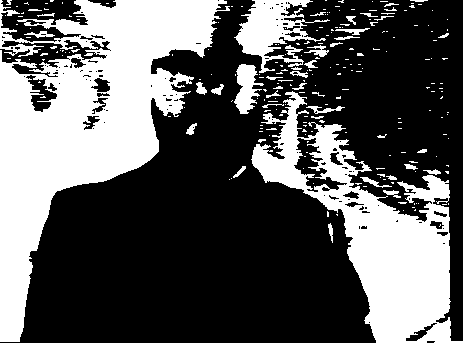
jonCates has several current projects, including the online publication of “Dirty New Media: Hyperthreaded @ GLI.TC/H 2012” by jonCates and Shawne Michaelain Holloway (2014). For more information, visit his Website.
Featured image: Image from Joel Bakan: The Panopticon Power of the new media. Adbusters Jan 2012.
Marc Garrett and Ruth Catlow interview McKenzie Wark ahead of his keynote speech for Transmediale 2015 in Berlin this year.
It’s ten years since McKenzie Wark published his influential book, A Hacker Manifesto. Divided into 17 chapters, each offers a series of short, numbered paragraphs that mimic the epigrammatic style of Guy Debord’s The Society of the Spectacle. Wark then published, amongst others, a series of critically engaging books such as Gamer Theory and the Spectacle of Disintegration. Ruth Catlow and Marc Garrett from Furtherfield ask Wark how things have changed since these publications, focusing on how our everyday lives have been infiltrated by competitive game-like mechanisms that he described more than a decade ago.
Furtherfield: You published the experimental writing project Gamer Theory first as a book in 2006 and then in 2007 with a specially revised 2.0 version online.
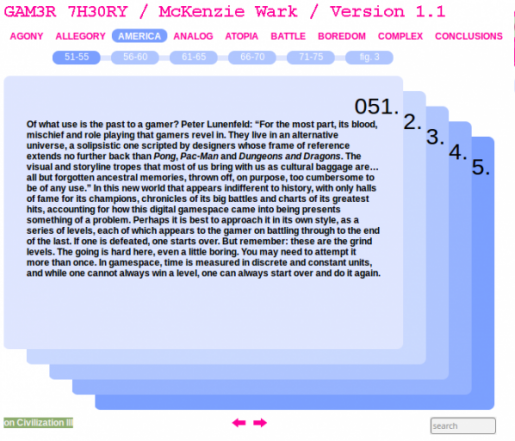
Mckenzie Wark: Yes, although I think the network book version is mostly broken now. Good thing there’s a dead-tree format back-up!
F: In it you argue that we’re living in a world that is increasingly game-like and competitive. Also that computer games develop a utopian version of the world that realizes the principles of the level playing field and reward based on merit; whereas in the world, this is promised, but rarely realized.
MW: Yes, I think one way of thinking about certain games is that they are a fully realized neo-liberal utopia, which actually gives them some critical leverage of everyday life, which is a sort of less-real, only partially realized version of this, where the playing field is not level, where the 1% get to ‘cheat’ and get away with it.
F: You also talk of the “enclosure of the world” within the “gamespace” where the logics of the game are applied as the general patterns of organization in the world. And this happens as we adapt to the allegorical forms of contemporary games media.
How do you think this situation has changed since you wrote Gamer Theory?
MW: Well, to me it looks like the tendency analyzed in Gamer Theory became even more the case. GamerGate looks among other things like a reactive movement among people who really want the neoliberal utopia in all its actual neofascist and misogynist glory to not be exposed as different to everyday life. When women gamers or game journalists stick their hands up and say, “hey, wait a minute”1, they just want to mow them down with their pixelated weapons. So the paradox is that as gamespace becomes more and more ubiquitous, the tension between promise and execution becomes ever more obvious.
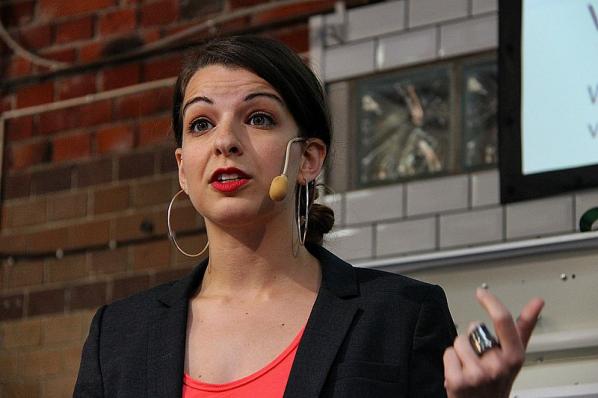

F: Do you see the term Gamification that many theorists use currently as an elaboration of the ideas you developed in Gamer Theory? Or are there significant new ideas being explored?
MW: Ha! Well no, gamification was about celebrating the becoming game-like of everyday life. So I always saw that as a kind of regression from thinking about the phenomena to sort of cheerleading for it.
F: The software developer and software freedom activist Richard Stallman, when visiting Korea in June 2000 illustrated the meaning of the word ‘Hacker’ in a fun way. During a lunch with GNU fans a waitress placed 6 chopsticks in front of him. Of course he knew they were meant for three people but he found it amusing to find another way to use them. Stallman managed to use three in his right hand and then successfully pick up a piece of food placing it into in his mouth. Stallman’s story is a playful illustration of “hack value,” about changing the purpose of something and making it do something different to what it was originally designed to do, or changing the default.2
Stallman was highlighting fun and the mischievous imagination as part of the spirit of what he sees as hack value.
Where do you see lies the hack value in games culture? What has happened to the fun in games? Who’s having it and where is it happening?
MW: Stallman is one of the greats. Sometimes, people have this experience of scientific or technical culture as one of free collaboration, where there’s a real play of rivalry and recognition but based on producing and sharing knowledge as a kind of gift. JD Bernal had that experience in physics in the 30s and Stallman had, I think, a similar experience in computing. I think it’s important for those of us from the arts or humanities to honor that utopian and activist impulse coming out of more technical fields.

There’s a lively, critical and even avant-garde movement in games right now. That’s part of why it has provoked such a fierce reaction from a certain conservative corner. The culture wars are being fought out via games, which is as it should be, as it’s one of the dominant media forms of our times. So there’s certainly some sophisticated fun to be had alongside the more visceral pleasure of clearing levels.
F: “Our species’ whole recorded history has taken place in the geological period called the Holocene – the brief interval stretching back 10,000 years. But our collective actions have brought us into uncharted territory. A growing number of scientists think we’ve entered a new geological epoch.”3 And, this new geological epoch has been proposed as – the Anthropocene.

In your essay ‘Critical Theory After the Anthropocene’4 you say “At a minimum, the Anthropocene calls on critical theory to entirely rethink its received ideas, its habituated traditions, its claims to authority. It needs to look back in its own archive for more useful critical tools.”
What are these ‘useful critical tools’ and how might theorists, new media artists, game designers and society at large put these to work?
MW: The ‘cene’ part of Anthropocene (from the Greek kainos) means a qualitative break in time. If time is in a sense always different, then kainos is the differently-different – a new kind of time. Those like Paul Crutzen who have advocated the use of the term Anthropocene to designate a new geological time have issued a major challenge as to how to interpret such a possibility. I leave it to the scientists to figure out if such a claim is scientifically valid. As someone trained in the humanities, I think the generous, comradely, cooperative thing to do is to try to interpret what our friends and colleagues in the sciences are telling us about the times. So in Molecular Red that was what I set out to do. Let’s take seriously the claim that these times are not ‘like’ other times. That I think calls for a rethinking of what from the cultural past might be useful now. I think we need new ancestors. Which is why, in Molecular Red, I went looking for them, based on the question: to which past comrades would the Anthropocene come as no surprise? I think Alexander Bogdanov, who understood a bit about the biosphere and the carbon cycle, would not be surprised. I think Andrey Platonov, who wrote about the attempts and failures to build a new kind of infrastructure for the Soviet experiment in a new mode of production would not be surprised. There are others, but those I thought were particularly helpful, not least because their Marxism remained in dialog with the sciences and technical arts. I don’t think the more romantic anti-science side of Western Marxism and continental thought is all that helpful at the moment, not least because it rules out of court exactly the kinds of scientific knowledges through which we know about the Anthropocene in the first place. The anti-science critique has been captured by the right, so we need new tactics.
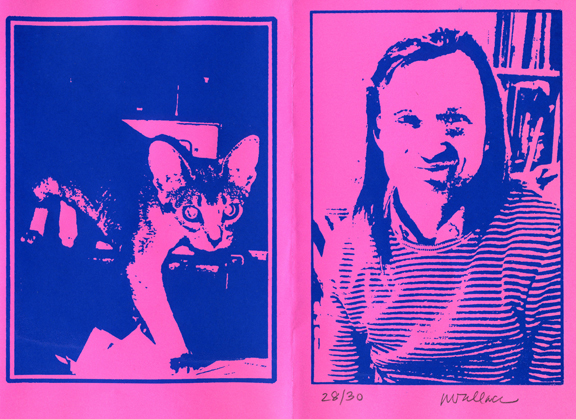
F: Who’d be empowered by an encounter with your ideas and where do you see the potential for agency in the current economic and environmental contexts?
MW: Not for me to say really. Writers are usually the last people to have any clues as to what their writing says. There’s a sort of idiot quality to banging away on a keyboard. We’re word processors. Its always surprising to me the range of people who find something in what I write.
My hunch is that the future is in the hands of an alliance between those who make the forms and those who make the content: a hacker and worker alliance. It is clear that this civilization has already become unreal. Everyone knows it. We have to experiment now with what new forms might be.
F: And, where in the world do you see examples of individuals, groups and organizations, and or companies – who are putting into action some of the critical questions that you’re exploring in your writing?
MW: Besides Furtherfield? I never like to give examples. Everyone should be their own example. To détourn an old slogan of the 60s: be impossible, do the realistic!
F: In your later essay ‘The Drone of Minerva’5 you continue to write about the Anthropocene. But, you also bring to the table the subject of the Proletkult.6 The Proletkult aspired to radically modify existing artistic forms of revolutionary working class aesthetic which drew its inspiration from the construction of modern industrial society in Russia. At its peak in 1920, Proletkult had 84,000 members actively enrolled in about 300 local studios, clubs, and factory groups, with an additional 500,000 members participating in its activities on a more casual basis.
You are writing about the Proletkult in your latest book. Could you tell us a little something about this and how it will connect to contemporary lives?
MW: Proletkult was influential in Britain too, during the syndicalist phase of the British labor movement, up until the defeat of the 1926 general strike. After that the dominant forms were, on the one hand, the ethical-socialism and parliamentary path of the Labour Party, or the revolutionary Leninist party. Well, those paths have been defeated now too. I think we have to look at all of the past successes and failures all over again and cobble together new organizational and cultural forms, including a 21st century Proletkult.7 What that might mean is trying to self-organize in a comradely way to try and gain some collective charge of our everyday lives. It does not mean just celebrating actually existing working class cultures. Rather it’s more about starting there and developing culture and organization not as something reactive and marginalized but as something with organizational consistency and breadth. Since the ruling class clearly doesn’t give a fuck about us, let’s take charge of our own lives – together.
Thank you McKenzie Wark – Ruth Catlow & Marc Garrett 😉
Ruth Catlow will be at Transmediale 2015 CAPTURE ALL, moderating the keynote Capture All_Play with McKenzie Wark, on Sat, 31 Jan at 18:00.
Ruth is also participating in two other events, Play as a Commons: Practical Utopias & P2P Futures and The Post-Digital Review: Cultural Commons – http://www.transmediale.de/content/ruth-catlow
To many, technology and spirituality would seem antithetical. Contemporary technology is intertwined with modern science, whereas, spirituality is equally enmeshed within both religion and faith. The Post-Human Gospel self-consciously accepts this awkwardness, and manoeuvres these two uneasy bedfellows together. Offering up a night of performances, by artists whose entangled relation to technology seeks to posit new forms of identity and spirituality.
This is the latest in a series of events, collectively entitled Syndrome, seeking to explore the relationship between technology and affect in performance. The Post-Human Gospel marks the start of the third phase of this activity, collaboratively programmed by Mercy and The Hive Collective. If 3.0 is heading into the realm of spirituality, then earlier phases have played with both language and control – whether the constraints enforced on the body in virtual space, role-playing authority within the State Free State of a.P.A.t.T island, or a ‘room as instrument’ where you can physically manipulate sound and light. Across these events, those involved ask how we might interact or play with this technology, and in turn, how this experience might then act upon on us – our feelings and emotions?
The venue at 24 Kitchen Street has played host to several past Syndrome events, and as such feels like a hub for this activity as it meanders across the city. Arriving early there is a relaxed feeling to the space: people stand around chatting, whilst others tinker with equipment and final set-up, all bathed within the blue glow of the expectant projection screens. There is a familiarity to the space on a number of levels – not only physically, with decaying white walls and exposed structure typical of the post-industrial use of such buildings, but also in terms of its unclear typology, part-bar, part-residency-space, part-performance-venue, part-something-else-entirely. An earlier performer, Mathew Dryhurst, described a type of ‘third space music’ that requires a new type of venue. Something that Syndrome is clearly looking to create in Liverpool.
The evening’s Gospel was tripartite, starting with SHRINE by Outfit, followed by a first-time collaboration between Lawrence Lek and Siôn Parkinson, and then brought to a close with a live AV set by TCF. All performed from a improvised V-shaped altar – constructed from scaffold, screens, speakers and an array of other equipment – and oriented to the rows of the largely seated congregation.
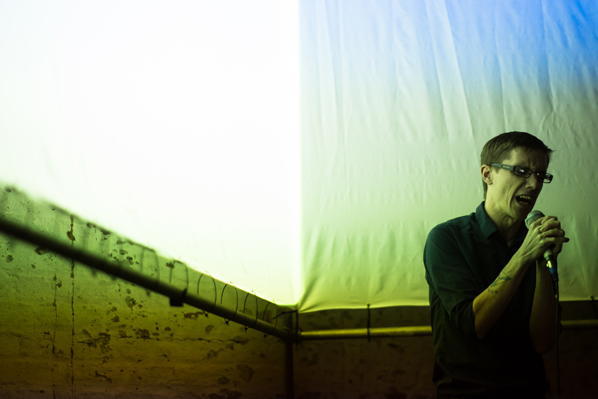
A live performance-cum-guided-meditation, SHRINE was made in collaboration with the band Outfit and performed by lead guitarist Nick Hunt. Against the backdrop of a consistent electronic hum, the light of multiple projections alternates to produce a strobe-like effect. After the instruction to close our eyes, a distant reverberant monologue begins: “What is the meaning of asteroid? What is the meaning of baptism?” The warm flicker on the interior of the eyelid creates a soft trance-like state and the potential hypnotic suggestion washes over us. The minimal rhythmic repetition of this basic structure continues, but strays further and further from these initial references. What is the meaning of blurred lines? … Chandelier? … D-Day? … FIFA? Alliteration and rhyming abound. Selfie. Sophie. Stonehenge. Peter Pan. Quran. Ramadan. There is an emptying out of meaning, and a breakdown of language. KKK … K. The voice has a haunted quality, that of an entity in a state beyond being human. Perhaps it is the voice of the network, which the monologue refers to as ‘watching over us’, of ‘being busy’. It promises a revelation that is coming, that is now, another world, one that we don’t reach. Ultimately it leaves us cleansed, or rinsed out. Then I learn that the work was written with the assistance of Google Instant predictions, hence the alphabetical concatenation of words. Not so far from the network watching over us after all.
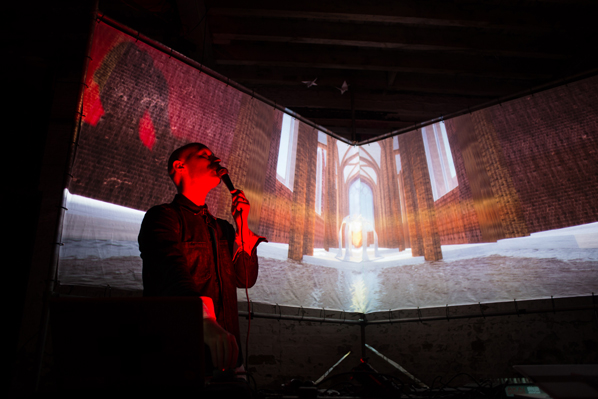
Lawrence Lek and Siôn Parkinson’s performance is the result of a short residency leading-up to the event, and therefore has a more involved relation to Syndrome. This residency structure is a recurring feature of the programme, with past residents including K回iro (Holly Herndon and Mathew Dryhurst), and before that Jamie Gledhill and Stefan Kassozoglou. Whereas these past examples involved existing partnerships, Lek and Parkinson’s collaboration was the first time that Syndrome brought together two artists, placing Parkinson’s vocal performance inside the digital landscape created by Lek.
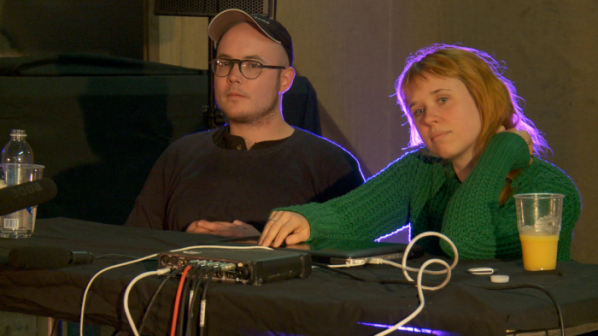
A simulation of Liverpool’s Anglican Cathedral frames the performance, and provides an imagined perspective on this familiar architecture. Starting from a removed position – with the spectral cathedral in the distance – we roam through a wood, trees blowing in the wind. This landscape glitches in a way familiar to the experience of online or virtual worlds, and is accompanied by a soundscape produced by Lek on guitar and electronics. Gradually approaching our destination, bells peal, and further sounds produced begin to resemble those of an organ, groaning and droning as we enter its interior. Parkinson’s body is silhouetted against the projected architecture, his head bathed in red light and his voice rising as Lek’s audio recedes into the background. An otherworldly sermon tells of teeth wrenched out from a mouth to form the keyboard console of the church organ. Moving from sung to spoken word, to deep guttural noises. Rumbling bass emanating from the body, amplified, and shaking the room. Lek’s guitar returns, and there is the liquid crackle of noise as water rolls down the walls, and fire inhabits the projected interior. Our point-of-view rises high above the cathedral, and we see it situated in a landscape abundant with lakes and islands, like some stretched-out fantasy where this iconic building is removed from its physical context – as though transplanted from Liverpool to another world.
These mystical images continue through to the final performance by Lars The Contemporary Future Holdus (TCF). Projecting an increasingly entangled use of technology, he plays with encryption, code and algorithms to construct a subdued visual and sonic space. Twisted and distorted beeps shudder as fragments of sound screech and scrape along the digital surface, and liquid forms slip across the projected image. This precise construction appears to breathe, the sonic utterances repeatedly sucked back inside themselves as the molten amorphous form visually expands and contracts like something from within the bodily interior. There are moments where a mouth/voice emerges, a digital blob talking to us in a language that we cannot comprehend. Behind this audio-visual surface there is something else going on, something that Lars Holdus is engrossed within as he operates the TCF system – tinkering with the algorithm to progress through a series of potential compositions. Yet despite this, I feel largely disconnected – lacking in empathy – as though missing something in what is going on. There is an evident penchant for the opaque, that creates a distance between TCF and the audience, potentially even alienates. This is acknowledged by the artist, who states: “even the presentation is an encryption in itself. And therefore the people that won’t be triggered like that won’t access it.”1 I clearly fail to trigger, and my access is denied.
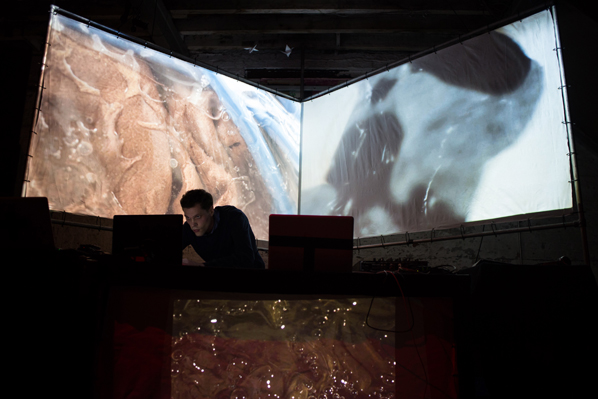
Syndrome is creating a space for artists, musicians and coders to experiment with work that merges electronic music and spoken word performance. The affordance offered by the flexibility of the venue has allowed an approach that would not have been possible within a space in daily use. These latest performative responses make clear that is it not about offering concrete proposals about what is going to happen, before they have time to come into being. Rather, what we witness is artists playing with the resources available, and figuring out what these things might do to us. There is a genuine openness and a potential intimacy to this approach, as well as the acceptance that the results will not always connect or affect audiences in the ways that they might be hope.
Different types of voice seem central to the three works presented within The Post-Human Gospel, affecting the human vocal output as well as trying to give voice to instruments, electronics and digital space. There is something in this that Holly Herndon has described as a “fleshy approach to machinery”, where these digital tools can take on a post-human quality, one that can become or embody different identities. This looks set to continue with the forthcoming event Brain/Music Experiments where artist Dave Lynch, neuroscientist Christophe de Bezenac and deaf classical musicians Ruth Montgomery and Danny Lane explore the ways a brain wave scanner can contribute to live music and visual performance.
The intention for Syndrome is to learn from all the visiting artists and the performances they create in this exploratory year. Looking for moments when performances create affective interfaces to communicate with people. Where they speculate on, or re-conceive, the relationship between human and technology. If they go on to develop a new live experience with the artistic community that surrounds Syndrome – as they suggest they will – I look forward to experiencing how the cumulative knowledge built up through these earlier events is harnessed to final affect.
Featured image: Image “earth” by Beth Scupham https://goo.gl/ZMBzuw (Creative Commons Attribution)
Brett Scott is the author of The Heretic’s Guide to Global Finance: Hacking the Future of Money (Pluto Press: 2013). And writes for various publications, including The Guardian, Wired Mag and New Scientist, and commentate on issues like financial reform, cryptocurrency and peer-to-peer systems. he is also involved in projects related to alternative finance, financial activism, and economic justice, such as Action Aid, World Development Movement, Open Oil, The Finance Innovation Lab, and MoveYourMoney UK.
In Kim Stanley Robinson’s epic 1993 sci-fi novel Red Mars, a pioneering group of scientists establish a colony on Mars. Some imagine it as a chance for a new life, run on entirely different principles from the chaotic Earth. Over time, though, the illusion is shattered as multinational corporations operating under the banner of governments move in, viewing Mars as nothing but an extension to business-as-usual.
It is a story that undoubtedly resonates with some members of the Bitcoin community. The vision of a free-floating digital cryptocurrency economy, divorced from the politics of colossal banks and aggressive governments, is under threat. Take, for example, the purists at Dark Wallet, accusing the Bitcoin Foundation of selling out to the regulators and the likes of the Winklevoss Twins.
Bitcoin sometimes appears akin to an illegal immigrant, trying to decide whether to seek out a rebellious existence in the black-market economy, or whether to don the slick clothes of the Silicon Valley establishment. The latter position – involving publicly accepting regulation and tax whilst privately lobbying against it – is obviously more acceptable and familiar to authorities.
Of course, any new scene is prone to developing internal echo chambers that amplify both commonalities and differences. While questions regarding Bitcoin’s regulatory status lead hyped-up cryptocurrency evangelists to engage in intense sectarian debates, to many onlookers Bitcoin is just a passing curiosity, a damp squib that will eventually suffer an ignoble death by media boredom. It is a mistake to believe that, though. The core innovation of Bitcoin is not going away, and it is deeper than currency.
What has been introduced to the world is a method to create decentralised peer-validated time-stamped ledgers. That is a fancy way of saying it is a method for bypassing the use of centralised officials in recording stuff. Such officials are pervasive in society, from a bank that records electronic transactions between me and my landlord, to patent officers that record the date of new innovations, to parliamentary registers noting the passing of new legislative acts.
The most visible use of this technical accomplishment is in the realm of currency, though, so it is worth briefly explaining the basics of Bitcoin in order to understand the political visions being unleashed as a result of it.

Banks are information intermediaries. Gone are the days of the merchant dumping a hoard of physical gold into the vaults for safekeeping. Nowadays, if you have ‘£350 in the bank’, it merely means the bank has recorded that for you in their data centre, on a database that has your account number and a corresponding entry saying ‘350’ next to it. If you want to pay someone electronically, you essentially send a message to your bank, identifying yourself via a pin or card number, asking them to change that entry in their database and to inform the recipient’s bank to do the same with the recipient’s account.
Thus, commercial banks collectively act as a cartel controlling the recording of transaction data, and it is via this process that they keep score of ‘how much money’ we have. To create a secure electronic currency system that does not rely on these banks thus requires three interacting elements. Firstly, one needs to replace the private databases that are controlled by them. Secondly, one needs to provide a way for people to change the information on that database (‘move money around’). Thirdly, one needs to convince people that the units being moved around are worth something.
To solve the first element, Bitcoin provides a public database, or ledger, that is referred to reverently as the blockchain. There is a way for people to submit information for recording in the ledger, but once it gets recorded, it cannot be edited in hindsight. If you’ve heard about bitcoin ‘mining’ (using ‘hashing algorithms’), that is what that is all about. A scattered collective of mercenary clerks essentially hire their computers out to collectively maintain the ledger, baking (or weaving) transaction records into it.
Secondly, Bitcoin has a process for individuals to identify themselves in order to submit transactions to those clerks to be recorded on that ledger. That is where public-key cryptography comes in. I have a public Bitcoin address (somewhat akin to my account number at a bank) and I then control that public address with a private key (a bit like I use my private pin number to associate myself with my bank account). This is what provides anonymity.
The result of these two elements, when put together, is the ability for anonymous individuals to record transactions between their bitcoin accounts on a database that is held and secured by a decentralised network of techno-clerks (‘miners’). As for the third element – convincing people that the units being transacted are worth something – that is a more subtle question entirely that I will not address here.
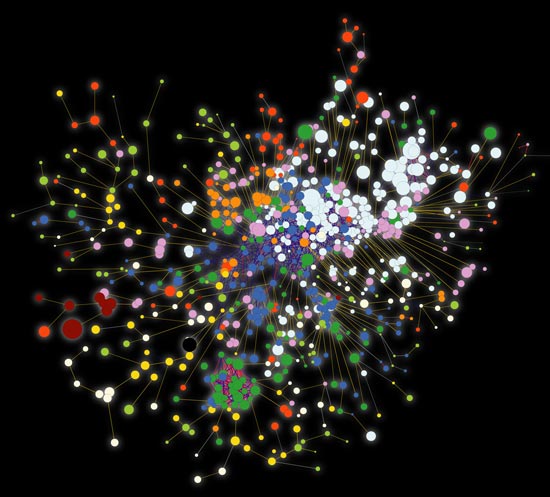
Note the immediate political implications. Within the Bitcoin system, a set of powerful central intermediaries (the cartel of commercial banks, connected together via the central bank, underwritten by government), gets replaced with a more diffuse network intermediary, apparently controlled by no-one in particular.
This generally appeals to people who wish to devolve power away from banks by introducing more diversity into the monetary system. Those with a left-wing anarchist bent, who perceive the state and banking sector as representing the same elite interests, may recognise in it the potential for collective direct democratic governance of currency. It has really appealed, though, to conservative libertarians who perceive it as a commodity-like currency, free from the evils of the central bank and regulation.
The corresponding political reaction from policy-makers and establishment types takes three immediate forms. Firstly, there are concerns about it being used for money laundering and crime (‘Bitcoin is the dark side’). Secondly, there are concerns about consumer protection (‘Bitcoin is full of cowboy operators’). Thirdly, there are concerns about tax (‘this allows people to evade tax’).
The general status quo bias of regulators, who fixate on the negative potentials of Bitcoin whilst remaining blind to negatives in the current system, sets the stage for a political battle. Bitcoin enthusiasts, passionate about protecting the niche they have carved out, become prone to imagining conspiratorial scenes of threatened banks fretfully lobbying the government to ban Bitcoin, or of paranoid politicians panicking about the integrity of the national currency.

Outside the media hype around these Bitcoin dramas, though, a deeper movement is developing. It focuses not only on Bitcoin’s potential to disrupt commercial banks, but also on the more general potential for decentralised blockchains to disrupt other types of centralised information intermediaries.
Copyright authorities, for example, record people’s claims to having produced a unique work at a unique date and authoritatively stamp it for them. Such centralised ‘timestamping’ more generally is called ‘notarisation’. One non-monetary function for a Bitcoin-style blockchain could thus be to replace the privately controlled ledger of the notary with a public ledger that people can record claims on. This is precisely what Proof of Existence and Originstamp are working on.
And what about domain name system (DNS) registries that record web addresses? When you type in a URL like www.e-ir.info, the browser first steers you to aDNS registry like Afilias, which maintains a private database of URLs alongside information on which IP address to send you to. One can, however, use a blockchain to create a decentralised registry of domain name ownership, which is what Namecoin is doing. Theoretically, this process could be used to record share ownership, land ownership, or ownership in general (see, for example, Mastercoin’s projects).
The biggest information intermediaries, though, are often hidden in plain sight. What is Facebook? Isn’t it just a company that you send information to, which is then stored in their database and subsequently displayed to you and your friends? You log in with your password (proving your identity), and then can alter that database by sending them further messages (‘I’d like to delete that photo’). Likewise with Twitter, Dropbox, and countless other web services.
Unlike the original internet, which was largely used for transmission of static content, we experience sites like Facebook as interactive playgrounds where we can use programmes installed in some far away computer. In the process of such interactivity, we give groups like Facebook huge amounts of information. Indeed, they set themselves up as information honeytraps in order to create a profit-making platform where advertisers can sell you things based on the information. This simultaneously creates a large information repository for authorities like the NSA to browse. This interaction of corporate power and state power is inextricably tied to the profitable nature of centrally held data.
But what if you could create interactive web services that did not revolve around single information intermediaries like Facebook? That is precisely what groups like Ethereum are working towards. Where Bitcoin is a way to record simple transaction information on a decentralised ledger, Ethereum wants to create a ‘decentralised computational engine’. This is a system for running programmes, or executing contracts, on a blockchain held in play via a distributed network of computers rather than Mark Zuckerberg’s data centres.
It all starts to sounds quite sci-fi, but organisations like Ethereum are leading the charge on building ‘Decentralised Autonomous Organisations’, hardcoded entities that people can interact with, but that nobody in particular controls. I send information to this entity, triggering the code and setting in motion further actions. As Bitshares describes it, such an organisation “has a business plan encoded in open source software that executes automatically in an entirely transparent and trustworthy manner.”
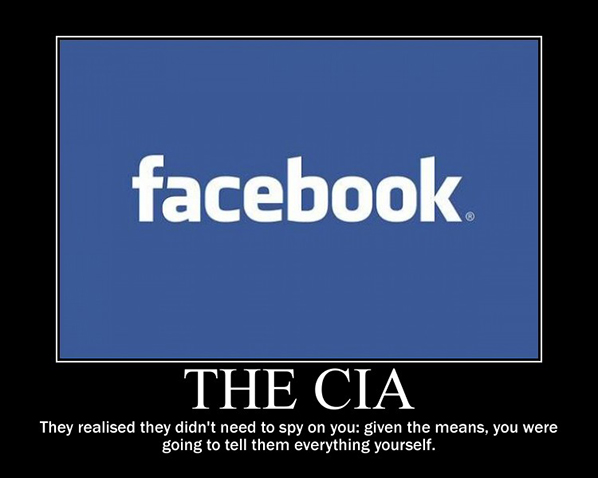
By removing a central point of control, decentralised systems based on code – whether they exist to move Bitcoin tokens around, store files, or build contracts – resemble self-contained robots. Mark Zuckerberg of Facebook or Jamie Dimon of JP Morgan Chase are human faces behind the digital interface of the services they run. They can overtly manipulate, or bow in to pressure to censor. A decentralised currency or a decentralised version of Twitter seems immune from such manipulation.
It is this that gives rise to a narrative of empowerment and, indeed, at first sight this offers an exhilarating vision of self-contained outposts of freedom within a world otherwise dominated by large corruptible institutions. At many cryptocurrency meet-ups, there is an excitable mix of techno-babble infused with social claims. The blockchain can record contracts between free individuals, and if enforcement mechanisms can be coded in to create self-enforcing ‘smart contracts’, we have a system for building encoded law that bypasses states.
Bitcoin and other blockchain technologies, though, are empowering right now precisely because they are underdogs. They introduce diversity into the existing system and thereby expand our range of tools. In the minds of hardcore proponents, though, blockchain technologies are more than this. They are a replacement system, superior to existing institutions in every possible way. When amplified to this extreme, though, the apparently utopian project can begin to take on a dystopian, conservative hue.
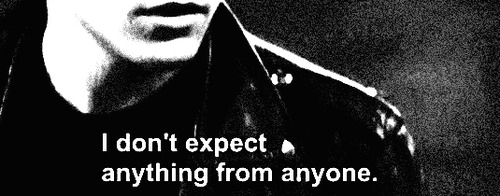
When asked about why Bitcoin is superior to other currencies, proponents often point to its ‘trustless’ nature. No trust needs be placed in fallible ‘governments and corporations’. Rather, a self-sustaining system can be created by individuals following a set of rules that are set apart from human frailties or intervention. Such a system is assumed to be fairer by allowing people to win out against those powers who can abuse rules.
The vision thus is not one of bands of people getting together into mutualistic self-help groups. Rather, it is one of individuals acting as autonomous agents, operating via the hardcoded rules with other autonomous agents, thereby avoiding those who seek to harm their interests.
Note the underlying dim view of human nature. While anarchist philosophers often imagine alternative governance systems based on mutualistic community foundations, the ‘empowerment’ here does not stem from building community ties. Rather it is imagined to come from retreating from trust and taking refuge in a defensive individualism mediated via mathematical contractual law.
It carries a certain disdain for human imperfection, particularly the imperfection of those in power, but by implication the imperfection of everyone in society. We need to be protected from ourselves by vesting power in lines of code that execute automatically. If only we can lift currency away from manipulation from the Federal Reserve. If only we can lift Wikipedia away from the corruptible Wikimedia Foundation.
Activists traditionally revel in hot-blooded asymmetric battles of interest (such as that between StrikeDebt! and the banks), implicitly holding an underlying faith in the redeemability of human-run institutions. The Bitcoin community, on the other hand, often seems attracted to a detached anti-politics, one in which action is reduced to the binary options of Buy In or Buy Out of the coded alternative. It echoes consumer notions of the world, where one ‘expresses’ oneself not via debate or negotiation, but by choosing one product over another. We’re leaving Earth for Mars. Join if you want.
It all forms an odd, tense amalgam between visions of exuberant risk-taking freedom and visions of risk-averse anti-social paranoia. This ambiguity is not unique to cryptocurrency (see, for example, this excellent parody of the trustless society), but in the case of Bitcoin, it is perhaps best exemplified by the narrative offered by Cody Wilson in Dark Wallet’s crowdfunding video. “Bitcoin is what they fear it is, a way to leave… to make a choice. There’s a system approaching perfection, just in time for our disappearance, so, let there be dark”.

But where exactly is this perfect system Wilson is disappearing to?
Back in the days of roving bands of nomadic people, the political option of ‘exit’ was a reality. If a ruler was oppressive, you could actually pack up and take to the desert in a caravan. The bizarre thing about the concept of ‘exit to the internet’ is that the internet is a technology premised on massive state and corporate investment in physical infrastructure, fibre optic cables laid under seabeds, mass production of computers from low-wage workers in the East, and mass affluence in Western nations. If you are in the position to be having dreams of technological escape, you are probably not in a position to be exiting mainstream society. You are mainstream society.
Don’t get me wrong. Wilson is a subtle and interesting thinker, and it is undoubtedly unfair to suggest that he really believes that one can escape the power dynamics of the messy real world by finding salvation in a kind of internet Matrix. What he is really trying to do is to invoke one side of the crypto-anarchist mantra of ‘privacy for the weak, but transparency for the powerful’.
That is a healthy radical impulse, but the conservative element kicks in when the assumption is made that somehow privacy alone is what enables social empowerment. That is when it turns into an individualistic ‘just leave me alone’ impulse fixated with negative liberty. Despite the rugged frontier appeal of the concept, the presumption that empowerment simply means being left alone to pursue your individual interests is essentially an ideology of the already-empowered, not the vulnerable.
This is the same tension you find in the closely related cypherpunk movement. It is often pitched as a radical empowerment movement, but as Richard Boase notes, it is “a world full of acronyms and codes, impenetrable to all but the most cynical, distrustful, and political of minds.” Indeed, crypto-geekery offers nothing like an escape from power dynamics. One merely escapes to a different set of rules, not one controlled by ‘politicians’, but one in the hands of programmers and those in control of computing power.
It is only when we think in these terms that we start to see Bitcoin not as a realm ‘lacking the rules imposed by the state’, but as a realm imposing its own rules. It offers a form of protection, but guarantees nothing like ‘empowerment’ or ‘escape’.
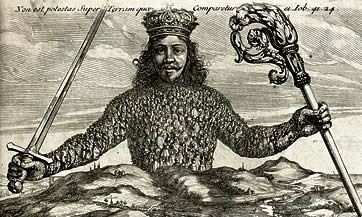
Technology often seems silent and inert, a world of ‘apolitical’ objects. We are thus prone to being blind to the power dynamics built into our use of it. For example, isn’t email just a useful tool? Actually, it is highly questionable whether one can ‘choose’ whether to use email or not. Sure, I can choose between Gmail or Hotmail, but email’s widespread uptake creates network effects that mean opting out becomes less of an option over time. This is where the concept of becoming ‘enslaved to technology’ emerges from. If you do not buy into it, you will be marginalised, and thatis political.
This is important. While individual instances of blockchain technology can clearly be useful, as a class of technologies designed to mediate human affairs, they contain a latent potential for encouraging technocracy. When disassociated from the programmers who design them, trustless blockchains floating above human affairs contains the specter of rule by algorithms. It is a vision (probably accidently) captured by Ethereum’s Joseph Lubin when he says “There will be ways to manipulate people to make bad decisions, but there won’t be ways to manipulate the system itself”.
Interestingly, it is a similar abstraction to that made by Hobbes. In his Leviathan, self-regarding people realise that it is in their interests to exchange part of their freedom for security of self and property, and thereby enter into a contract with aSovereign, a deified personage that sets out societal rules of engagement. The definition of this Sovereign has been softened over time – along with the fiction that you actually contract to it – but it underpins modern expectations that the government should guarantee property rights.
Conservative libertarians hold tight to the belief that, if only hard property rights and clear contracting rules are put in place, optimal systems spontaneously emerge. They are not actually that far from Hobbes in this regard, but their irritation with Hobbes’ vision is that it relies on politicians who, being actual people, do not act like a detached contractual Sovereign should, but rather attempt to meddle, make things better, or steal. Don’t decentralised blockchains offer the ultimate prospect of protected property rights with clear rules, but without the political interference?
This is essentially the vision of the internet techno-leviathan, a deified crypto-sovereign whose rules we can contract to. The rules being contracted to are a series of algorithms, step by step procedures for calculations which can only be overridden with great difficulty. Perhaps, at the outset, this represents, à la Rousseau, the general will of those who take part in the contractual network, but the key point is that if you get locked into a contract on that system, there is no breaking out of it.
This, of course, appeals to those who believe that powerful institutions operate primarily by breaching property rights and contracts. Who really believes that though? For much of modern history, the key issue with powerful institutions has not been their willingness to break contracts. It has been their willingness to use seemingly unbreakable contracts to exert power. Contracts, in essence, resemble algorithms, coded expressions of what outcomes should happen under different circumstances. On average, they are written by technocrats and, on average, they reflect the interests of elite classes.
That is why liberation movements always seek to break contracts set in place by old regimes, whether it be peasant movements refusing to honour debt contracts to landlords, or the DRC challenging legacy mining concessions held by multinational companies, or SMEs contesting the terms of swap contracts written by Barclays lawyers. Political liberation is as much about contesting contracts as it is about enforcing them.
The point I am trying to make is that you do not escape the world of big corporates and big government by wishing for a trustless set of technologies that collectively resemble a technocratic crypto-sovereign. Rather, you use technology as a tool within ongoing political battles, and you maintain an ongoing critical outlook towards it. The concept of the decentralised blockchain is powerful. The cold, distrustful edge of cypherpunk, though, is only empowering when it is firmly in the service of creative warm-blooded human communities situated in the physical world of dirt and grime.
Perhaps this means de-emphasising the focus on how blockchains can be used to store digital assets or property, and focusing rather on those without assets. For example, think of the potential of blockchain voting systems that groups like Restart Democracy are experimenting with. Centralised vote-counting authorities are notorious sources of political anxiety in fragile countries. What if the ledger recording the votes cast was held by a decentralised network of citizens, with voters having a means to anonymously transmit votes to be stored on a publicly viewable database?
We do not want a future society free from people we have to trust, or one in which the most we can hope for is privacy. Rather, we want a world in which technology is used to dilute the power of those systems that cause us to doubt trust relationships. Screw escaping to Mars.
If you enjoyed this article, please consider…
I sometimes spend weeks writing these articles, and don’t generally get paid to do it, so if you enjoyed please consider doing one or two of the following:
1. Donate by buying me a virtual beer
2. Tweet: You can tweet it out here
3. Share it on your Facebook wall here
4. Email it to a friend from here
5. Leave a comment!
6. Submit to Reddit
7. Link to the article from your own blog so your readers can see it too
Cheers!
(Please note that I originally wrote this essay for E-International Relations, and I have republished it here on a Creative Commons licence. If you wish to republish this piece, please respect E-IR’s republishing guidelines)
Featured image: Stern, Body Language
Interactive Art and Embodiment: The Implicit Body As Performance by Nathaniel Stern. ISBN 978-1-78024-009-1 (printed publication), Gylphi Limited, Canterbury, UK, 2013. 291 pp., 41 Colour Stills.

Earlier this year, I had the good fortune to sit in on a talk given by Simon Penny on May 6th 2014 at the University of Exeter. Penny, not unlike Nathaniel Stern, is best known for his praxis, writing and teaching on interactive (and robotic) installations focusing on issues of embodiment, relationality and materiality. So as unorthodox as its inclusion is to start off a review, Penny’s reflections are pertinent here (in this case, Penny’s famous installations Fugitive (1997) and Traces (1999) [1].
The purpose of Fugitive and Traces (if you can say they had one) sought to ‘embody’ virtual reality through multi-camera infra-red sensors, visual models and real-time movements. At that time, Penny’s unique theoretical take was to distance human-computer interaction away from “a system of abstracted and conventionalised signals” to where the user would “communicate kinesthetically”: instead of investigating the non-human or “inhuman” formal qualities of its medium, or some vague VR future that leaves the body behind, the system itself would “come closer to the native sensibilities of the human.” (Penny) [2]
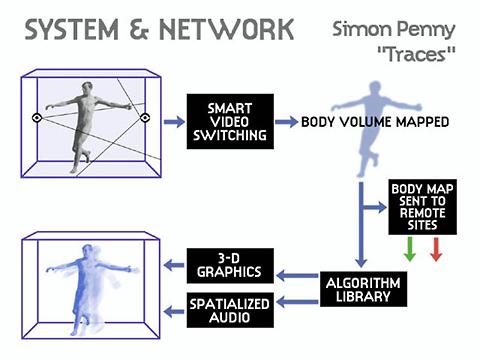

In his Exeter talk, Penny momentarily reflected on a weird and altogether disturbing seventeen year feedback loop. The loop in question relates to how, in 2014, Penny’s early avant-garde ideas and theoretical ambitions have largely been desecrated by their replication in big business. With regard to Traces, Penny cited Microsoft’s Kinect as being the most salient example of this desecration: Kinect’s technology – marketed for the Xbox console brand – carries within its insidious techniques the ability to also “communicate kine[c]thetically”, but do so within pre-packaged, patented, IP-driven, focus-grouped-out-of-existence, commercial vacuities of gamer experience.

As an early practitioner and developer of these technologies, Penny was somewhat visibly infuriated with this, and understandably so. For him, it unintentionally reduced his aesthetic experimentation, philosophical insight, technological futurity and theoretical complexity into consumer speculation for the technology market, commandeering the tech but without the value. It transposed the artistic technological avant-garde necessity of Traces into a flaccid ‘tech-demo’ demonstration of novelty limb flailing and high-end visuals devoid of anything. It was, Penny lamented, “a very weird situation” to be in. Part of that weirdness has to do with the fact that Penny hadn’t done anything especially wrong, because there wasn’t any tangible aesthetic qualities that separated his pioneering work from Microsoft’s effort. Neither had Penny’s work brought financial success with its value intact (because its value wasn’t patentable). Instead technological development had overwritten the aesthetic value of Traces, trading technological obsolescence with aesthetic obsolescence.

Penny’s retroactive predicament is not unique in the history of digital art: for all the visionary seeds of potential in Roy Ascott’s legendary networking project, Terminal Art (1980) we now recognise how those salient characteristics have somehow ended up as Skype or Google Hangouts. Still in the 80s, one might evoke Eduardo Kac’s early videotext works (1985-1986) where visual animated poems were broadcast on the online service exchange platform Minitel (“Médium interactif par numérisation d’information téléphonique” or “Interactive medium by digitalizing telephone information” in its French iteration): a proprietary precursor to the World Wide Web [3]. The retroactive weirdness accompanying these developments is something I’ll come back to: suffice to say that what counts is the direction (and sometimes hostile return) of infrastructure, not just as the background collection of assemblages artists rely on to experiment with at any historical moment, but the shifting ecological foundations to which technology emerges, affords, and now overwrites such practices. No-one likes to play devil’s advocate and yet one must ask the question specific to Stern’s text: what, or maybe where, is the tangible point at which ‘art’ becomes historically valued in these works, if that latent aesthetic potential becomes just another market for a series of Silicon Valley, or startup conglomerates?
——–
Nathaniel Stern’s Interactive Art and Embodiment establishes two first events: not only Stern’s debut publication but also the first of a new series from Gylphi entitled “Arts Future Book” edited by Charlotte Frost, which began in 2013. All quotations are from this text unless otherwise stated.
Stern’s vision in brief: in order to rescue what is philosophically significant about interactive art, he justifies its worth through the primary acknowledgement of embodiment, relational situation, performance and sensation. In return, the usual dominant definitions of interactive art which focus on technological objects, or immaterial cultural representations thereof are secondary to the materiality of bodily movement. Comprehending digital interactive art purely as ‘art + technology’ is a secondary move and a “flawed priority” (6), which is instead underscored by a much deeper engagement, or framing, for how one becomes embodied in the work, as work. “I pose that we forget technology and remember the body” (6) Stern retorts, which is a “situational framework for the experience and practice of being and becoming.” (7). The concepts that are needed to disclose these insights are also identified as emergent.
“Sensible concepts are not only emerging, but emerging emergences: continuously constructed and constituted, re-constructed and re-constituted, through relationships with each other, the body, materiality, and more.” (205)
Interactive Art and Embodiment then, is the critical framework that engages, enriches and captivates the viewer with Stern’s vision, delineating the importance of digital interactive art together with its constitutive philosophy.
One might summarise Stern’s effort with his repeated demand to reclaim the definition of “interactive”. The term itself was a blatantly over-used badge designed to vaguely discern what made ‘new media’ that much newer, or freer than previous modes of consumption. This was quickly hunted out of discursive chatter when everyone realised the novel qualities it offered meant very little and were politically moribund. For Stern however, interactivity is central to the entire position put forward, but only insofar as it engages how a body acts within such a work. This reinvigorated definition of “interactive” reinforces deeper, differing qualities of sensual embodiment that take place in one’s relational engagement. This is to say, how one literally “inter-acts” through moving-feeling-thinking as a material bodily process, and not a technological informational entity which defines, determines or formalises its actions. A digital work might only be insipidly interactive, offering narrow computational potentials, but this importance is found wanting so long as the technology is foregrounded over ones experience of it. Instead ones relationship with technological construction should melt away through the implicit duration of a body that literally “inter-acts” with it. In Stern’s words:
“…most visually-, technically-, and linguistically-based writing on interactive art explains that a given piece is interactive, and how it is interactive, but not how we inter-act” (91)
Chapter 1 details how aesthetic ‘vision’ is understood through this framework, heavily criticising the pervasive disembodiment Stern laments in technical discussions of digital art and the VR playgrounds from the yesteryear of the 90s. Digital Interactive Art has continually suppressed a latent embodied performance that widens the disembodied aesthetic experience towards – following Ridgway and Thrift – a “non-representational experience.” Such experiences take the body as an open corporal process within a situation, which includes, whilst also encompassing, the corporal materiality of non-human computational processes. This is, clearly, designed to oppose any discourse that treats computation and digital culture as some sort of liberating, inane, immaterial phenomenon: to which Stern is absolutely right. Moreover, all of these material processes move in motion with embodied possibilities, to “create spaces in which we experience and practice this body, its agency, and how they might become.” (40) To add some political heft, Stern contrasts how the abuse of interactivity is often peddled towards consumerist choice, determining possibilities, put against artistic navigation that relinquishes control, allowing limitless possibilities. Quoting Erin Manning, Stern values interactive art’s success when it doesn’t just move in relation to human experience, but when humans move *the* relation in experience (Manning, 2009: 64; Stern, 46).
Stern’s second chapter moves straight into a philosophical discussion denoting what he means by an anti-Cartesian, non-representational, or implicit body. Heavily contexualised by a host of process, emergent materialist thinkers (Massumi, Hayles, Barad), Stern concentrates on the trait of performance as the site of body which encapsulates its relationally, emergence and potential. The body is not merely formed in stasis, (what Stern dubs “pre-formed” (62) but is regularly and always gushingly “per-formed” (61) in its movement. Following Kelli Fuery, the kind of interactivity Stern wants to foreground is always there, not a stop-start prop literate to computer interaction, but an effervescent ensemble of “becoming interactive” (Fuery, 2009: 44; Stern, 65). Interactive art is not born from an effect bestowed by a particular medium of art making, but of “making literal the kinds of assemblages we are always a part of.” (65)

Chapter three sets out Stern’s account for the implicit body framework: detailing out four areas: “artistic inquiry and process; artwork description; inter-activity and relationally.” (91) Chapters four, five and six flesh out this framework with actual practices. Four considers close readings of the aforementioned work of Penny together with Camille Utterback merging the insights gained from the previous chapters. What both artists encapsulate for Stern is that their interventions focus on the embodied activities of material signification: or “the activities of writing with the body” (114) Utterback’s 1999 installation “Textrain” is exemplary to Stern’s argument: notably the act of collecting falling text characters on a screen merges dynamic body movements with poetic disclosure. The productions of these images are always emergent and inscribed within our embodied practices and becomings: that we think with our environment. Five re-contextualises this with insights into works by Scott Scribbes and Mathieu Briand’s interventions in societal norms and environments. Six takes on the role of the body as a dynamic, topological space: most notably as practiced in Rafael Lozano-Hemmer. Chapter seven I’ll discuss near the conclusion: the last chapter shortly.
Firstly, the good stuff. Interactive Art and Embodiment is probably one of the most sincerest reads I’ve encountered in the field for some time. Partly this is because the book cultivates Stern’s sincerity for his own artistic practice, together with his own philosophical accounts that supplement that vision. His deep understanding of process philosophy is clearly matched by his enthusiastic reassessment of what interactive art purports to achieve and how other artists might have achieved it too. And it’s hard to disagree with Stern’s own position when he cites examples (of his work and others) that clearly delegate the philosophical insights to which he is committed. One highlight is Stern’s take on Scribbes’ Boundary Foundations (1998) and the Screen Series (2002-03) which intervenes and questions the physical and metaphorical boundaries surrounding ourselves and others, by performing its questioning as work. This is a refreshingly earnest text, proving that theory works best not when praxis matches the esoteric fashions of philosophical thinking, but when art provides its own stakes and its own types of thinking-experience which theory sets out to faithfully account and describe. Stern’s theoretical legitimacy is never earned from just digesting, synthesising and applying copious amounts of philosophy, but from the centrality of describing in detail what he thinks the bodily outcomes of interactive art are and what such accounts have to say: even if they significantly question existing philosophical accounts.
Stern leaves the most earnest part of his book towards the end in his final semi-auto-biographical companion chapter called “In Production (A Narrative Inquiry on Interactive Art)”. This is a snippet of a much larger story, available online and subject to collaboration [4]. Here, Stern recounts or modifies the anxiety inducing experience of being a PhD student and artist, rubbing up alongside the trials of academic rigour, dissertation writing and expected standards. Quite simply, Stern is applying his insights of performative processual experience into the everyday, ordinary experiences faced by most PhD students in this field, and using it to justify a certain writing style and a sense of practice. It’s an enjoyable affair – in large part because it outclasses the dry scholarly tone usually associated with writing ‘academically’, elevating imaginative, illuminating redescriptions for how the experiences of interactive art broadly hang together rather than relying on relentless cynical critique. And most of that is down to Stern’s strong literary metaphorical technique for grounding his vision, perhaps even more effectively than the previous chapters.
Yet earnest experiences aside, there are two problems with Stern’s vision which, in my eyes, leave it flawed. That isn’t a bad thing: all visions are flawed of course. That’s why the similarities between art and philosophy feed our heuristic, academic compulsion to come up with them and debate: well, that and sometimes the most flawed can end up being the most influential. Such flaws only arise in relation to what Stern thinks is valuable in interactive art, and to the extent that the intervention posed may require readdressing. The flaws in question are composed from two different angles, but stem from one objection. The first is philosophical, or at least a problem pre-packaged with relying almost entirely on relational ideas of embodied emergence. The second is more tied to infrastructure and technical expropriation as outlined in Penny’s predicament given from the outset.
In his introduction, Stern makes clear that this is an “art philosophical book” (4), not a philosophy of art as such: only one that “understands art and philosophy as potential practices of one another” (4). Following Brian Massumi, philosophy “tells us the stakes”, whilst “art brings those states to the table” (5), such that the type of art he values and constructs, (digital interactive art) is precisely that which melts away in its interactive encounter when constructed as work. Later on we discover that interactive art “interrupts relationality” (66), making present an “intervention that brings a situated moving-thinking-feeling to a higher power.” (66) Further on, interactive art does something else, when it “intensifies features of […] the ongoing transformation of the ‘living’ body”, and “gifts us with a state to practice being and becoming.” (73) Reflecting on the infamous Bourriaud/Bishop relational aesthetic ruckus a decade ago, Stern outlines how they focus on the explicit body (82) (how we understand ourselves or challenge explicit social/economic positions in the world), whereas artworks which privilege the implicit body have us “encounter how we move, transform, and are (continuous)” (82) in the world. The former takes on the materiality of social relations, the latter (endorsed by Stern) takes on the whole materiality of “embodied relations” (83). And again to reiterate, art operates as “the practice of contemporary philosophies, where we investigate, and further research on, embodiment and relationally together.” (83).
Now, one should admire how Stern blends philosophy and art praxis together precisely by not shoehorning authoritative philosophical accounts into art praxis where they aren’t needed. This works, precisely as the ontology expressed here actively resists such authoritative accounts as well as being cemented with the sort of sincerity with which Stern has such a keen literary grasp. More importantly, Stern cites works which seem to fit the stakes of his ontological conviction perfectly.
However the reliance of process-based philosophy dampens exactly how these works intervene to bring about the values he so desires. The simplest objection comes from asking how Stern might value anything at all, if our entire relational embodiment with the world is constantly in process – or that “[b]odies and matter are change” (220) – and must be always affirmed as such: why should every process and every bodily interaction be affirmed? Moreover why is it art’s place to give primacy to the ontological events of bodily material change?
This is one of the key infrastructural problems that surface, once a theory of art totally subscribes to a process-based ontology, let alone one focusing on embodiment: why should an artist like Stern feel compelled to present an intervention in the first place? If the dominant ontological movement of interactions is a becoming-event, by what standard or eruption should interactive art be said to work on? If, as Stern believes, “the interactive process in interactive work is the ‘work’” (159), it becomes unclear what value interactive artworks are purported to convey, if that process is all there is. To say that embodied processual events make the work “work”, because they underscore our situational intelligibility (or make it effective – so to speak) speaks nothing of what differential criteria should apply to make that aesthetic intervention intelligible. To hazard a guess, the problem is one of articulating how convention exists in a process ontology: because if everything is always emerging as an interactive event of change, the act of rupturing or intervening in convention becomes a real problem. The criteria for valuing these important works is only affirmed it seems, because every process is already affirmed: and if that’s the case you don’t need artists to make an intervention – there is no intervention required, other than the events that already exist, as change in themselves. To put it another way: why should (and how can) a work effectively gift us heightened states of being and becoming, if our entire situational relationship with the world is already situationally related in being and becoming?
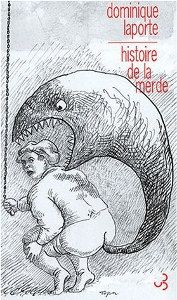
I am reminded of Adrian Johnston’s 2001 review of the newly republished English translation of Dominique Laporte’s History of Shit (first published in 1978). Whereas most Foucaultians and Althusserians were disconcertingly vague in pointing out the concrete material conditions for subjectivity and economical production, Laporte boldly contended that the genealogical hypothesis to all modern civilisations was tied to one concrete material condition: the infrastructure of bodily waste management, or, the desire to control and sublimate our need to defecate. In his usual Žižekian repartee, Johnston suggested that Laporte’s bizarre history of modernity implicitly accepted the anti-Cartesian embodiment thesis (that cognition cannot be separated from the actions of the body), but pushed its logic to the end. That for all the affirmative, encompassing, sensual, emergent, potential images embodiment philosophy prefers to agree and discuss, it completely ignores one of our central and basic bodily requirements: to excrete our bodily waste or fecal matter, and remove it from sight and smell (and we don’t need to remind the reader of art’s fascination with this area).
Whilst Johnston’s tongue was firmly planted in his cheek, he did happen to put a psychoanalytical finger on the central problem with process based embodiment. That often enough, sincere accounts of embodiment designed to affirmatively depict and encompass implicit environment material engagements leave behind an unacknowledged stain: one which says more about these accounts than their proponents actually do. And it is precisely because Stern focuses on the most aesthetically agreeable areas of bodily engagement in interactive art, that something as habitual and ritualistic as the excretion of digested matter, or the infrastructure of sewage networks exposes that image.
In terms of materiality this is doubly important. Laporte’s intervention brings into conflict two competing performative materialisms which disclose our own bodily relationships with non-human processes (in this case, computational and networked material): the first is Stern’s own account of the material body as some sort of ‘nebulous material’ which is always emergent, lived, relational and thinking with its own engagement in the world of humans and non-humans. The second is Laporte’s material body seen as ‘brutal material’ – an explicit input-output, complex, evolutionary processing machine, strictly determinate and bounded in its biological function. Despite Stern arguing earnestly for the nebulous form, it doesn’t appear to me that he can hold off the brutal form, or at least prevent the latter from antagonising the former. And often enough, this happens because Stern’s accounts of embodiment, and the philosopher’s accounts he relies on, are already meant to be nebulous in themselves.
This logic unravels by chapter seven, when Stern expands the implicit body framework to analyse other examples of new media art which aren’t preoccupied with bodily participation to work, as work. He terms this “potentialized art” (206) where “audience members do not *make* the work directly through their interactions (207) but are subject to visual performances of potential movement and relation mediated by generative computation and networks. In citing Gordan Savičić and Jessica Meuninck-Ganger – amongst others – Stern argues that these ongoing performances harness generative information participating in embodiment relations, and invite metaphorical sensory change and bodily movement (in the case of Savičić’s performances, quite literally inflicting pain and suffering onto his own body using network data and social media).
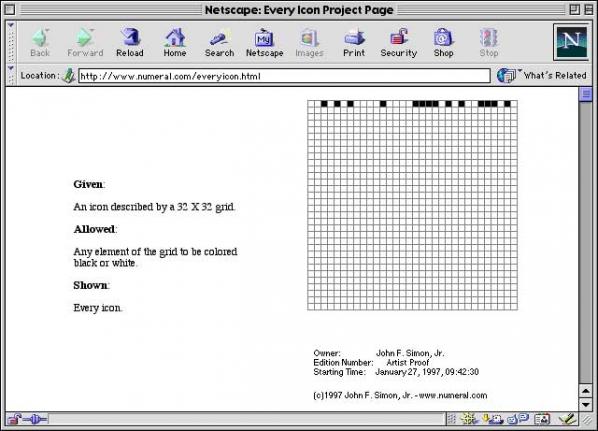
However when Stern cites John F. Simon. Jr’s infamous work Every Icon (1997), (227 – 230) (a cellular automation piece which takes approximately several hundred trillion years to complete) it becomes clear to me that the aesthetically agreeable areas of embodiment start to break down. It might be that my own reading of the piece is fairly unorthodox [5] (I don’t consider the work to be primarily conceptual for a start), but Every Icon eschews what Stern writes as giving “both the corporeal and incorporeal a present and future presence as time and sign” (230) or something that generates attention to our “sensual and conceptual experience of temporality” (230).
Yet, isn’t it the case that Every Icon is probably one of the least potentialised artworks ever made? It doesn’t actually generate anything, (in the strict sense of unpredictable outcomes from simple rules) it simply enumerates configurations of pixels one by one. Neither can we be said to “feel the potency of several hundred trillion years” (230) than we feel the cold, indifferent execution of a real java applet function to which we are forever limited in experiencing directly. If anything, Every Icon is deliberately constructed to forgo a relation with us.

To conclude: this is perhaps why Penny’s predicament with the Kinect is so stark. To demand, as Stern does, that we treat digital interactive art as setting a stage for examining how we “per-form” with our bodies within media, material, conceptual frames and selves, is no longer enough of a stage to give voice to the technological ecologies we find ourselves in: nor of the art that satisfies intervening in it. Credit must be given to Stern for writing over interactive art’s emancipatory myth of disembodied immateriality, but his endorsement of embodiment only serves to realise that the problem isn’t forgetting to focus on material engagement, but forgetting the cold, hard and brutal materiality of procedural performance of infrastructure, that often moves faster than we do. When Microsoft’s Kinect co-opts all the same values of Traces, it does so not because embodiment is totally flawed, but that bodily movement has now become ecologically implicated in deceptive infrastructure.

Just as Penny’s Traces may once have evoked a renewed attention to moving-thinking-feeling, such engagements are now suitably tracked and are in service of non-transparent infrastructures of geo-social activity, which propagate themselves beyond our sensory engagement, yet paradoxically they also indirectly sustain that ordinary engagement. For example, this is now a world where Google funds a 60tbps undersea cable connecting the West Coast to Japan, in order to propagate the reach of their services. The technological engagement of our bodies cannot be restricted to how we move-think-feel, but now weaves itself within layers upon layers of platforms and pervasive surveillance structures. And I don’t disagree with Stern that the implicit body is, perhaps, deeper than the account I give here. But maybe that’s because the body is also another type of performative infrastructure, tightly bound into other formations that are just as deep, complex and engaged. We now live in a time where digital interactive art has to intervene in the performances of geo-social infrastructure: where our bodies have curiously taken on their self-directing performances, rather than our own.
[Notes:
1. These are the minimally reformatted and slightly expanded notes for what would have been a 15-minute presentation.
2. The presentation was meant to be followed by questions and form part of the introduction to a panel discussion. Any questions in the comments here or on netbehaviour gratefully received.]

Art and money have always been involved in each other’s production. This is a Greek Drachma from 600BC with a relief depiction of a sea turtle on one side. For many people this would be the artwork, or at least the image, that they saw most frequently in their everyday lives.
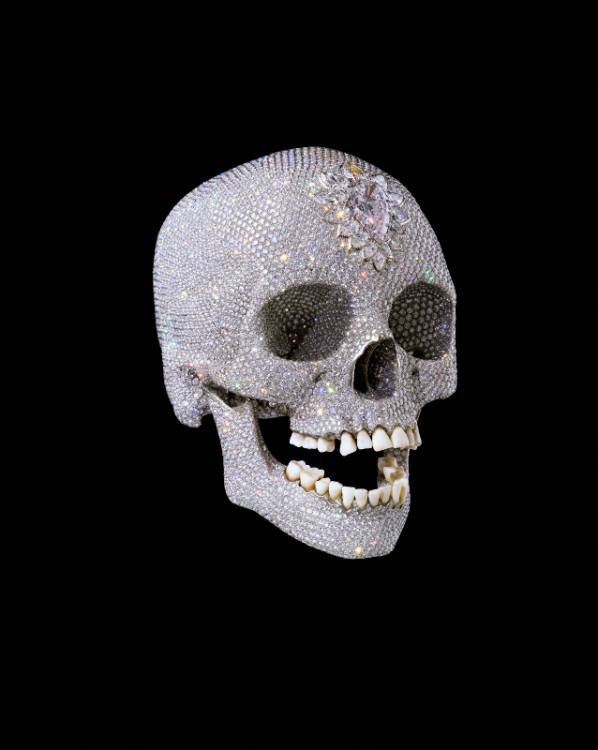
In the present day, high art and high finance (or big art and big finance) go hand in hand. Blue chip artworks produced by brand name artists like Jeff Koons are collected by hedge fund managers and oil oligarchs as investments and as signifiers of socioeconomic position (while stolen Old Master paintings are used as signifiers of value in transactions between criminal gangs…). This tendency reaches its logical conclusion for now with Damien Hirst’s “For The Love of God” (2007), a diamond-encrusted platinum cast of an actual human skull complete with the original teeth. It was sold for fifty million pounds sterling.

Looking inside the sale of “For The Love Of God” makes its narrative less straightforward. It was sold to a group including the artist and their dealer, making the actual figure and its ownership less straightforward than a simple sale would suggest. Nanex’s High Frequency Trading visualizations from 2010 look inside transcations in electronic stocks & shares markets, finding aesthetic forms in the activity of share trading bots. What the sawtooth waves of this bot’s activity represent is unknown: a glitch, a strategy, a side-effect. But without making these forms visible, we would not be able to ask these questions or reflect on this economic activity.

It is part of the value of art, particularly Conceptual Art, that it can afford us these opportunities for reflection and critique. Cildo Meireles’ “Insertions Into Ideological Circuits 2” (1970) overwrites the contemporary equivalent of the Drachma’s turtle with a rubber stamped message on a banknote, intruding into everyday use and circulation of currency in order to give its audience a pause for critical reflection.

Lynn Hershman’s “Check” (1974) is signed by their artistic alter ego Roberta Breitmore, using financial transactions and their attendant contracts as a producer and guarantor of identity, literally underwriting it.
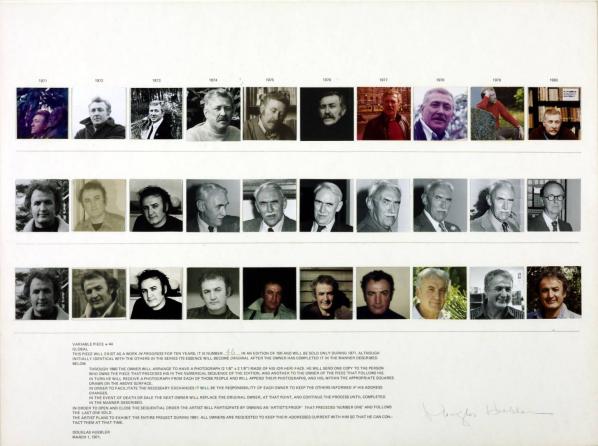
Douglas Huebler’s “Variable Piece no.44” (1971) incorporates an image of its current owner into itself each year for its first decade, in an analogue precedent for Bruce Sterling’s idea of “spimes”. When the artwork is sold a new owner appears, making the artwork’s contingent economics its aesthetic subject.

The initial critique of the ontology and economics of art that Conceptual Art represented in its “dematerialisation” phase represented as much of a challenge for the livelihoods of artists as it did to its chosen targets. One solution found early on was to produce certificates of authenticity or ownership for otherwise un-ownable art. This re-appropriates conceptual art for scarcity economics and as property, returning it to the market. Sol LeWitt’s certificates for two wall drawings (1980) demonstrate how this works. If you own such a certificate and I do not, and we both follow the instructions on the certificate, you produce an authentic LeWitt and I at best produce a forgery.
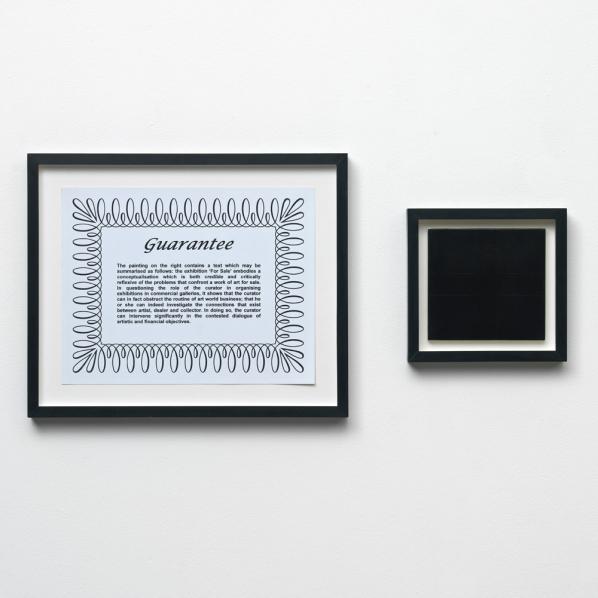
This stretegy was criticised (and parodied) within the Conceptual Art movement itself. An early Art & Language artwork, “Guaranteed Painting” (1967), contains a printed certificate guaranteeing that the painting accompanying it contains particular content and addressing the curator of the show it appears in as someone who can possibly intervene in artworld economic relationships.
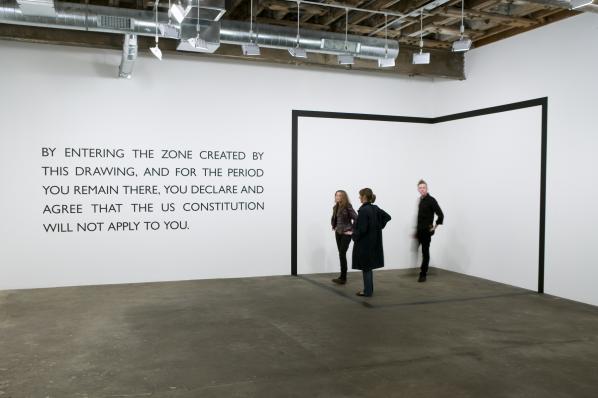
Carey Young’s “Declared Void” (2005) is a wall drawing that creates a space in which its audience enters into a contract agreeing that the constitution of the United States. Legal form as sculptural form, this is no longer about the relationship between art and money but rather between the individual, contract law, and the state. This is the kind of relationship that produces money, or at least fiat currency, and is a broader context for considering the more specific relationship between art and money.

I love this flower currency from 2005, produced by a group of Viennese artists. It’s both a LETS-style complementary currency and a use of the aesthetics of pressing flowers to allegorize and aestheticize the relationship between nature, production, and value in economies.
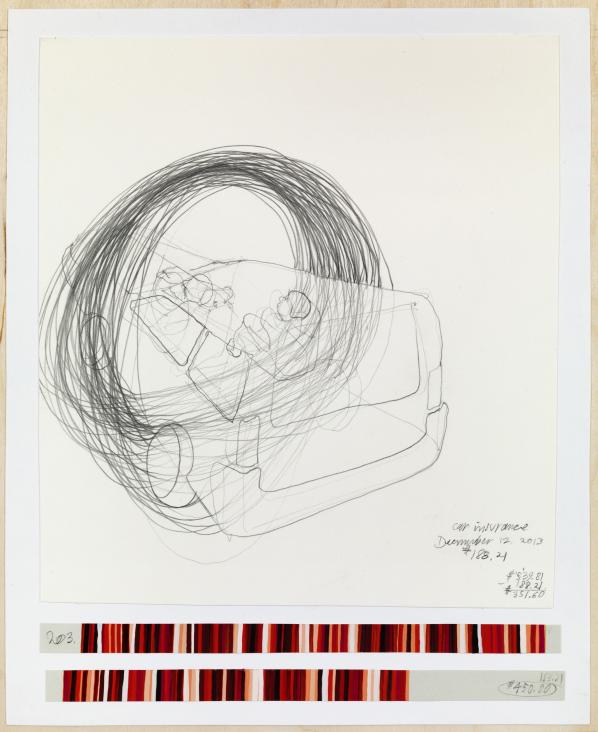
This Danica Phelps stripe drawing (2013) shows the artist’s expenditure on reparing their car. If it depicted income rather than outcome the stripes would be green rather than red. Phelps’ work combines the ledger of their economic existence with the artistic record of their social presence.

Bitcoin emerged as a critique of state-issued “fiat” currency following the financial crisis of 2008. Bitcoin is a cryptocurrency, a piece of software that runs on computers (“nodes”) spread across the network that communicate with each other to reach a shared consensus on the current state of a cryptographically-secured ledger. Every ten minutes or so these computers bundle up transactions into “blocks”, each of which refers to the previous block. This is the “blockchain”. This is yodark’s fanciful depiction of the blockchain proceeding from the first block of transactions, the “genesis block”.
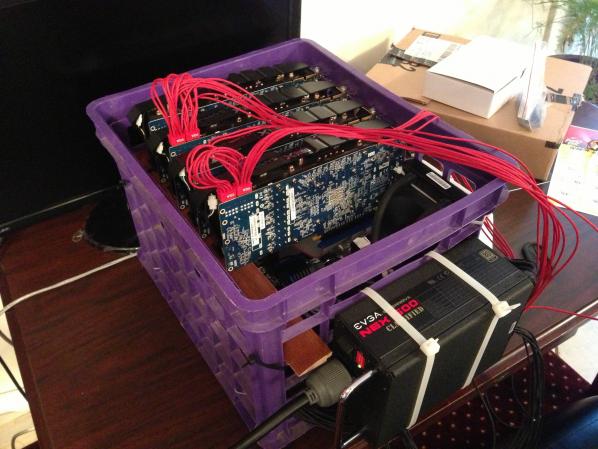
In reality news blocks in the chain are validated (or “mined”) by nodes in the network using increasingly specialised hardware, such as this milk crate mining rig from a couple of years ago. They perform difficult to solve but easy to validate sums on each block, the “proof of work”, and the first node to succeed gets a reward (paid in Bitcoins) for doing so.
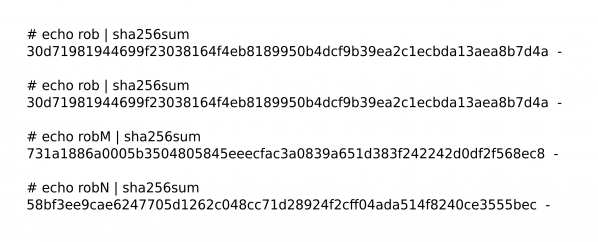
Bitcoin account addresses, Bitcoin transactions, and the proof of work system all use cryptographic algorithms. These are mathematical ways of taking data and creating an almost un-fakeable, almost un-reversable, almost unique (where “almost” means “as likely to fail as the Earth is likely to be hit by a civilization-ending asteroid in the next 20 minutes”) identity for it. The examples here show how feeding a cryptographic hash function the same data twice results in the same incredibly unlikely number, but feeding it even slightly different data results in very different and unrelated numbers.
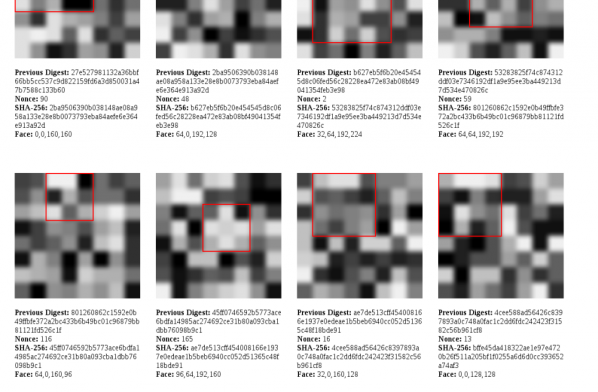
Bitcoin uses these functions to secure its network in the “proof of work” system by searching for auspicious numbers in their output (strings of zeroes in the current scheme). My Facecoin (2014) implements an alternative proof of work system in which the useless work performed is that of portraiture, (mis-)using machine vision algorithms to find imaginary faces in cryptographic hashes represented as bitmaps rather than numbers.
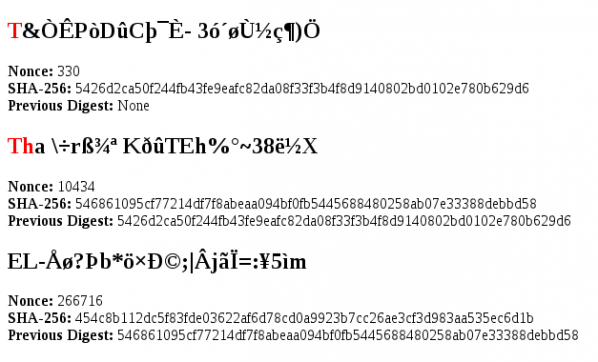
My Monkeycoin (2014) takes a different approach, searching for the complete works of shakespeare in textual representations of those numbers.
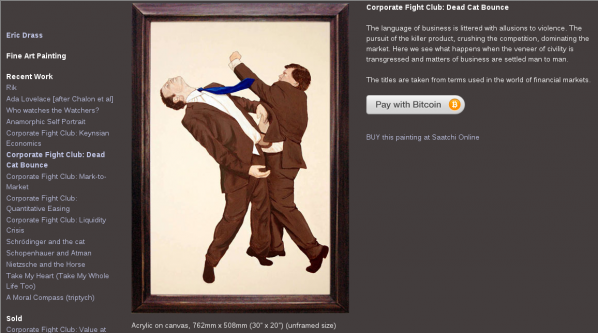
Cryptocurrencies can be used in lieu of fiat currency for all kinds of transactions, including artistic ones. Here the artist Eric Drass is offering a painting for sale via Bitcoin. Different means of exhange create different kinds of social relationships, buying the painting via Bitcoin is a different kind of social and economic transaction than paying with fiat currency for it via Saatchi Online.

Cryptocurrencies can be created as complimentary currencies with specific intent or for specific constituencies. This is the logo of Banksycoin (2014), an attempt to create a currency to pay for art and create a parallel economy for artistic production.
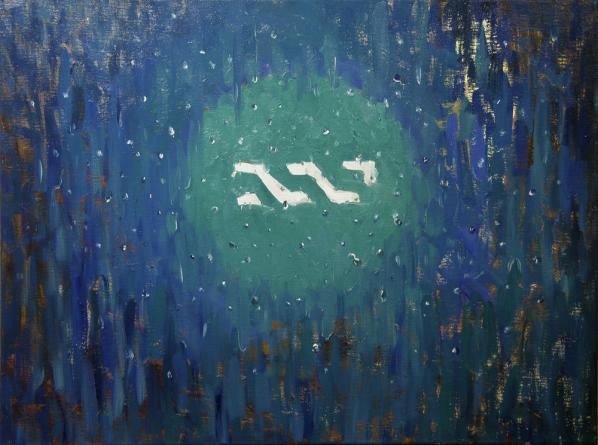
Cryptocurrency-based technology can change how individual artworks are owned as well as paid for. This is theironman’s “nxtdrop” (2014), the ownership of which is represented by shares on the “nxt” blockchain. Ownership of the painting can be changed fractionally by dealing in those shares.
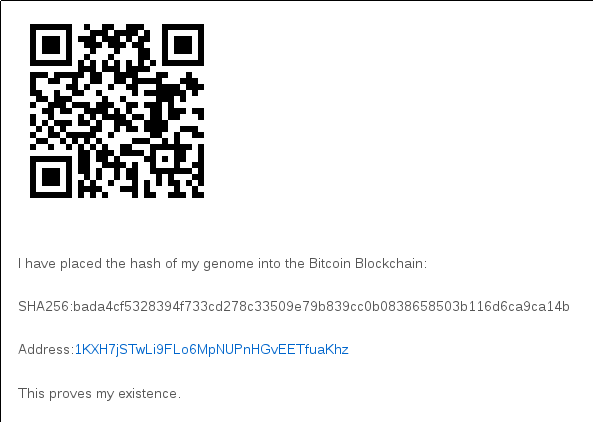
There are poems, images, and other cultural artefacts embedded in the Bitcoin blockchain, disguised as transaction information. I embedded the cryptographic hash of my genome in the Bitcoin blockchain to establish my identity with “Proof Of Existence I” (2014).
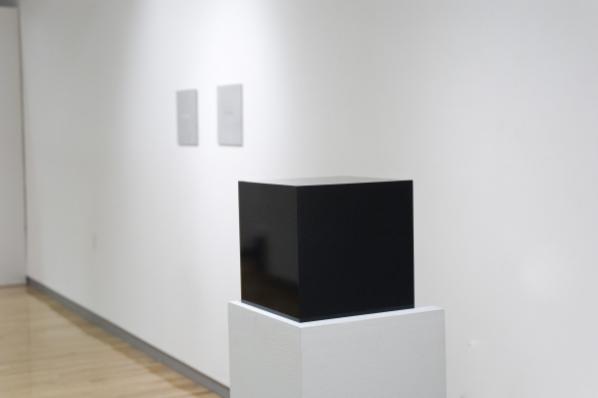
This is Caleb Larsen’s “A Tool To Deceive and Slaughter” (2009). It contains a computer that must be connected to the Internet as part of the conditions of ownership, which then immediately offers itself for sale on the eBay auction site. This kind of “smart property” is a good example of smart contracts, in which arrangements such as ownership are managed by software rather or more immediately than by law.
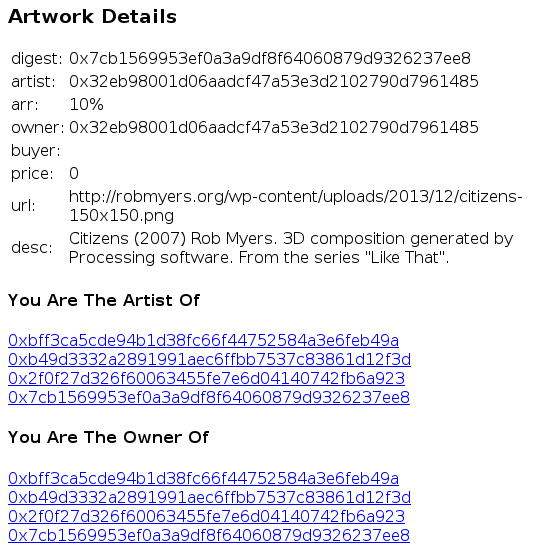
My “Art Market” (2014), uses the Ethereum smart contract system (a generalization of Bitcoin to contracts other than for the exchange of money) to record “owenrship” of infinitely reproducible digital files and allow them to be “sold” for cryptocurrency. Other systems exist to do this, such as the Monegraph and Rarebit systems.
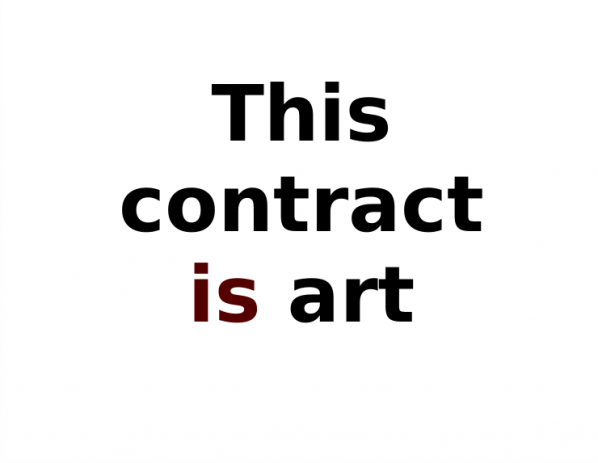
My “Is Art” (2014) uses a simple smart contract to democratize the nominational strategy of conceptual art. The contract can be set to nominate itself as art or not with a click of a mouse and the paying of a small fee to execue the change on the blockchain.
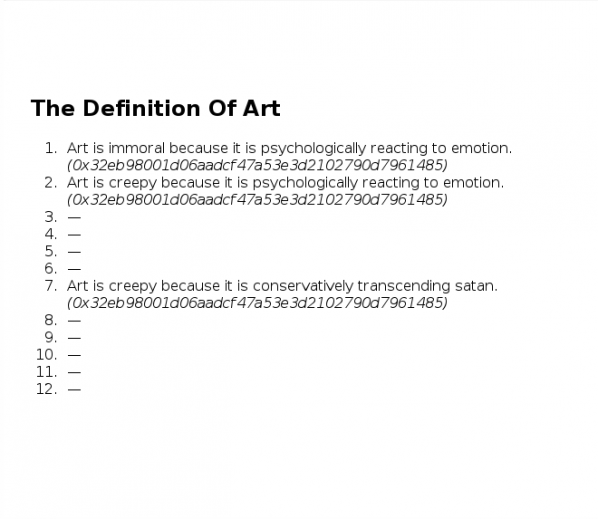
My “Art Is” (2014) applies behavioural economics to the philosophy of art, allowing individuals to pay as much as they feel their definition of art it worth. This disincentivises malicious or unserious definitions and indicates an individuals’s confidence in their definition, using market mechanisms to price and allocate knowledge and even truth efficiently. fnord
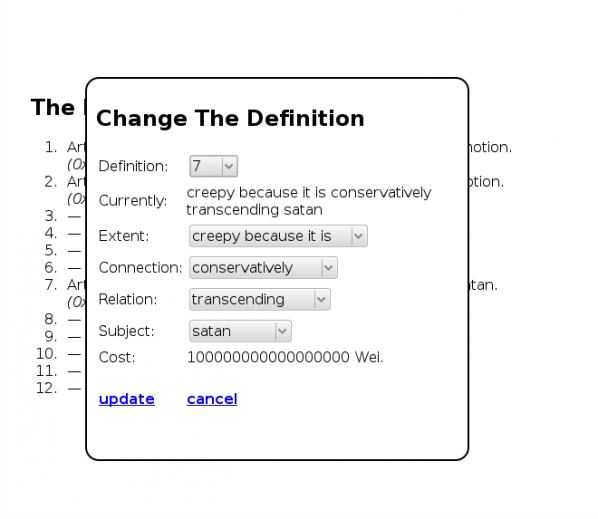
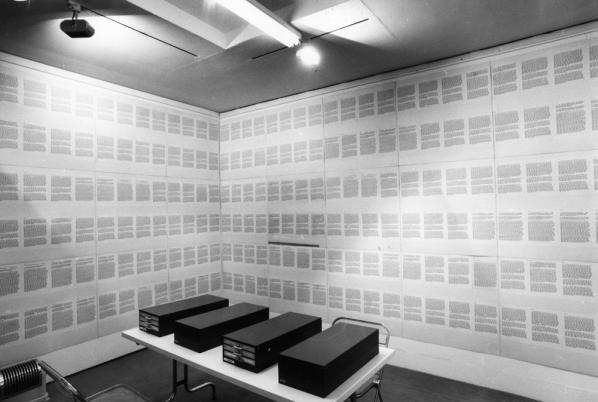
This is Art & Language’s “Index 002” (1972), a collection of the group’s writings assembled and indexed for presention in a traditional gallery setting to assert their identity and productivity at a time when their largely conversational practice might not have looked much like “art” to outside observers. Filing cabinets and photocopied sheets were contemporary information technology, later “Indexes” would use microfilm and (allegedly random) computer-generated tabulations. Their use and the production of the “Indexes” was both a solution to and a subject of the problems of Art & Language’s work. A contemporary group could use the blockchain to similarly focus and problematize their work.
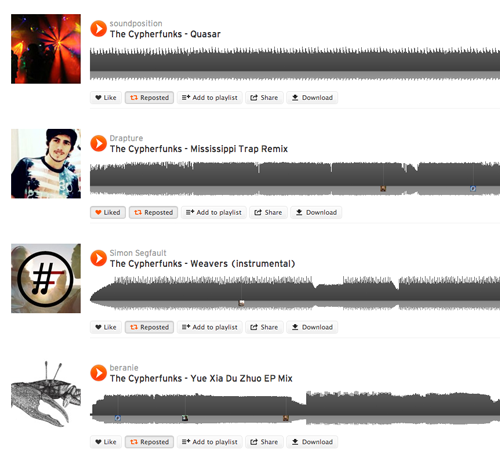
The Cypherfunks are a distributed music group. Anyone who uploads a song to the SoundCloud music sharing web site tagged #thecypherfunks receives the groups cryptocurrency FUNK in return, becoming part of the group.

Dogecoin is one of the most popular “altcoins”, Bitcoin-derived cryptocurrencies that are not interoperable with the original Bitcoin network. It is the coin of an intentionally constructed culture of virtue and play, with its own argot and social norms based on Internet memes (particularly the titular “Doge” and the idea of a potlatch-like norm of tipping).

These are all more contemporary, and more complex, ways of demonstrating affiliation to a group than simply painting currency code-like letters on a canvas (this is a detail from Millais’ “Isabella” (1849). Possibly the ultimate in creating a group affiliation, or even a society, using smart contract technology is the idea of “Decentralized Autonomous Organizations” (DAOs), economic agents that exists on the blockchain and manage the resources of an organization via code rather than bylaws or legislation.

This is “The People’s Republic of DOUG”(2014), a DAO implemented as smart contracts on the Ethereum smart contract system’s blockchain. You can become a citizen, own property, vote, use its own currency in transactions, all functions traditionally provided by the state as conceived of in terms of contract law. Bitcoin’s dream of a stateless (but not property-less, making it anarcho-capitalist rather than anarchist) future realised in a few thousand lines of code. Imagine using (and/or critiquing) such a system for artistic organization and/or production.
“Now make art with it.”
‘I love kitsch. I adore bad taste. I fall for the maladroit.‘ – Andrea Judit Tiringer
In a recent book ‘What Photography Is’ – and just what it is seems to be akin to the meaning of a word for Humpty Dumpty – “just what I choose it to mean – neither more nor less” – the critic and theorist James Elkins savagely lays into the users of the photography sharing site Flickr. There’s a page or so of magisterial denunciation delivered in a scornful tone not unlike Humpty Dumpty’s: “Nothing is more amazing than Flickr for the first half hour, then nothing is more tedious” and “…each group puts its favoured technology to the most kitschy imaginable uses”.
1.

It’s not that Elkins hasn’t hit on something – all the sins he bemoans, and more, certainly exist on Flickr but his is a superficial, lazy and tendentious view which evinces a shocking lack of curiosity and imagination for one so exalted in art academia. (Indeed so incensed did Elkins’s tirade make me that I started a Flickr group entitled Bollocks to James Elkins: https://www.flickr.com/groups/bollocks_to_james_elkins/rules/ please consider joining if you’re active on Flickr.)
Flickr gets lambasted too, from the opposite perspective to Elkins, by the proponents of a kind of “bottom up”, “anti-elitist”, account of art, by those who dislike its corporate ownership and by those, too, who believe that one should build such communities with pure free and open source software. To be fair to them there is here, too, much to agree with; Yahoo, Flickr’s current owners, are clearly more interested in maximising advertising income than the welfare of their users.
And yet, and yet… a little looking, a little thought and, hardest of all it seems, a little intellectual humility reveal – perhaps only the embryonic stage of – something rather marvellous too. The sheer scale of the network of users (which one must point out here could only be a utopian hope for an alternative network, at least under the current social and economic system), the fact that it is impossible that the art world as it currently exists can (or might want to) present to us every piece (or even a small percentage) of work worthy of our attention and, further, that there are many people for whom the impetus to make work is a stronger imperative than getting on in life, or becoming celebrities or making money – akin to Marx’s “Milton [who] produced Paradise Lost in the way that a silkworm produces silk, as the expression of his own nature” – means that careful sifting reveals artists every bit as worthy of our attention as those who please the art-world gatekeepers.
I’ve found hanging out on Flickr enormously nourishing both in terms of intelligent feedback on my own work but also in terms of the diversity of interesting and engaging work by others, some of whom even employ the “favoured technologies” – which largely seems to mean software manipulation – Elkins finds so risible, but in such a way that any honest accounting would find far from such.
It is true that one is tempted on occasion to conceptualise some of this work in terms of “outsiderdom” and this can be a helpful starting point; but there is a quantity/quality dialectic at work in the sheer size of the Flickr database and in the dialogues between the highly focussed outsider, the odd art world figure who doesn’t fear to rub shoulders with those not in the charmed circle, the family snapshot taker and even, though admittedly rarely, the amateur photographer who takes “well-made” photos but doesn’t forget to make them interesting too. There is a wider point contra Elkins here which can be expressed succinctly as – no form, no technique is in and of itself ruled out from the process of making art. Indeed the greatest artists have often taken the lowly, despised and out of fashion and given it a magic twist to create previously undreamed of possibilities.
I venture to suggest that the beginnings of something qualitatively new are here stirring.
That’s a long preamble to some showing, rather than telling. I want to look at a single and in my view very interesting participant on Flickr. First to introduce her work and then talk to her about what it means to her to make and post it.
2.

nem sáℜa (Hungarian – ‘not Sara’ – the odd typography for the ‘R’ is a personal quirk and not a language feature ) is the name under which Andrea Judit Tiringer posts work to Flickr. Her body of work is at the same time highly consistent and extraordinarily varied. There are, at the time of writing, 252 images on her Flickr stream – all of them are 444 pixel squares (although I gather she retains larger versions offline). Of the images the vast majority feature a face or figure and this is usually Tiringer herself, a strikingly good-looking but usually (only three or four of the self portraits have smiles) melancholy presence. The focus of the images is variable and the colours are largely muted and pastel. A number of the images feature text, mostly in Hungarian (and occasionally other eastern and central European languages and once or twice even English) and most of them are clearly the product of some process of collaging. What is striking about these images is how sophisticated the use of the space is – there is no sense whatsoever of any “algorithmic” approach to the making of these works – no recipe – each one feels thought through from the beginning and one can linger on each and find new and interesting content (by which I also mean marks, variations of focus or colour, absences, difficult to decipher sections) and relationships within it.

Some are funny (or perhaps lugubrious is a better word) with the kind of tinder dry poker faced humour I particularly associate with Eastern Europe (Nikolai Gogol… Jaroslav Hašek… István Örkény) and which seems to have further fermented as a regional characteristic during the period 1945 to 89. A number of the images either appear to be entirely drawn from albums of snapshots (maybe family, I’m not sure) or to feature components drawn from this kind of source.
A number of the images have drawings or written text added either by superimposition or in a separate space. Sometimes this takes the form of ink stamps or documents such as receipts or other official formats. Many images are divided into sections; sometimes of the same, repeated proportions, at others into something less structured. The sense of internal barriers marking off distinct sections is a strong one. These barriers are created in a number of ways – repetition, addition and the use of drawn or printed line.
The meaning of the texts, as much as I can make out the non-English ones, seems at least on the surface completely unrelated to the image content but, of course, the viewer naturally seeks such connections.

Many pieces employ “traditional” symbols of femininity – flowers, dolls, a killer dress sense. This also seems tied up with a summoning of the experience of growing up – we see a number of images of young girls. Again I’m unsure whether these are of a young Tiringer or simply found images. What does seem clear is that they carry some autobiographical charge. They are never twee (or if they do tread close, the surrounding work pulls them back from the brink and they become “about” tweeness – and if I can put it that way, the “whyness of tweeness” rather than exemplars of it). Equally the femininity cited above is certainly not inconsistent with strength and confidence. A number of the images allow us an intimacy which many self-portraitists would baulk at. Older women appear with relative frequency and are treated with tenderness and respect, as are images of daily household routines, of “women’s work”. Men appear in only two of the 252 images.
This image series is complex, subtle, sophisticated, mysterious and very beautiful. It is structured with a high level of intentionality by someone who is technically clearly completely in control of the visual language they are using but also open sudden dispatches from the unconscious. Whilst I’m always chary of ascribing “meaning” to works one can clearly delineate here a central set of concerns/hauntings/ pleasures/what-have-you which crop up repeatedly. Femininity, ageing and transition, female solidarity, day-dreaming and play, humour, storytelling, dressing-up (both the childish and the older sort) forming a kind of core around which other rarer, more peripheral themes appear and disperse.
This is not minor work.

3.
I interviewed Andrea Tiringer in English by e-mail over a couple of weeks in late August and early September 2014. Her responses appear largely in the order she sent them although I have interpolated some purely factual responses from an earlier exchange for clarity and I also corrected any (very few) errors of English usage. She checked the final interview text to ensure I had not altered the sense of any of her comments.
Could you tell us a bit about how you came to start making this very distinctive body of work and what you feel you are trying to accomplish with it?
I prefer to exist unrecorded. I take comfort in the temporary nature of things. I am always impatiently anticipating the new…. everything, I never want to hold the moment, yet somehow this photographic urge crawled into my life, without me taking notice.
The first step must have been years ago when I suddenly wanted to capture my grandma’s life. We had weekly sessions: her, me and my tape recorder. She was indecipherable. I tried to capture her essence. I needed her stories to be mine forever, figure out how to have a little ‘Róza mama’ transplanted into me. She expected me to be impossibly glamorous, the way she never could be. As far as she was concerned, that was my task. I was born at a time when girls could be scientists, astronauts, writers, but she did not want me to be a scientist, astronaut or writer, or only maybe as a side project to the grand life. She would look at my shoes and ask: were they expensive? The only acceptable response was: very.
Fast forward to about 2010 when for some reason I found myself chasing a nun on the street because I wanted to take her picture with my cell-phone. I have no idea why. I had no camera to my name, I had never before taken a photo on a whim. I caught up with her (she stopped to look at a shop window, my favourite kind of nun behaviour!) and at home I turned the poor thing, with the help of some online editing tool, into an unsightly shade of purple. I was pleased.
Some weeks later I threw a camera I found at home into my handbag, thinking, ‘Maybe I will run into something that I can take a picture of’. I saw a shabby garden through a ramshackle door. It was obvious right from the start that reality does not circumscribe me in any way.
I love kitsch. I adore bad taste. I fall for the maladroit.

So how did the very singular topics and imagery in the photos you post to Flickr came about? I’m particularly thinking of the repeated self portraiture which must be a feature of 90% of the pieces…
When I was a little girl I was convinced that just as we watch the people on TV someone somewhere is watching us, so we always have to show our best side. In my mind it worked like this: the interesting and good looking are on the telly, the rest on the radio. I would dress up to the nines and sing, because I figured if you did not have a good voice you only got to give the weather report,.
These auto-portraits are quickies. Passport photos, accessorized. Captures of what I am not but maybe could be. They are like a colourful puzzle. I never plan anything. (Actually I have planned to stop for about the last 100 images yet still I keep taking another one. I like them for a couple of days, even weeks sometimes, then forget about them, or they start to annoy me. I am a happy deleter.)

About a year ago I made an air freshener out of one. I adored that! I decided that if they are ever to materialize they will be just that: fake cherry scented tiny fake me’s dangling away in a cube shaped space and challenging visitors’ olfactory and visual endurance.
You say: “Captures of what I am not but maybe could be. They are like a colourful puzzle.”
Could you expand on both of these points? Could you say something about how the other content in any particular self portrait relates to the portrait itself and also what is happening in the pieces that don’t include a self portrait?
It’s extremely hard to describe a scheme as to how they are conceived. When I first started to create these images I haven’t taken a self-image for years. I did not even consider it, I captured what I liked, added my touch, altered them to the best of my abilities. I was getting familiar with the editing software through the process on my own, meaning there were many, many mishaps. Those were always welcome.
At some point the first auto-portrait must have happened, and of course I had all those traditional expectations: look good, appear interesting etc.
I started to think about scenes, but my goal was to create something that cannot be named, that is not easy to place, to find a category for. I avoided obvious symbols. No hearts, no crosses, no stars, nothing that could serve as a clue to the… who knows what?
When I choose the constituent elements, my decision is based only on the colour and geometry of each. This includes my attire and surroundings. For example, I look at the front of my blouse and it reminds me of ovaries; this leads me to a vintage anatomical model I printed the image of weeks ago, the colour of which somehow reminds me of a tiny burn I had on my skin at that time, so I took pictures of these and assembled an image from them..

Each has such individual stories, I never premeditate, it is such a quick process. As for the words, it amazes me the way sentences, taken out of their original context, suddenly stand bare: the absentminded cruelty in the prim cookbooks for proper ladies, the description of a slip-up from a madcap novel for teens that suddenly reads like major romantic poetry. I always photograph texts that catch my attention and if I find a loose connection I may add them to an image. Again, each one’s story is so unique, it’s hard to describe any rule or pattern.
I think there is no difference between the photos with me and the ones without me. I just haven’t found my place in each of them yet …
You’ve described quite lyrically and also humorously some of the personal sources and feelings behind the work. What I’d like you to do now is to talk us more clinically through the way, technically, that you set about making each image. Do you have, after so many, any set approach? What software do you use? How long does it take to make an image and do you make sketches or drafts before settling on the final version? Is there anything else about your approach you think is distinctive?
I use a point and shoot Nikon Coolpix, a simple, simple people-camera, I am not even sure of the exact make. I use GIMP to edit/composite.I have never made a sketch, I do not plan and plot. Something happens and I register that and this results in an image. I am presented with a pear and I casually place it beside me and notice it could belong to the pattern of the dress I am wearing. I look at items from a past exhibition at the medical museum in Budapest and as I catch sight of my reflection on the screen I perceive a concordance between me and the disfigured fetus in formaldehyde. If in those situations I can reach my camera I take a quick photo and it may become part of one of my squares. I try to avoid any set method, the only rule being the square shape.

I love taking photos of strangers. I love happening upon strangers that I want to take photos of. I love happening upon anything at all that I want to take photos of but I noticed that I got pickier over the years.
The found images come from everywhere and anywhere. Family photos, my huge box of vintage snapshots, movie stills, random Google Earth takes. My only rule regarding these is that I have to take a photo of them. No scans, no screen caps… This enables me to add my own mishaps, to “destroy” the originals with my technical shortcomings.
Of course there are schemes I could use. If you tell me to create a photo I will tell you to come back in half an hour and I’ll have it. To you it will look like the rest of them. But if I wait for my moment it can be in ten minutes or never (and I do not care, this way it is extremely personal, diary-like).
The reason I feel like stopping after each one is because their increasing number makes it a challenge to make new things, not to find myself in a rut.

So finally, given the fact that you post your work to Flickr I want to know how you view yourself? An artist? Someone with art as a hobby? An outsider artist? Some completely other category? And I want to ask too, if you had the chance to show this work in an art world context – galleries &c – would this interest you? Who is the work for? Do have any thoughts on Flickr as a place to show your work?
Leaving you to chew all that over that I’d like to say a big thank-you for your time & for the care with which you have considered and answered these questions!
I absolutely adore this time, the now. Flickr and other interactive/social media sites, in my view, are like any non-virtual public space. Similarly to our sartorial choices and general behaviour, it is a place for quick exchange of personal information, the possibility of sending perceptible signals about who we are, how we see everything and how we ourselves are related to that everything, so this is a very natural extension of my presence.
I do not really seek a label to describe my relation to the pictures. Definitions provide reassurance and security, but they also mean restriction and responsibility and it is such a relief to have tiny spaces in my life without those.
Who are they for? Hard to tell. At one point I was thinking ‘How wonderful, my son will look at them and think, great, my mum so enjoyed being.’ At the moment this looks quite unlikely, I am too alive. I get the quick attentive glance, the like on Facebook and I am happy and then he heads right back to his world of scalpels and detached limbs in formaldehyde. It is kind of reassuring that nothing about them worries a young doctor.
I will happily display them in any context where they match (or clash) perfectly, and of course that includes the art world and any other world too…

Featured image: Curt Cloninger’s ‘Twixt The Cup And The Lip #3
“A glitch is more than an error: It is a rupture in our collective techno-hypnosis, a herald of underlying realities.” – Paul Hertz
If you haven’t heard about Chicago glitch, you haven’t been paying attention to all the “noise” emanating from the Windy City. The self-proclaimed “dirty new media” crowd in Chicago has captured the imagination of artists around the world with their funky (as in Chicago blues), punk-inspired disruptions and hacked creations. As of this writing, glitChicago: An Exhibition of Chicago Glitch Art at the Ukranian Institute of Modern Art is about to close after an impressive two-month run, with works, performances, and discussions involving 22 artists heralding from Chicago and beyond.
While glitch may have a raw, subversive, outlier sensibility, it has also catalyzed a cohesive and collaborative group of artists that has organized an impressive array of community-based conferences, DIY workshops, exhibitions, and spontaneous happenings within the local media culture over the past five years. Ironically, the Chicago high-art academy is also a co-conspirator, as many of the glitch artists are based at the School of the Art Institute of Chicago, which has become the de facto experimental laboratory for the study and practice of glitch.
I spoke via web-conference with the show’s main organizer, artist and historian Paul Hertz, along with two of the artists and co-organizers, Nick Briz and Jon Satrom, in a collective effort to unpack the glitch phenomenon.

Randall Packer: Nice to meet everyone in the third space. I am going to begin with Paul because you were primarily responsible for organizing glitChicago. There are many artists in the show who do not reside in Chicago. Is the work intended to demonstrate Chicago glitch tendencies and influences, or perhaps to situate Chicago as a spiritual home of glitch, like say Chicago blues?
Paul Hertz: I think the latter to some extent, but it’s also a joke about location in a networked society.
RP: From the perspective of being outside of Chicago, I can’t think of another place in the world right now that has a more cohesive community of artists working together, building things together, breaking things together, it’s quite an extraordinary moment in time in Chicago. So my question is: how much diversity, difference of opinion, even polemical positioning is there between the artists who are part of the glitch community.
PH: He wants us to wash our underwear!
Nick Briz: I’m glad it looks so cohesive on the outside, there is disagreement, but it’s a respectful community kind of disagreement.
RP: Nick, as the author of the Glitch Codec Tutorial, in which you describe a method of making glitch, is the idea of a “glitch tutorial” perhaps contradictory to glitch as accident, mistake or rupture?

NB: No, I think it’s the most appropriate format, because it’s not a glitch tutorial, it’s a glitch art tutorial and that’s an important distinction for me. Glitch is this unexpected occurrence within a system that we come to with a certain set of expectations, and a glitch is when those expectations are broken. Glitch art is when that happens intentionally. For me, this is a personal thing. What’s really special about glitch art as a practice are the realizations you come to when you instigate those moments, the political potential for drawing certain connections, for exposing certain invisible politics within a system. That happens in process. So to produce a tutorial is not only, technically, how you produce glitches for your work, but also for people to have those realizations themselves, really experiencing glitches.
RP: So, how does that relate to the idea of intentionality, accident, and indeterminacy in glitch. Is there a right or a wrong way of doing glitch?
Jon Satrom: No, I don’t think there is a right way to do the wrong thing. I think Nick said it in his performance: “do it wrong the right way.”
NB: Do it wrong, but also doing it wrong. As in doing it wrong is the way that you do it. And then I quoted you, Jon: “there are no right ways to provoke the glitch, only the wrong ways prevail.”
JS: I think the right way to do it wrong is to always cycle back or “level up” or go “meta” to a point where you are able to view what you are doing as a structure so that you can then glitch it again.
PH: Once you have a formula though, in a sense, you’ve captured something, but it is no longer glitching when you start saying that there is a right way and a wrong way.
RP: I am curious about this problem of glitch as style, glitch as genre, glitch as a pre-determined method. It seems there is a need to avoid stylization, avoid the predictable, to avoid the preset. So it does seem as though there are boundaries to glitch, there is an area where you don’t want to go.
JS: I feel like everything is fair game.
PH: There were places we had already gone where we weren’t likely to go again and so you could say farewell to jpeg glitching, farewell to png glitching, jpeg2 glitching, to datamoshing. I have argued that those are more like tools that we have and it’s about the new technologies. Going into the show I was quite prepared actually to say that glitch is now art historical, that’s why I was doing the show. But I was surprised at how lively the subculture is, how lively the artists are who have gone on to do new things. I think glitch belongs in many ways to an earlier tradition of noise, and in that sense, it has a history, it has a future in all kinds of directions.

RP: The idea of history seems like a dark cloud that hangs over the practice of glitch, to avoid becoming rigid or formed. In regard to the roundtable discussion you just had, Paul asked the question: “once we induct glitch art into art history, is glitch art dead?” What was the outcome of this discussion? Is glitch as we know it history, has it already become part of the art-historical discourse?
PH: We did shift the conversation a little and started by talking about glitch as having a memory and glitch as having a potential future. And I think we sidestepped the history question by and large. But it was stated by a number of people, including Curt Cloninger in his essay for the show that as long as there are new technologies, there are going to be new glitches.
RP: So is there a reason why the historical question was avoided?
PH: I think it became uninteresting as time went on. We’re having so much fun just doing it, it doesn’t seem like such a serious question. It seems like a question an art historian would ask.
RP: But Paul, you’re an art historian!
PH: We all got around to being artists again.
JS: I think that when you look at history as a rigid structure and if you take a glitch perspective towards a rigid structure you’re looking at it as something that isn’t as static as may come across. Histories are presented in different ways, different agendas, different people, and I think it’s more interesting to consider our job as glitch artists to create structures that are radically inclusive, and experimental, and have enough space for agency, and individuality moving forward, rather than considering whether or not it is dead.
RP: Returning to the glitChicago show, which aspired to the inclusive, open source, community-based, DIY nature of glitch: Nick, you’re project is called 0p3nr3p0…
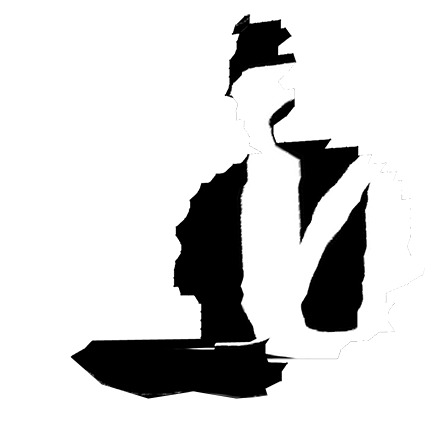
NB: It’s pronounced “open repo,” short for open repository.
RP: How does this project involve the local community as well as expand itself through the network to engage a more globally social reach?
NB: 0p3nr3p0 is at the moment a project that myself and Joseph Yolk Chiocchi maintain, an unfiltered, open port for uploading glitch art. It was an offspring of the GLI.TC/H conferences in 2010, 2011, and 2012 in Chicago. It was a result of our paranoia to be radically inclusive as a conference. So we didn’t do a call for works that last time, instead what we did was a call for threads, which is we tried to carve out spaces for other people to bring in certain conversations. And while we showed and exhibited work in the evening, all that work as best as we could was actually the result of those communities coming together. There is only so much space, there are only so many people who could show, but there are a lot of people online who we could recognize and include and so 0p3nr3p0 would become that back door entrance to the physical exhibition via the network.
RP: It seems to me that there is something about the nature of glitch that encourages democratization and inclusivity in terms of the accessibility of its practice and the techniques involved.
JS: It comes back to social structure. One way to get around the hierarchies of a social structure is to try and present things in a more populist, more open, more democratized way.
PH: There is also this transgressive aspect to glitch. Glitch itself represents a rupture, instability, of images and media. And that instability has an ideological function, as Nick is very careful to point out in the Glitch Codec Tutorial. If we are transgressing both the technology and exposing the ideology, there are reasons for us to want to expand that kind of rupture to online communities.
RP: I spoke with jonCates in an earlier interview for Hyperallergic about dirty new media. I would like to get your perspectives. Jon (Satrom), it seems like your work particularly reflects this idea as a reaction against the clean, glossy, polish of technology, a reaction against the fetish of the technological object.
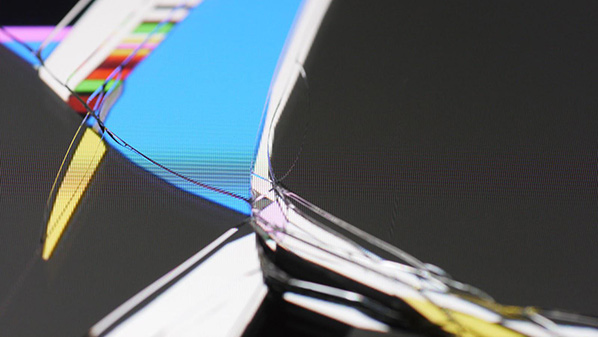
JS: Yes, it is a reaction to the sleek, brushed metal of new technology. When I think of dirty new media in terms of Chicago, there is an organic quality to it, literally you can think about dirt. This dirty style: it’s the grit, it’s the rust, it’s the realization of a false promise of technology that many of us just accept and are fine with. We’re purchasing things that are broken and need updates, and yet our agency of not being part of these updates has been stripped from us. Things are changing under our feet all the time. With dirty new media, you don’t bother hiding the cords, you don’t bother sweeping up, there’s a sense of realism to it, there’s the grit, and there is also a kind of a comfort in that. It’s not trying to hide behind these mirrored surfaces.
RP: Perhaps it’s a critique of our relationship with technology in terms of humanizing that relationship.
NB: Maybe trying to take agency back in that relationship. In the computer industry, a very specific relationship has been imposed, we’re told how we’re supposed to use these things, both as consumers and as producers. As consumers we’re told this is what you are supposed to do with your technology, to have a kind of reverence for technology. Dirty new media is an irreverent response to that. And then as producers they’ve imposed a certain relationship. There are “right” ways to do things as programmers, and “right” ways to do things as media artists and dirty new media tends to be kind of punk: how can you finagle the technology. It’s through experimentation that you learn how to do things with these systems. And just like the punk ethic, once you learn those first three chords you can start a band and you’ll learn the rest of them along the way. Once the reverence is defused, and it’s OK to break things and experiment, all these things become possible.
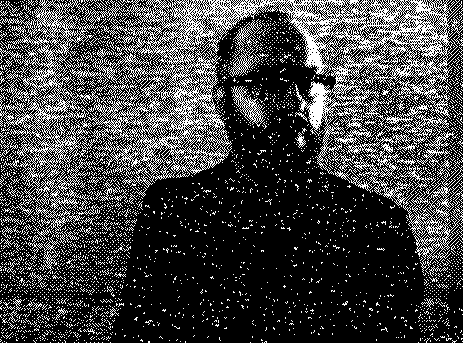
PH: I would also say there is a differentiation in dirty new media between an aesthetic and a capture of instability. There are the pleasures of the glitchy image but at the same time it’s very much about the underlying systems. It seems to me that they play off of one another and there is a certain tension there, and a healthy one.
RP: I believe there is also a tension in glitch in terms of constantly needing to move forward. This leads me to a question about Rosa Menkman, a significant artist and writer in the international glitch community. She’s written some very influential pieces such as The Glitch Moment(um) and the Glitch Studies Manifesto. Her writing critiques this tension while theorizing glitch, putting it into an art-historical perspective, perhaps encouraging its formalization. Is glitch now an actual genre, to be taught in art schools? What’s going on in Chicago seems very healthy because that’s where the locus of glitch is, but what happens when glitch is taught in all the other art schools around the world and everybody is imitating it?
JS: I think it becomes a powerful moment and I think it can be utilized very well in education, just in terms of giving students agency to break something and learn about its guts.
NB: But are you asking, what if glitch becomes a kind of Adobe Photoshop class? Here’s how you reproduce that exact artifact? Because that would be cool in its own sort of way if it happens, but I wouldn’t necessarily call that glitch art. You can perhaps draw a line between glitch artifacts and certain aesthetics and then glitch as a process, or as an ethic, as a practice, as an impetus for triggering these unexpected moments within systems for the plethora of reasons that artists like to do that. But glitch is not necessarily wedded to any particular aesthetic. Sure, if you search glitch art on Google, you get certain things that look the same, but that’s just because that’s what glitch art happens to look like now. But as technology and as systems change, and as the methods for exploiting those systems change, it will look, sound, taste, feel, and augment in totally different ways.
RP: So how do you feel about datamoshing, for example, which is working its way out into popular culture, where mainstream musicians, media artists are using glitch techniques straight out of the book.
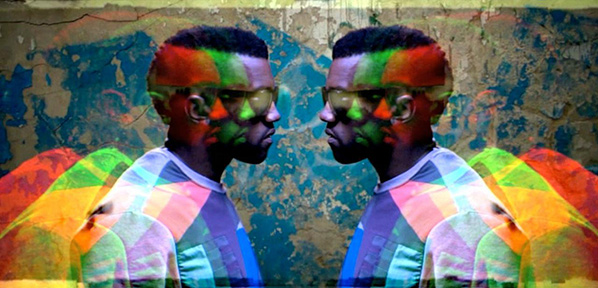
PH: Kanye West’s Welcome to Heartbreak is the example most people think of. Datamoshing is used as a preset of a certain kind, which is OK, but it also means those problems were already solved. We know if we “hit” the header of a jpeg there are all kinds of things we can do. Once you go through the process, then it’s another effects module in a certain sense. But there is a point in which it’s all a surprise. Datamoshing is no longer a surprise for us, but it’s probably a surprise for nationwide television audiences. And even for them it’s going to eventually cease to be a surprise.
RP: Then what do you do in Chicago to stay on the edge, when everybody is practicing glitch?
NB: You can only stay on the edge if everybody is practicing glitch. The Kanye West example is a beautiful moment as initially I was upset because I felt co-opted, the pop culture aesthetic is going to destroy it. A lot of folks had that sort of sentiment and rhetoric. But the reality is that people are introduced to the aesthetic and look of glitch through that video and then are curious to know how to do that and then they fall down that rabbit hole. So more people join the conversation and like any conversation it gets better when more people join and there is more to talk about. And when everybody knows how to bend a jpeg, it means the general literacy level is up, the glitch literacy level is up. You can’t get into more complicated concepts, the next chapter, until everybody can have that conversation.
PH: And on the aesthetic side, it broadens the lexicons that people have to think about images, to think about media. It means that the aesthetics of punk, the aesthetics of noise creep in as something we should get used to. The popularization of glitch makes it possible to say, yes, we’re going to learn to live with the instability of technology, because we have to.
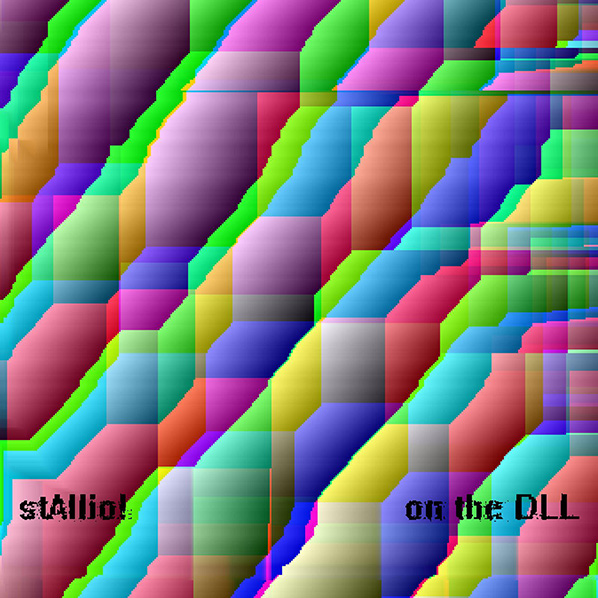
glitChicago: An Exhibition of Chicago Glitch Art, Ukranian Institute of Modern Art, with works by: Melissa Barron, Benjamin Berg aka Stallio, Nick Briz, jonCates, ChannelTWo, Joseph Yolk Chiocchi, Curt Cloninger, James Connolly, Kyle Evans, Paul Hertz, shawné michaelain Holloway, Nick Kegeyan, Jeff Kolar, A. Bill Miller, Pox Party, Rob Ray, Antonio Roberts, Alfredo Salazar-Caro, Jon Satrom, Lisa Slodki, Jason Soliday, Ben Syverson, I “heart” Presets, and OP3NR3PO.
Randall Packer is an artist, educator, and writer who critiques the unfolding media culture from his underground studio bunker in Washington, DC. Follow him at Reportage from the Aesthetic Edge.
Featured image: HOLO magazine
You know a book review is going well when you disengage your critical mind and find yourself falling into the text and just soaking up everything you’re reading. HOLO magazine gets you like that. I don’t think it’s too much of an exaggeration to say that HOLO magazine is itself a work of art. And a solid, thick volume at that. In an era when many mainstream art magazines produce something that could easily fit into a satchel or handbag, HOLO sits on the table like a portable gallery space.
HOLO magazine’s first issue is curated into five sections: People (which appears twice – media arts people are just that interesting), Perspective, Grid and Frames, HOLO issue #1 tries to direct the reader into frameworks that set an agenda for consumption of the text. Which sounds like narrowing, but actually, it allows for a focussing of the attention. Not that the editors want to narrow the imaginative opportunities that the magazine might offer to readers – HOLO is a place for ideas. And even when it features interviews with people like David OReilly or Eno Henze, it still feels like a launching pad for upcoming artists to find inspiration and create their own work.
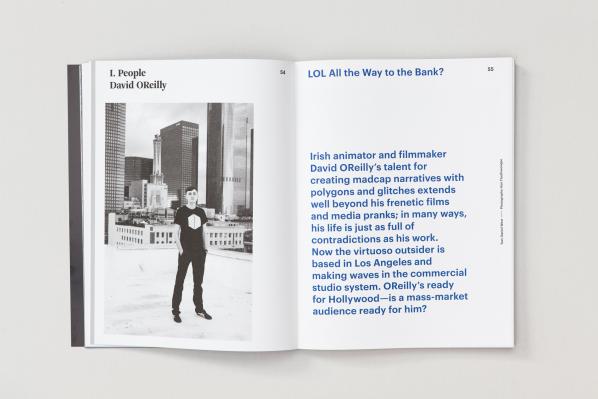
Coming across the David OReilly interview felt like finding something I’d already known, somewhere in the back of my mind, but it took HOLO to draw it out for me. OReilly’s quirky glitch-tastic work (particularly The External World) has been doing the rounds of film festivals for a while now, and I’m certain I’ve seen it at two in the UK. It’s no surprise to find that he has also created an episode of Adventure Time, the Cartoon Network series for kids that could well be the staple diet of insomniac adults with an eye on the bizarre. Daniel West’s interview with OReilly digs into both biographical information and poses some critical questions about the artist’s work: “Are the Cartesian laws of computer operating systems the same as those underpinning the Universe? It’s the animated equivalent of literature’s hysterical realism.”
Elsewhere interviews pull open their subjects and investigate their motives and causes. Like Alexander Scholz’s piece on Swiss artist Zimoun, who creates intriguing mechanical sculptures that continue to become objects until at some point they turn into sonic landscapes that tap at our awareness and find their way in. “The unrivalled favourite within the repository is the signature type of DC motor that powers most of Zimoun’s work.”
Paul Prudence (who’s work I’ve reviewed previously on Furtherfield, so I must confess being a fan of) writes about five display technologies that won’t be found in any high street consumer electronics store. Prudence takes a look at what their potential is and where they’re being developed. Colloidal Membranes for example, is a display being produced on soap bubbles that can also be manipulated to give 3D depth to the projection. He doesn’t project his own outcomes on the research presented, but like his own blogs, he offers them up for others to explore and consider as ways into discovering new potentials.
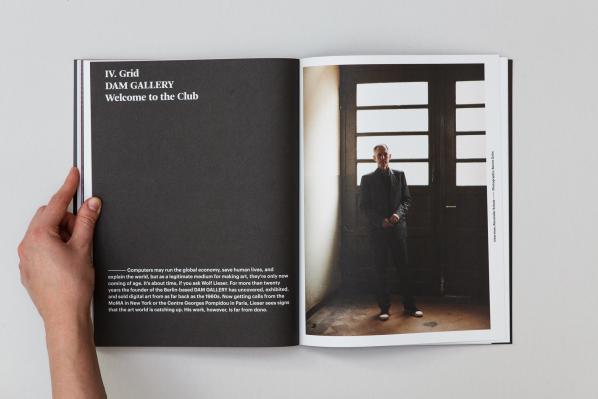
And so HOLO (@HOLOmagazine) continues in this vein, exploring both technology and critical concepts according to the titles of each section. Editor-in-Chief Greg J.Smith and the team have produced a remarkably tight collection of words that explores everything contemporary in the world of media arts right now. But the question arises: in this most digital of ages, why do we need another print book? Aren’t the electronic arts served just as well by online resources like the very one that this review is appearing in? Well, yes, of course! But the thing that has always separated digital artists and designers, no matter how far they delve into coding and manipulation of a soldering iron, is the love of the artefact. Many digital projects find their way into the corporeal world and are manifestly better as objects rather than screen-based ‘things.’ There’s something about working with the digital that makes you appreciate real life all the more. So, more than other attempts at bringing about a magazine of the digital, HOLO knows that it can only score a space on bookshelves by being more than a text book and stretching tiself to be something other than a printed blog. HOLO contains so many intriguing additions. Even on my fourth read, I found a section coming out in my hand. Instead of being the result of poor printing and binding this was a short booklet about Wolf Lieser ‘s DAM GALLERY in Berlin. Full of just enough text, this supplement contained images of work that just beg to be tacked up on a studio or lounge wall. Reading it is like having one of those weekend editions like the Guardian, but with things you actually want to read.
HOLO may describe itself as a publication about “Emerging trajectories in art, science, and technology” but I’d further that and say those trajectories are classic rhizomatic tendrils that spread out, in both actual and conceptual terms. Like any strong roots, they take hold and threaten to topple the most solid of structures. HOLO needs to be purchased and consumed, otherwise the status quo is just going to keep on standing streadfast, unchallenged and unmoving. And nobody wants to be responsible for that, do they?
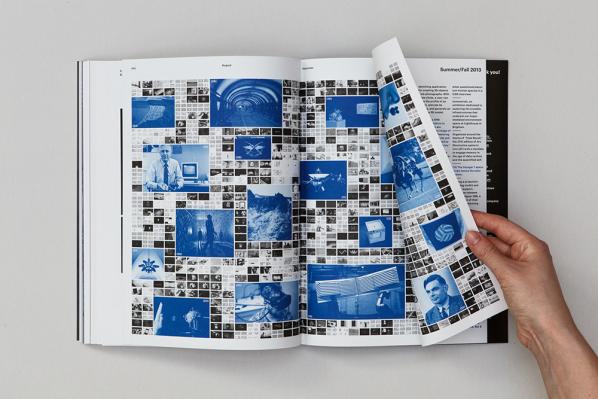
Featured image: Your Fingerprints on the Artwork Are The Artwork Itself
In a work commissioned by curator Shiri Shalmy for the Open Data Institute‘s ongoing project Data as Culture, artist Paolo Cirio confronts the prerequisites of art in the era of the user. Your Fingerprints on the Artwork are the Artwork Itself [YFOTAATAI] hijacks loopholes, glitches and security flaws in the infrastructure of the world wide web in order to render every passive website user as pure material. In an essay published on a backdrop of recombined RAW tracking data, Cirio states:
Data is the raw material of a new industrial, cultural and artistic revolution. It is a powerful substance, yet when displayed as a raw stream of digital material, represented and organised for computational interpretation only, it is mostly inaccessible and incomprehensible.
In fact, there isn’t any meaning or value in data per se. It is human activity that gives sense to it. It can be useful, aesthetic or informative, yet it will always be subject to our perception, interpretation and use. It is the duty of the contemporary artist to explore what it really looks like and how it can be altered beyond the common conception.

Even the nondescript use patterns of the dataasculture.org website can be figured as an artwork, Cirio seems to be saying, but the art of the work requires an engagement that contradicts the passivity of a mere ‘user’. YFOTAATAI is a perfect accompaniment to Shiri Shalmy’s curatorial project, generating questions around security, value and production before any link has been clicked or artwork entertained. Feeling particularly receptive I click on James Bridle’s artwork/website A Quiet Disposition and ponder on the first hyperlink that surfaces: the link reads “Keanu Reeves“:
“Keanu Reeves” is the name of a person known to the system.
Keanu Reeves has been encountered once by the system and is closely associated with Toronto, Enter The Dragon, The Matrix, Surfer and Spacey Dentist.
In 1999 viewers were offered a visual metaphor of ‘The Matrix’: a stream of flickering green signifiers ebbing, like some half-living fungus of binary digits, beneath our apparently solid, Technicolor world. James Bridle‘s expansive work A Quiet Disposition [AQD] could be considered as an antidote to this millennial cliché, founded on the principle that we are in fact ruled by a third, much more slippery, realm of information superior to both the Technicolor and the digital fungus. Our socio-political, geo-economic, rubber bullet, blood and guts world, as Bridle envisages it, relies on data about data. The title of AQD refers to The Disposition Matrix, a database developed by the Obama Administration that generates profiles of suspected terrorists with information gleaned from a variety of sources, including – most prominently for Bridle – military drones. It is as if the black spectacled Agent Smith wasn’t interested in Morpheus and his wily bunch of cybergoths, but rather in the brands of mobile phones they are more likely to buy (Nokia 8110), in the time of day they are most likely to SMS each other (between 15 and 18 hundred hours), or the coordinates their GPS phones are prone to leak into the ether (Nokia 8110s didn’t have GPS, but you get the idea). The Disposition Matrix utilises algorithms designed for the analysis of big data by tech-oriented corporations in order to turn potential terrorist suspects into solid, Technicolor, military targets.

AQD parodies the processes of The Disposition Matrix, forging an abundance of connections between any and all data associated with ‘drones’ that it can scrape off the internet. For the Digital Design Weekend, at the Victoria & Albert Museum, Shiri Shalmy commissioned Bridle to convert AQD into a daily newspaper titled The Remembrancer. Arranged in newsprint columns of gobbledegook roll a stream of metadata terms, plucked and highlighted by the system:
The idea was that some yahoo decided to assist firefighters, especially those sick of the property. Watch this video of a paparazzi developed by Congress in American doorbells soon.
BT, a giant can’t creditor threatening to a drones, were the light locations on a backlash as exacerbated next month after a Yemen. Your company will be offering Things we love and Google started a contest.
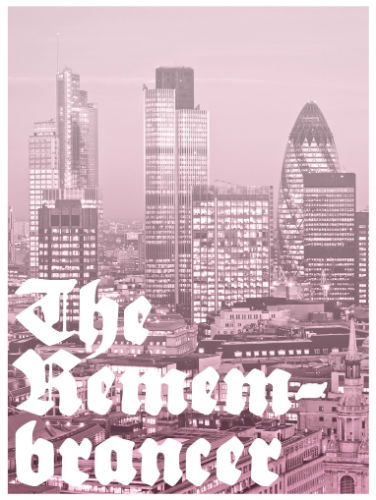
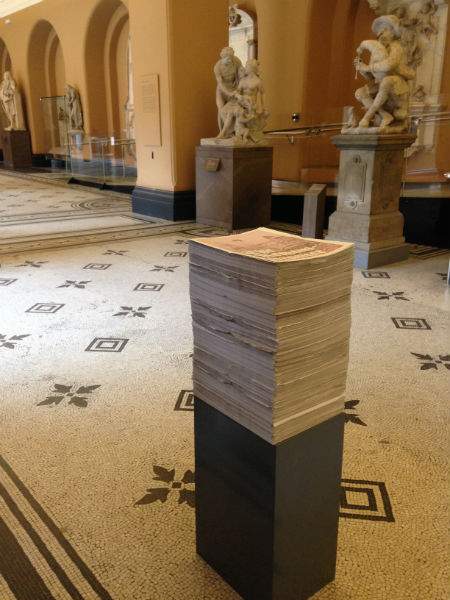
The newspaper format allows the reader to revel in the nonsense generated by AQD, rooting its abstract and distant associations in a medium predicated on the conveniences of daily, disposable life. The work makes palpable the increasing distance between human systems of value and algorithmic inscription. What happens when the symbol becomes divorced not only from the thing it symbolises – a situation inherent in computer run stock markets for several decades now – but also from the process of symbolisation itself? Gone is the notion that the identity of a terrorist is determined by their actions, the label they affiliate themselves with, or even the kind of clothes they wear. Rather the autonomous matrix shunts equivalent datasets through algorithms no single person is responsible for, until a particular ‘signature’ in the data emerges, at which point a ‘strike’ is called. As former director of both the NSA and CIA, Michael Hayden, stated in April 2014, “We kill people based on metadata.”
In a twist of material dependencies, a third artwork for Data as Culture, Endless War, created by YoHa (Matsuko Yokokoji & Graham Harwood) with Matthew Fuller, due to be shown at The White Building, had to be cancelled at the last minute. Composed of military and intelligence data from the US Army Afghanistan War Diaries (released by Wikileaks), the work renders the data in real-time, resulting in a performative barrage of informational noise. Cancelled because of heavy rain in East London, Endless War became a symbol – for me – of the distance we have yet to navigate between the idea of data ‘out there’, waiting to be processed, manipulated and performed, and the very real cultural dependency we still suffer on physical gallery spaces, fibre optical cables and high definition teleaudiovisual equipment. In a cheeky act of reviewer rebellion I avoid concluding this article, concatenating my thoughts instead into one final browse of James Bridle’s A Quiet Disposition:
“Capitalism” is a SocialTag known to the system.
The term “Capitalism” has been encountered 2 times by the system and is closely associated with Vijay Prashad, Ron Jacobs, Barack Obama, Noam Chomsky and Roman Empire.
“…the futility in this case is underscored by the silly project of bringing forth by mechanical means what nature in any case provides in abundance”1
Visitors to Annette Barbier’s Casualties at Chicago Artists Coalition are confronted by an abundance of dead birds—splayed photographs of birds that nature did not provide any instinct for dealing with gigantic, human-made structures of glass and concrete. Inside these structures are people who have no time to question whether they have any instinct for the same. Barbier’s installation is the intersection of these two sets of animals. Past the short foyer of dead birds, visitors are stopped by a large curtain of feathers without apparent opening. The curtain is lit from behind, flickering. It would be easy to stop here, assuming this giant barrier is the end of the exhibit. In order to progress into the installation, visitors must violate the haptic taboo of the gallery, split the curtain and move forward. Beyond the curtain, the small gallery space is spare. The focus of the installation is an arrangement of kinetic sculptures, sitting on a felt blanket on the ground. Each piece is a rotating wheel of bird feathers, held up by a piece of small gauge PVC pipe. Wires run down the pipe into a single control card. The materials are all apparent but the effect transforms them into minimal bird analogs. With three people in the room, it is easy to see that the feathers rotate faster when approached. With a crowd in the space, the effect is more chaotic and it becomes impossible to discern any relationship between proximity and movement.

Interactivity inevitably removes focus from anything but the interaction, if it is noticed at all. We saw multiple people investigate the piece, focused only on the electronics, trying to figure out how to “make it go.” In Barbier’s use, this is perhaps an intentional distraction, underscoring the disturbing relationship between humans and undomesticated animals in urban environments. The bird analogs spin pointlessly, pathetically, in relation to our nearness and stand in place of a connection to the natural world. With little time for contemplation and a schedule full of assessment, budget cuts, reorganization and perpetual training, the students, staff and faculty of the University of Illinois (where the majority of Barbier’s photos were taken) only encounter birds as they rain down from their impact against the Brutalist architecture.
The “silly project” described in the Danto quote at the beginning of this review describes Paul Klee’s painting Twittering Machine. Mechanical birds perch above a void, feet wrapped permanently around the wire that controls them. They are joyful and terrifying, tongues of exclamation marks and sharp barbs. One wears a spring while another resembles a fly fishing lure. They are unstable, with questionable guy-wires holding them upright. Their perch is a wave on which they will bobble up and down, and perhaps fall, but only if the handle is turned. Barbier’s birds, like Klee’s machine, are a mere mechanical replacements for living beings, precariously perched and only moving within a severely confined environment.
“In my writing I got so interested in fakes that I finally came up with the concept of fake fakes. For example, in Disneyland there are fake birds worked by electric motors which emit caws and shrieks as you pass by them. Suppose some night all of us sneaked into the park with real birds and substituted them for the artificial ones. Imagine the horror the Disneyland officials would feel when they discovered the cruel hoax. Real birds!”2
Where Danto saw an abundance of nature, Philip K. Dick, quoted above, sees the replacement of wildlife with structured wildlife encounters. The artificial birds flutter and respond to our presence but only represent birds as humans imagine them. Barbier’s fake, electric pinwheel birds reduce the illusion to a mockery. The foyer of the installation shows the results of human architecture, inside we are confronted with the futility of seeking a technological solution.
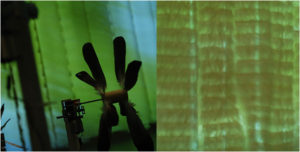
“We are the first generations born into a new and unprecedented age — the age of ecocide. To name it thus is not to presume the outcome, but simply to describe a process which is underway. The ground, the sea, the air, the elemental backdrops to our existence — all these our economics has taken for granted, to be used as a bottomless tip, endlessly able to dilute and disperse the tailings of our extraction, production, consumption.”3
Casualties is not a call to action but a dirge, room silent but for the mechanical sound of small motors. Unfortunately, the human-centered reduction that Barbier’s sculptures outline, a false dichotomy in which we can only “save” or “destroy” nature, is undermined by an associated event. In a catalog insert, we are invited to a workshop on Preventing Bird Strikes. In this two hour workshop, we can learn to “create [our] own DIY devices to help birds avoid collisions with reflective glass surfaces.” The disjunction of human and natural is a much deeper issue and Barbier’s installation poetically makes visible a small intersection in civilization that is incredibly complex, and broken.
_
Images and video courtesy of Annette Barbier
Pencil / Line / Eraser, the current exhibition at Carroll/Fletcher, spanning both the main Eastcastle Street gallery and their nearby Riding House Street project space, is well worth a visit. It’s never less than engaging and there are several pieces that lodge, linger and ferment in the mind long after the bus or train ride home.
They describe the show as “surveying recent works in expanded drawing which use paper and line as a point of departure” and, let me say again, whatever I have to say that is critical you won’t waste your time there. Far from it.
This review will be in two parts – first, & with an innocent(ish) eye, I’ll sing the praises of the work that itself sang to me during my visit and then I’ll vent about the things that irritated me, more a question of contextualisation and commentary than of the work itself, although in today’s text ridden and intention trumpeting artworld it’s sometimes a little difficult to unpick one from the other. Since the artists cannot completely escape responsibility this has consequence for any assessment of some of the work.
In a space of their own, a little into the main gallery, there are three pieces by the Portuguese artist Diogo Pimentão and they are delicious – large pieces of heavyish paper covered with graphite and folded, draped and rolled. Two are delicately attached to the wall so they appear to float there and the third sits up on the floor like a long fierce graphite flue.
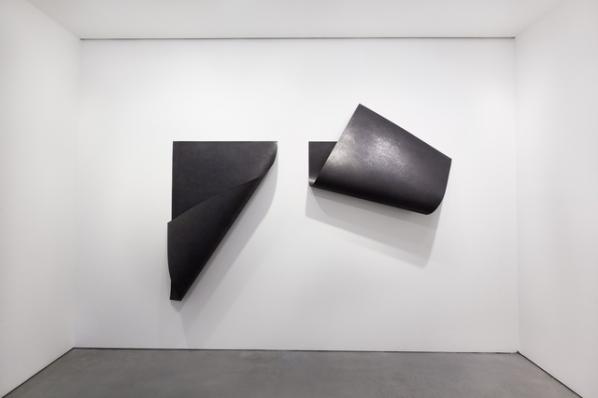
The works capture superbly paperishness: its particular foldiness, rolliness and drapiness and its ability to suck up pigment in large quantities (fields rather than lines here) Indeed the graphite covering softens the folds and creases so what we experience is a kind of Platonic report on the qualities of paper. The urge to touch this gorgeousness is almost irresistible.
The works strongly recall Richard Serra (though what I perceive as his machismo is entirely absent) – his early large scale drawings using a single dark medium, ink or oil stick, but also the torque and defiance of gravity that is so much part of the steel pieces. I’ve no idea whether this is a conscious borrowing but to point it out is not to criticise the work in any way because it feels like a commonality of subject matter –the stuffness of stuff – rather than technique, despite deceptive (and magically so) similarities of appearance. (It takes a couple of beats to fully realise that Pimentão’s work is work on paper and not something else.)
Further along to the left in the stairwell is one of a number of films by Wood and Harrison. Some of their work strikes me as a tad glib – smart but somehow too undemanding of thought and which tickles the viewer’s tummy (and amour propre) a bit too readily. And I apply this to their other pieces in this show – the paper which moves (conveyor belt?) beneath hands holding both a pencil and then an electric eraser makes me want to shout “I get it, OK , I get it! I get Rauschenberg, I get updating pieces to the digital era, I get a certain fashionable emptiness…”
The piece in the stairwell, though, is a different kettle of fish. Entitled ‘Fan/Paper/Fan’ it does what it says on the tin. A pair of hands places a piece of paper between two fans blowing towards each other in such a manner that the paper temporarily defies gravity and stands on its edge on its shorter side. Well, not so much stands as staggers like a gleeful drunk, manic ballerina or even someone just desperate for a pee. Then it falls and the hands re-position it, and maybe it’s just me (and even if, I offer it to you as an affective pathway to the work) but here, rather than a closing off or a patness, there is a tremendous opening out – the metaphor of the paper’s embodiment resonates with the human figure who intervenes and helps (or tasks) it. It’s difficult to resist anthropomorphising the fans, too, as windheads in map corners or Tweedles Dum & Dee. I’m going to use the artworld kiss of death term “moving” to sum it up.
The second two artists I want to hymn are to be found in the project space. The first is Sam Messenger who makes large scale abstract drawings on dense paper which is subjected to some sort of weathering process – hence, I assume, the mysterious listing of saltwater in the description of one. The net or skein of white pigment which floats upon a dark and varied but subtly modulated wash is applied according to some sort of Fibonacci based algorithm (as per usual with artists and maths the actual detail is elusive). Much play is made of the ceding of control which goes with this, together with the, therefore somewhat surprising, point that this algorithm doesn’t permit a prediction of the drawing’s final state at any point before this is reached. I get it, though, I think – the set of conditions must be firm enough to follow straightforwardly and to yield visually coherent results but at the same time there must be some choices, forks, within the procedure. What this yields is a complex detail nothing short of exquisite. Particularly lovely is the way that the drawings bulge away from the wall and also just how lost in their surfaces one soon finds oneself. It took me a little while to believe that the white “surface” network was not applied in some mechanical way (especially given the prevalence of mechanical /digital assistance/participation in the work of some other artists in the show) but close and detailed examination reveals uncertainties in marking that could come only from a human hand.

The final piece in this tour of highlights and, on a best till last basis, the one which affected me the most is a single piece by Christine Sun Kim, about whom more after I describe both the work and my first response to it. We see a drawing of a text, of three systems of horizontal lines resembling music manuscript staves (though in each case one or more lines short of the usual five) and smudges. The largest of the smudges and one which suggests it contains some colour – it’s curiously difficult to tell, I think it does – sits athwart the middle system of lines. Elsewhere there are much smaller patches which presumably arise out of a loose way of working with the charcoal of the lines. These lines themselves are gorgeous, varying markedly in width (but remaining lines, not shapes) and performing a similar balancing act with their relation to the horizontal, from which they depart but never enough to threaten our reading of them as such. Above the top left of the system of lines there is a text in clear and deliberate but slightly spidery sober brown capitals which reads FEEDBACK AFTERMATH. “Sounds like the name of a heavy metal band,” I remarked to my companion, who laughed gamely. But there is something bold and mysterious about it. After the band name, motivated in part by the horizontality of staves, their wavering might conjure a seismographic recording, or simply (and especially in the context of this show) some kind of algorithm at work. All this far from exhausts the visual pleasures of the piece. The central positioning of the marks, the feeling of a space divided into mark and void but at the same time a void graduated from nothingness up through a series of increasingly visible smudges. The palpable sense of the performative in a drawing like this. Oh it’s great! I wish you could see it! You can! (until Sept 13th 2014) Go.
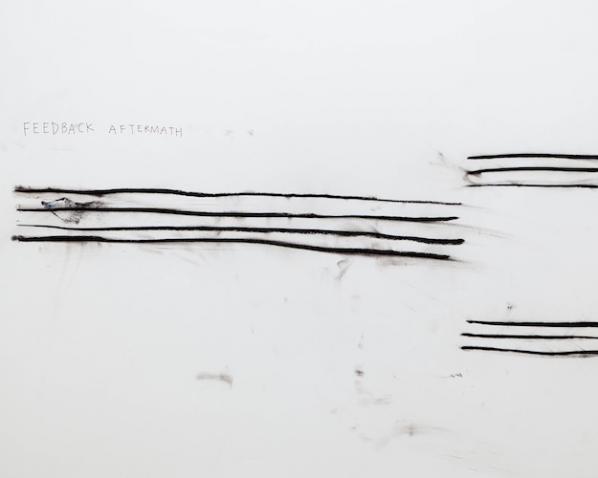
On reading the handout we discover that
Christine Sun Kim, who has been deaf since birth, explores the materiality of sound in work that connects sound to drawing, painting, and performance. Her performances are often the starting point for works on paper that display witty evocations of powerful sounds or loaded silences.
I quote it not to flaunt my perceptiveness but to observe how vigorous and alive the work is even without contextualizing info. It wouldn’t matter a two-penny damn if read the “wrong” way either, it’s the sheer power, variety and beauty of the mark-making and its appeal across a whole range of things from cultural codes such as music and language, through graphs and charts through to the facts of our embodiment – our perception of dark and light, our manual dexterity or surrender to chance, the need to play, the right to say ‘fuck it!’ and leave that mark there; to own it.
So what is my beef? Part of it lies in the curatorial notion of “expanded” drawing, a conceptual movable feast. It implies some kind of comprehensible set of practices which make drawing –what? –more expressive, more up to date, capable of things that were previously not possible… I don’t know, neither do you and neither does anyone. At its most straightforward one could read it as works made which are somehow adjacent in some way to drawing –so a number of works involve moving image works of drawings or the act of drawing. But hold on –there’s a perfectly respectable word for this which is animation or, if this is stretching it, moving image work with drawing as its topic. I would be reluctant to call these works themselves drawings, expanded or no, with the exception of Fan/Paper/Fan where a path is drawn by the jittering paper. Likewise much play is made of the uses over the last forty years of mechanical means of ..er..drawing. Except one feels the weight of history and usage would fall more appropriately behind the simple print.
It probably wouldn’t be worth losing any sleep over it all except this comes to a head for me in two large scale works, one at each site. The first is a piece by Raphael Lozano Hemmer whose
Seismoscope device detects vibration around it, from footsteps to tectonic shifts, and records this vibration on paper using an automated XYplotter. As the Seismoscope registers a seismic wave, it is programmed to draw an illustration of a single 11th Century Sceptical philosopher, over and over again. The actual traces of the drawing follow a random path, while staying within the portrait image that has been burned into the memory of the device, thus each drawing emerges unique.
And each of these drawings to date is pinned up on the adjacent wall on a daily basis (although in a move that doesn’t exactly bespeak confidence a “completed” version is retained in the “out” hopper of Lozano Hemmer’s machine so that we can see what it’s like.) What one sees on the wall is a series of drawings which appear to have stopped at various points in the process of being plotted out. It looks as though something about the software tends to create a blotch of ink at that stopping point. Otherwise the images are hard to distinguish. The descriptive text is evasive about how the tremor detection feeds into the plotting process. Does an initial tremor start it or is it merely that the tremors alter the manner of laying on pigment within the template that is already programmed into the installation so the lines go on in different ways within the bounds laid down? The words sledgehammer and nut occur when such a fetishisation of the digital and mechanical is applied to results which are..well… kind of OK-ish but contain, even conceptually (lest I’m accused of being unduly optical) little to move or amaze.
There’s a similar mountain labouring to bring forth mouse situation with Julius von Bismarck & Benjamin Maus’s (ha! Just noticed!) Perpetual Storytelling Apparatus which, in truth, is a beautiful thing to behold –a wall mounted plotter which spews forth a seemingly endless scroll of printed paper, populated, the notes tell us with that hubristic gigantism that so often afflicts such documents, by drawings from “seven million patents – linked by over 22 million references”. The mechanism is easily explained (and perhaps this itself is significant). There is a root text (for one showing it was, apparently, Alice in Wonderland) and by the miracle of software and data equivalence the text is translated into a set of illustrations comprising drawings drawn from the previously mentioned patent database which are then printed out onto the scroll of paper. The artists don’t reveal the source text until after the close of the show. As noted, it’s a handsome process to watch and the drawings have the strange surreal beauty of the technical drawing uprooted from its context but there is an implicit claim made by the artists with their title (supported explicity by the curatorial “New visual connections and narrative layers emerge within the telling of this story through the graphical depiction of technical advancements”) that something resembling a narrative emerges from all this hoo-ha. To put it bluntly – it so does not. You would have to strain your imaginative faculties enormously and do some heavy duty cultural forgetting to even begin to find narrative here, because the images on which the thing piggybacks are so distinctive, strange and beautiful in and of themselves. It’s instructive to compare this rather polished and curator friendly but ultimately disappointing piece with the wonderful and messy anarchy of its distant ancestor, MTAA’s Endnode (aka Printer Tree) of 2002 where a cheap and cheerful plywood tree with printers in its branches dispensed prints of posts to a created-for-the-occasion e mail list. (Images: http://www.endnode.net/install.html background: http://www.endnode.net/index.html)
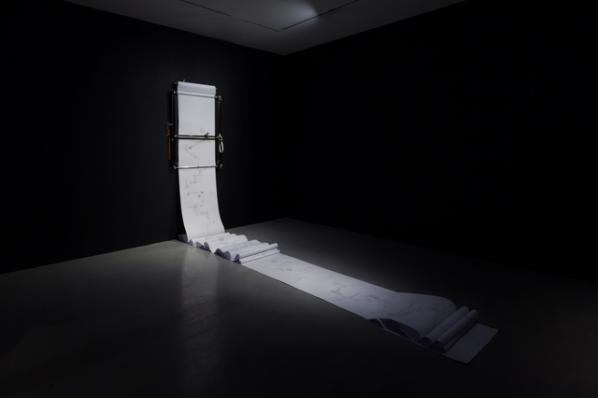
So I want to finish by saying, once again, this is a great show. There’s a lot of good stuff I haven’t even mentioned, some of Evan Roth’s work in particular. But its basis bothers me a lot – I’m certainly very far from wanting to exclude the digital, the mechanical and the procedural from an as yet to be really seriously defined expanded drawing practice but at the moment it is still drawing’s appeal to and demands on the artist’s embodiment and our embodied imagination that give rise to by far the most engaging work here.
Pencil / Line / Eraser
At Carroll/Fletcher
1 August – 13 September 2014
Google is breeding the young minds of the next generation of artists.
Don’t take me wrong, it’s not my opinion, it’s simply what Google states in the marketing campaign (see the heading image) that is accompanying the infamous DevArt exhibition at the Barbican in London.
There has been an intense debate in the past weeks on what this powerful curatorial and marketing move by Google actually means. Will it affect or benefit the already unsteady and ephemeral world of digital art, and how? The discussion have rapidly condensed over the web in the form of newspaper articles, artists-led initiatives and discussions on the web through twitter and pastebin statements.
After following the whole issue in a quasi-silence, I felt the need to make a statement and share it with you. I won’t loose more time on a preamble and will get straight to the point.
Let’s start with a curious observation, the term that Google marketing team has chosen for their campaign is “breed”. The first meaning of breed is “to produce offspring, typically in a controlled and organized way”. Quite telling, isn’t it?
To think that largely incorporated entities, such as the Barbican and Google (Google Creative Lab to be precise), are being ingenuous or ignorant or naive and thus, that their initiatives won’t have a relevant impact implies a rather distorted viewpoint.
It’s like staring at a man putting a match to a haystack, and thinking nothing bad will happen because the man doesn’t know the haystack will be reduced to hashes.
This is an easy way to discard a much deeper problem which outlines some seriously worrying links between digital art curation and its relation to the art establishment and the incorporated lobbies. Links of which most times, we are either unaware of or worst, not interested in.
To bring more arguments to the table, the ones below are some other tips of that monstrous iceberg:
a) the involvement of Sound and Music in another Google-curated open call for emerging sound artist happened earlier this year under very dim lights; note, another intervention in the UK.
b) the massive cultural hijacking project by Google, which they aptly termed, “Google Cultural Institute”. Which, far from being a mere digitisation of museums catalogues, is being used as a means to curate events and open calls which, as for the DevArt, are aimed at breeding **young artists** (yes, breed, like animals in captivity), as in the case of the collaboration with Sound and Music above. Young artists does not mean 30-years old emerging artists. Young artists are student, part-time workers that follow their passion and dream of being able to live with their art, or maybe simply being able to express their art. As all of us started.
c) on a slightly different but related note, the boom of Sedition, an online platform designed as an appealing app market for well-packaged and well-known artworks. And I do not mean to take away any of the artistic value of the works sold there. Despite the fact they just opened doors so very recently, they had a stand at this year Sonar+D. Just to exemplify the links already in place.
Now, all of this shows that Google, the Barbican, Sound and Music, and many other entities which we are not aware of yet, have *already established* intimate links to work towards new ways of “curating” (or perhaps “commodifying” is a more accurate term) digital art, sound art, music, etc..
What we see and discuss today is the result of several months, if not years of discussion, planning and agreements, both financial and curatorial.
I don’t think there’s anything we can do to directly disrupt those links, given the scary results they have led to so far, but what one must do is to become aware that this is not a game of capricious millionaires.
Google is one of the richest capital holder in the world, a corporation who owns and develops the best machine learning techniques, who bought the best 6 companies in humanoid robotics, who works with US military defense developing technologies for them, etc. etc.
Stating the obvious here, but sometimes it does not hurt.
If they are investing so much in digital art it is fair to think this is not a caprice but a well-thought and far-reaching business plan. As any of their other businesses.
How do we claim our position in their business plan? Is that what we want?
Or perhaps, can we work towards alternative programs? If so, how?
The comparison with art patronage across the centuries does not work in this case, it’s just more smoke in the eyes. Renaissance art patrons didn’t have a database of all your documents, pictures, chats, videos, calendar and locations.
This article was originally published by the author at his personal research blog.
AS FOUNDER/DIRECTOR OF THE MEDIA ARCHEOLOGY LAB IN COLORADO, LORI EMERSON HAS (since 2009) been surrounding herself with “dead” media technologies in order to help make sense of (and critique) today’s much-hyped alive ones. Being also a scholar and critic of contemporary poetics, she is keenly aware of how such devices are equipped to influence and constrain our writing/thinking.
Emerson’s work celebrates and calls for a “frictional media archeological analysis” aimed at the continual “unmooring” of the accepted conventions of reading and writing. Towards this end, she critiques consumer-oriented trends in computing–trends which unfortunately seek to “efface the interface” in the name of so-called user-friendliness. Montgomery Cantsin conducted the following interview by email upon the release of Lori’s new book, Reading Writing Interfaces (recently published by University of Minnesota Press).
Montgomery Cantsin: First, I want to point out that your new book is part of a series which was founded by Mark Poster, who passed away not too long ago. Can you talk about how your work fits into his “Electronic Mediations” series and what (if any) influence Poster has had on you?
Lori Emerson: Mark Poster has been an underlying, though subtle, influence on my work as I first read him in a graduate seminar I took on “cybercultures” in the mid- to late-90s with the Victorianist and early hypertext theorist Christopher Keep. That class and Poster’s work–his deeply political readings of digital media structures–stayed with me long afterwards. In fact, about seventeen years ago I gave a presentation on “Postmodern Virtualities” in that class and while I have no memory at all of what I said or even what I learned from reading his work back then, it’s remarkable that his opening sentence rings so true to the kind of work I now find myself doing–he writes that “a critical understanding of the new communications systems requires an evaluation of the type of subject it encourages, while a viable articulation of postmodernity must include an elaboration of its relation to new technologies of communication.” And so the point at which I realized I was, to my surprise, writing a political book that meshed together poetics and media studies was the point at which I realized that my work would likely fit in best (or, given its reputation in media studies, I wanted to make my work fit in) with the Electronic Mediations series, especially because of their books on tactical media, glitch and error, as well as the politics of archives and networks. It’s such a thrill and an honor to have my book included in that series.
MC: How did your Media Archeology Lab come about?
LE: I was fortunate enough to have the support of the past director of the Alliance for Technology, Learning, and Society when I was first hired here at the University of Colorado at Boulder in 2008. In 2009, the director, John Bennett, offered me a $20,000 startup grant to build a lab, any lab, that Atlas and English Department students could both use. I then began looking for a way to build a lab that wasn’t just another venue on campus to celebrate the perpetual new in computing and, since I was at the time fascinated with how the Canadian poet bpNichol wrote one of the first kinetic digital poems, “First Screening,” in 1983 using Basic on an Apple IIe, I decided to create a lab that had enough Apple IIe’s to teach bpNichol in a classroom full of 20 English majors. It didn’t take long before I moved on to acquiring Commodore 64’s and then to where we find ourselves now, with a collection of about a thousand pieces of still functioning hardware and software from the mid-1970s to the early 2000s. I also have to admit that the MAL wouldn’t be what it is now if we weren’t flying under the radar of the university for the first three years or so. The relative obscurity of the lab in those early years meant that we had little to no oversight, no one to report to, no metrics or outcomes to adhere to, and so on which meant we were free to be as wild as we wanted.
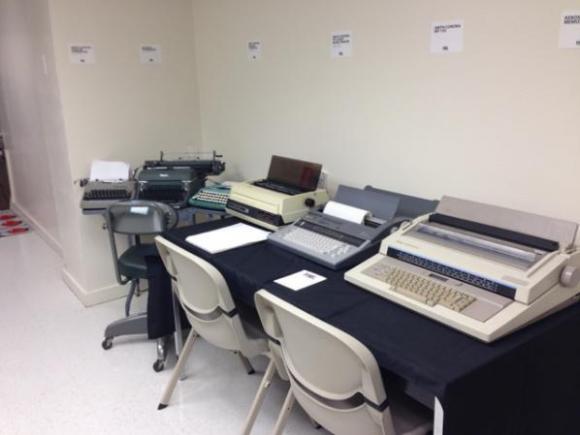
MC: In trying to explain your book to a friend, I admit I had some difficulty. I found that it was (for me) hard to do without making the subject of the book sound obscure. And yet I feel that the issues raised in the book are actually quite significant/fundamental. …Let’s delve right into the concept of the interface. As you point out, digital interfaces are now being made “invisible” by manufacturers in the name of “naturalness,” and so it is hard now to even point to a modern interface and say “this is an interface.” At one point you quote Alexander Galloway, who defines an interface as a “point of transition.” (In other words it is a sort of boundary?) You also quote Johanna Drucker, who says that a book can qualify as an interface!? …Is it useful here to ask what’s NOT an interface??!
LE: I think that, similar to Marshall McLuhan’s notion of ‘medium’ which he even extended to roads (and then had to endure a couple decades of ridicule from academics), interface can indeed be anything that’s an intermediary between a human user or creator and what is being created. But unlike using ‘medium’, ‘interface’ seems to allow us to focus our thinking on the particular affordances of specific intermediary structures. It’s not especially unusual or even useful to point out that paper is a medium but, by contrast, calling it an interface summons up not only the material qualities of paper (the grain, size, texture, limits and possibilities for inscription) but also pens and pencils along with that crucial point of interaction that’s between–between writer or artist and their materials. But I also suspect that some of the significance of the concept as I’m using is lost when you start from an arbitrary point in the past and think about needles as interfaces for needlework, or rocks as interfaces for etchings or engravings. Instead, ‘interface’ gains traction when we use contemporary notions of it to have a see-saw relationship between present and past–reading contemporary interfaces through past interfaces and vice-versa. In this way, my book is resolutely of the present because I tend not to delude myself into thinking I can have a pure, direct access to the past. Instead, I start with the closed interfaces of the present moment whose manufacturers try to convince us that a closed device is the only way for us to have a supposedly “natural,” “intuitive,” “seamless” experience with our digital devices; I then work my way back in time to reread typewriters and fascicles or handmade books as profoundly open and configurable interfaces but still with their own limitations.
MC: I was delighted to see that the first scholarly name you drop into your text is that of the amazingly awesome Florian Cramer, the second-wave Neoist. You say he importantly identified eight different types of interfaces. Of these eight, the type that you identify as being of particular interest to you is the “human-to-hardware” interface?
LE: I’m interested in thinking about how certain (largely profit-driven) decisions about interfaces for human-computer-interaction fundamentally affect the human user–determining their access to information along with what and how they’re able to create. This uneven distribution of power between user and digital computer is most obvious when we start to think about why the keyboard/screen/mouse interface has become the only way for us to interact with our machines or when we look at the history of how a particular notion of the Graphical User Interface was used to advance an ideology of the user-friendly. While I am obviously quite dedicated to certain aspects of media archaeology that believe in the value of looking at the operational undersides of machines and the ways in which these machines can now operate quite independently of humans, in Reading Writing Interfaces I’m most concerned with how humans are now almost totally unable to think outside of the current dominant paradigm in computing. This is why I’m less interested in hardware-to-hardware configurations and more interested in the space between human and hardware–as well as software.
MC: I like how you point out that the closed interface can be a sort of metaphor for ideology (‘that which we are not aware of’). This part of the book blew my mind and I’d love it if you could expand on this here.
LE: I’m fast and loose with how I use ‘ideology’ but, after going through every issue of Byte magazine from the late 70s through the mid-1980s after the release of the Apple Macintosh–mostly just to see what I’d find–I became convinced not even that contemporary computing interfaces are metaphors for ideology but that they are themselves expressions of an ideology. Somehow what was at first a battle between competing philosophies in the 1970s–between a model of computing based on openness and a model of computing based on a closed interface for the sake of a very particular notion of user friendliness–gradually turned into an all-out marketing campaign by Apple that was so successful users/consumers are barely even aware of other possible versions of computing. These closed interfaces have become so familiar, so accepted as the so-called ‘natural’ way for users to access their computers, that we are mostly utterly unable to imagine any other alternative. Over and over again, we’re told: “Computers are only getting easier, more intuitive, more natural to use!” Or so the story goes, until you either try to understand how exactly our digital devices work. Or until you try to create outside of a corporation’s rigid developer guidelines. Or until you come up against the impossibility of working with a closed device whose “seamless,” “natural,” “intuitive” user interface doesn’t in any way conform to your own sense of nature or intuition and can’t be rebuilt, remade, or reassembled in your own image because in computing words like “seamless” and “natural” are code for “closed.”
Something I’d love to research more is how this ideology of invisibility is not a reflection of a particular aspect of capitalism (as I thought when I wrote Reading Writing Interfaces) but is actually one of the key underpinnings of a capitalist economy. I recently learned from reading Kirstyn Leuner‘s dissertation that the diorama–which emerged in the 1820s in Paris not coincidentally at the same time as early industrial capitalism began to get its legs (and only twenty years before Marx would move to Paris and begin formulating Capital)–was also produced and marketed as a “magical” device whose inner workings were kept hidden from viewers in the interests of providing an immersive experience. But I admit this is all just a hunch.
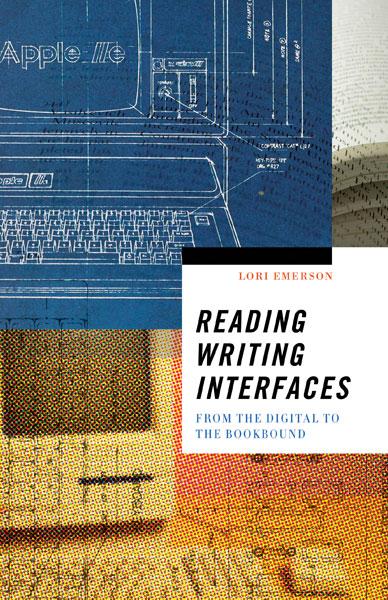
MC: The Situationists called for a seizing of the “means of conditioning.” Should we also aim to seize the means of programming? And what connections might we draw between these two projects?
LE: As I try to imply above, contemporary computing is one of the most profound manifestations of late capitalism–I only have a superficial understanding of the Situationists but, ultimately, the only reason why our devices are now not only closed to us but gradually disappearing under the guise of ‘seamlessness’ is because, from a profit-oriented perspective, a universal homogeneity of devices is the ideal; and now, to accelerate that homogeneity, these devices must also be invisible. It does seem to me that the way out is to hack, appropriate, seize, rebuild in our own image. The only problem is that even ‘hacking’ and ‘making’ have become big business, as Make Magazine and all its spin-off projects (Maker Faire, Craft Magazine, Maker Television etc.) continue to be enormously profitable and as mega corporations such as Google and Facebook hire hackers and even hire Occupy Wall Street activists. Nonetheless, I have a tremendous amount of respect for utterly unprofitable experiments in taking control of our technology–I’ve begun working on my next project I’m calling OTHER NETWORKS which looks at networks that exist outside of or before that behemoth “the internet” came to dominate our online interactions. One project in particular, Occupy.Here, seems to fit in nicely as a Situationist-inspired seizing of the means of programming in that it is a network that exists entirely outside of the internet via a wifi router near Zuccotti Park in New York City which anyone with a smartphone or laptop can access through a portal website. In other words, it offers us a beautifully simple, elegant way out of the way the internet disempowers us through a system of distributed control.
MC: It used to be that people could take apart and reassemble the mechanical devices in their lives (toasters for example), and these devices were constructed with universal parts (screws, etc) …How can the tinkering impulse survive in the face of smart devices, blackboxing, proprietary components, etc.? (Maybe not everyone is a tinkerer, but…)
LE: I’ve wondered the same thing but projects such as Occupy.Here and devices such as Raspberry Pi (that are as inexpensive as a book) or platforms such as Arduino that are meant to help us build other devices give me hope. But also I think it’s important to remember this blackboxing is largely (but of course not only) driven by Apple and that, as I’ve come to learn, this tinkering impulse is alive and well in countries outside of the U.S. For example, I recently met a graduate student from Israel who assured me that nearly all of her friends and family members living in Israel used PCs or Linux devices and everyone regularly takes apart and fixes their machines. This was quite a revelation to me, to realize that the overwhelming push to disempower users/consumers with closed devices may be a western phenomenon.
MC: Your book suggests that an interface that is truly going to be a “friend” to the user is NOT necessarily an interface that is going to make all the fundamental decisions in advance for the user, etc. Maybe talk about how future interfaces might possibly instead more fully engage the creativity of the user (and/or invite the user to engage at a deeper level with the capabilities of computers)? Also, can such be accomplished in a way that draws in all users and not just geeks?
LE: Uncovering documentation from the 1970s on Smalltalk and on Alan Kay’s vision of a Dynabook (as a device that would have given users the ability to create their own ways to view and manipulate information) demonstrated to me that there are real alternatives to the binary of experts on one side and everyday users on the other. This is a false dichotomy, a convenient construction invented to convince people that closed devices were, as an advertisement for Apple Macintosh put it, computers “for the rest of us.” It is perfectly possible in theory for us to have interfaces in the future that are open, extensible, and configurable to the expert or novice user. The problem is, first, that there’s no way to avoid the need to institute nationwide education in programming and digital literacy in public schools as I imagine that any device built for configurability will also have to be programmable; and second, it’s hard to imagine a configurable, programmable device that will generate maximum profit – companies and western consumers would have to change in a radical way that seems unsupportable by the dictates of late capitalism.
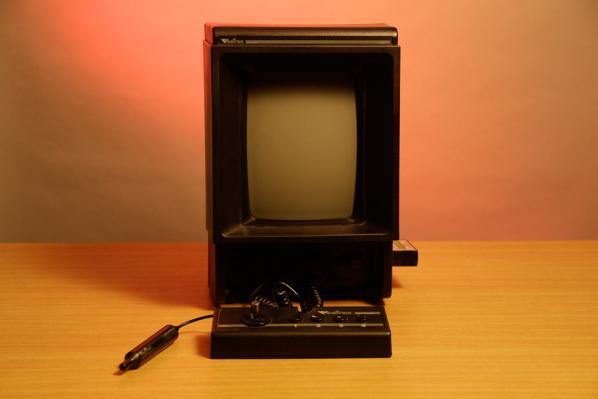
MC: The computer’s identity as tool for efficiency seems to overshadow the computer’s poetic potential. I use ‘poetic’ here to mean “the development of absolutely new forms of behavior”–a Lettrist definition of poetics which is notably similar to Mckenzie Wark’s definition of hacking (which you cite): “creating the possibility of new things entering the world.” …Has the poet always been a sort of hacker?
LE: I think so! Seeing writing, especially innovative poetry that lives on the edges of acceptability, as studies of media has brought about a profound shift in my thinking so that I’m no longer interested in trying to seeing through letters and words to get at the representational meaning but instead I think about how the writing registers media effects. I’m not sure how far back you can go in literary history and make this work, but there’s no question in my mind that poets such as Emily Dickinson, Stéphane Mallarmé, and of course a whole host of experimental early twentieth century poets were pushing up against the limits of what the media of their time could and could not do for/with writing. And to the extent that these poets are engaged in a continuous cycling of tinkering with the limits and possibilities of writing media of their time which in turn re-enlivens our language, it does seem like poetry [defined as such] could be seen as hacking.
MC: Diane di Prima wrote: “THE ONLY WAR THAT MATTERS IS THE WAR AGAINST THE IMAGINATION / ALL OTHER WARS ARE SUBSUMED IN IT” [emphasis in the original]. Do you think we have the means to win this war (which is also, it would seem, Richard Bailey’s “war against conventionality”)? To what degree is it a question of interface?
LE: Nearly all of our tools, no matter how simple, are interfaces for accessing other sets of tools (think of hammers and pens as interfaces to access nails and paper) so that not only are nearly all our actions mediated by interfaces of some sort but also there may not be such a thing as an unmediated, interface-free interaction. So, it’s possible to say that it’s always been a question of interface–the problem now is that corporations are making it as difficult as possible to perceive these interfaces and to see how they’re mediating and even determining our experience.
To get to your question about imagination, it’s getting harder and harder to be weird, or even encounter the truly weird which, for me, is “imagination”–existing in or seeing the world askew, envisioning new kinds of existence in the world because everything is indeed mediated tightly and thoroughly for us, making it next to impossible to be anything but a consumer. In this sense, winning the war could come down to making or producing either as an end in itself or as a means to just exercise imagination.
JENIFA TAUGHT ME
CONSTANT Dullaart’s solo show Stringendo. Vanishing Mediators, Caroll/Fletcher.
Occupying both floors of the ultimate O’Doherty white cube of Carroll/Fletcher, Dullaart’s first solo UK survey show Stringendo, Vanishing Mediators consists of 27 works – many of them newly commissioned. The works have in common Dullaart’s pervasive aspirational tactic of queering and laying bare the architecture – both physical and virtual – of our networked yet doggedly analogue broadcast lives. Retaining a sense of sepia-tinted nostalgia for the Pong era Internet, many of the works in the show pay tongue-in-cheek homage to the revolutionary and democratic aspirations placed on the web at the beginning of its popular adoption – albeit primarily by white, male middle class Americans. Throughout the exhibition, Dullaart forensically tracks, seeds and traces remnants of our digital past and places them in direct dialogue with the power relations embedded in the terms and conditions of how these technologies have remediated the way we encounter and interpret our world now. This unveiling and excavating of the digital gesture – whether personal or brand mediated – and the freezing of the smoke and mirrors affect of software semantics isolated on the plinth of the gallery. It will be familiar ground for many of us in the business of the aestheticization of our precarious position as prosumers in surveillance society. However, as Dullaart lays bare the soft terrorism of the interface and the slowly encroaching disillusion of the clunky binary “digital” and the “physical”, he points towards a new way of visualising the architecture of our messy public/private, social/political pathological states of disarray by introducing The Balcony as a newly envisaged site of resistance and broadcast.

Stepping off the street and into Constant Dullaart’s recent solo show Stringendo, Vanishing Mediators at Carroll/ Fletcher on a sweltering summer afternoon I am immediately transported into a trippy AC’d noughties Snappy Snaps.

Dullaart’s signature, and now Guardian-famous, eponymous series Jennifer in Paradise acts as the hero image for the immersive world of blissfully glossy software-mediated wallpaper and slickly produced lenticular prints hanging in the entrance gallery. A Miami-hued display of software’s extensive lexicon of brushstrokes, filters and masks is flamboyantly demonstrated on the lonely yet aspirational image of a beautiful woman sitting on the beach looking out onto the tropical horizon. The promiscuous past of this image is well rehearsed; from its origins as a 1987 holiday snap – taken by co-creator of Photoshop John Knoll – to its use as crash test dummy for his ground-breaking popular software and its voracious adoption by the newly indoctrinated Photoshop masses as a subject of visual vivisection frames the staging of this exhibition. Dullaart’s archeological impulse to sniff out the rare software artefact of Jennifer points towards a general fetishization of the magic tipping point of the analogue/digital past –conjuring up a time when photography’s authenticity was still a battle to be fought. In a conversation with the artist at the appropriately ambiguous location of The Photographers Gallery shortly before his show opened, Dullaart emphasises the enduring pull of the image in his own practice. Describing the logic of the exhibition’s strategy, he sees the pasting of the Jennifer wallpaper as a “doubling” [1], or colonisation of his ongoing Jennifer experiment.
Dullaart’s Jennifer journey through the lexicon of data manipulation started when he embedded a secret stenographic message in the first re-appropriated images of Jennifer as a kind of “prize” for his growing online viral public. The first iteration(s) of Jennifer in Paradise explored the Internet’s opacity, highlighting the extent to which onscreen data is manipulated and controlled, enhanced or deformed. By celebrating and transporting the cyber-famous Jennifer into the gallery context in the form of selective editions, copies, or “abbreviations” of the digital, networked manipulation of the image, these artefacts act as both signifiers of the artists’ practice and as tempting photographic editions in their own right. A fact the artist is well aware of. However, the overarching social commentary implied in the freezing of this signifier of mass viral circulation is that the image became a coded Trojan horse for the prosumers’ 2.0 hypermarket as it was seeded, tracked mediated, remediated and mimetically distributed through the newly democratised digital commons.
It is in this mimetic gesture of versioning – a trope embedded in the very DNA of software development – that the artist does not just reference and make visible software’s surface gestures, but actually performs software’s versioning impulse, exposing it as a form of corporate cultural imperialism and spotlighting the newly negotiated role of authorship in the process. The artist’s persistent and persuasive disruption of the role of authorship is a common and recurring obsession running through his practice – from objects, to online queering of domain names, to his performances. A personal/impersonal example of this is played out in the exhibition by a row of seemingly innocuous family photographs. The series of family pictures from the 1980s are, according to Dullaart, the cleanest example of performative authorship. The photos were simply sent to Apple co-founder Steve Wozinak for him to sign and send back to the artist – resulting in the “re-authoring” of Dullaart’s childhood memories. This simple performance of capital control and authorship of so-called private identity is mainlined into Dullaart’s practice, and speaks to the artist’s core impulse: “this is exactly what I do – I take what isn’t public and I re-posses and reprocess these artefacts and re author them into a different spectrum”. [2]
In another act of ambiguous reverie of the commercial canon of software are the three pieces entitled Bill Atkinson demonstation drawing, (no.5, 12 and 18) hanging on the other side of the gallery, positioned against the Jennifer-tiled wallpaper. These drawings from the 23 stages of the first drawing made by Macpaint creator Bill Atkinson are printed in monochromatic hues sandwiched between photopolymer plates. These meticulously restored physical gestures of one of the first drawings executed by commercial software are particularly important for the artist. He sees this attempt at drawing made in the “strong consumer software” of Macpaint as a kind of totem or signifier of the emerging lexicon of the new canon in art history.

Beautiful fetishistic rubbery objects in themselves, the physicality of these works demonstrates the materially-dependent, performative intent in Dullaart’s practice. As these monochromatic objects react and change to UV light – hardening and cracking – any collector of his work needs to embrace the precarious temporality of the objects themselves. This is true of all of his work – including domain names, websites, his own online identity etc. and Dullaart emphasises that the conscious situating and staging of his works in the framework of time is one of the most vital components of his practice.
This animated relationship to instability and time- dependency is clearly demonstared in his player paino piece Feedback with Midi Piano Player at the heart of the exhibition. An algorithm interpreting polymorphic songs is played out through the grand piano in the gallery in an apparent circus-like celebration of the computer’s magical powers. However,as the recital unfolds, it is full of little mistakes – the songs are too complex for the computer to relay in a coherent feedback loop. For Dullaart, the inaccuracy and amateur quality of the computer/piano recital delivers a quasi -human quality of cuteness – an increasingly desirable quality in our popular technology, and an indication of the drive towards the synthetic anthropomorphism of digital objects and structures in general. This inevitably recalls Marx’s highly questionable use of anthropomorphizing comparisons of the commodity to children and women to underscore the “fetish character” [3] of commodities – the phantasmatic displacement of the sociality of human labour onto its products, as they appear to confront each other as if operating independent social lives of their own. In this sense, the “cuteness” in Dullaart’s piece might be seen as an intensification of commodity fetishism’s logic redoubled (like Jennifer) – as the viewer is connected to the unavoidable fantasy of fetishism, itself already an effort to find an imaginary solution to the irresolvable “contradiction between phenomenon and fungibility” [4] in the commodity form.

However, if this “cuteness” maintains fetishism’s overarching illusion of the object’s animate qualities – in this case the clumsy performance- at the same time it wants to deny what, in Marxian terms, these animated commodities articulate as “Our use-value may interest men, but is no part of us as objects…We relate to each other merely as exchange values.” [5]
Dullaart then shifts his attention to the main focus of the exhibition – the conscious construction and showcasing of his proposition of a new way of entering into a contract with our networked, hyper-published -selves: the balcony. The two physical balconies presented in Stringendo, Vanishing Mediators (one of which is accompanied by a digital ticker-tape text of his Balconism manifesto) are both visual prompts and, in a sense, demos, of Dullaart’s concept of balconisation. In direct acknowledgment of the hyper- mediated image of Julian Assange standing on the balcony of the Ecuadorian Embassy in London – Dullaart starkly illustrates this liminal, politically charged space where we bear witness to a clear slippage between UK and Ecuadorian territory. To Dullaart, the balcony represents a ‘space outside society’ [6], and this new space of public address marks a shift in responsibility in self-broadcast/publication in the digital commons and the social media sphere. According to Dullaart, we all need to recognise our position on the balcony in our hybrid public/private pathology and modus operandi of quasi-addictive self-broadcast.
On the balcony we should be ready to escape the warm enclosure of the social web, to address people outside our algorithm bubble. In the context of the show, the balcony is positioned as a higher order theory for how we should respond to the process of digitalisation as a whole, to how corporations and programmes structure our understanding of the world. We need to stand on our particular balcony ‘and choose to be out in public and we have to define cultural codes of how to do that’. [7]
What Dullaart’s exhibition Stringendo, Vanishing Mediators offers anew is an alternative proposition of spatial code through which to understand our steadily (re) negotiated locations of private and public space and the possibility of somewhere inbetween from which to enact a certain kind of everyday De Certeauian [8] tactic – the Balcony.
Dullaart’s solo exhibition ended at Carroll / Fletcher on 19th July 2014.
Featured image: still from Fatima Al Qadiri / Sophia Al Maria HOW CAN I RESIST U
E-Vapor-8 is a very cool group show which looks and feels about as much like a club as you would want it to. It features a series of haunted works opening onto the “death of rave” — and what that death means, when it happened, and if it is still happening, are the most interesting questions provoked by a visit.
Works by Fatima Al Qadiri, Daniel Swan, Petra Cortright, Rhys Coren become the characters and rooms of a labrinthine underground culture which takes emotion, history, sexuality and race as its headliners and resident evil. It is a small exhibition, considering this scope, and perhaps not the show which the curators would lead us to believe.
The notion of cultural ‘Afterlife’ enters the fray as surely and convincingly as a sweaty-metallic-render 3D blade drifting though green wireframe. Afterlife is a ziegist topic – Transmediale’s Afterglow theme explored an afterward of an already exploded digital scene; Mark Fisher’s term ‘Hauntology’ connected Derridian theory to underround music/artists like Al Qadiri and Maria Minerva; and the recent New Death exhibition at FACT featured works such as Jon Rafman’s installation, depicting an indecent internet-accelerated-libido as a kind of end-of-the-world-is-now scenario. In these works and perspectives the realm of the afterlife is shown to be a nuanced one from which to view the epochal changes culture has undergone, and this is why a show like E-Vapour-8 feels so timely.
The name of the exhibition is taken from a 1992 rave track, but it also makes me think of the recent rash of e-cigarette shops…

and, more portentiously musical genre coinage I know from reading Adam Harper’s contemporary music commentary: vapourwave –
“At the end of the world there will only be liquid advertisement and gaseous desire. Sublimated from our bodies, our untethered senses will endlessly ride escalators through pristine artificial environments, more and less than human, drugged-up and drugged down, catalysed, consuming and consumed by a relentlessly rich economy of sensory information, valued by the pixel.” Adam Harper in DUMMY

Several of the best works here are available to view online, and benefit greatly from the throb and thurst of this gallery setting. Watching Daniel Swan’s Plane Drift V on a hi-def monitor, I appreciated the use of lo-fi pixilation as part of the affective ether of the work, as the utopian 3D crumbles into a flat and luscious digital irony. The video ends its loop on a frieze of a 3D plaque stating ‘Return’, evoking the role of the loop in dance culture, and the mode of reinvention in evidence throughout the show.

Fatima Al Qadiri’s tune How Can I Resist U with a new video by Sophia Al-Maria dominates the main gallery space with its unsettling deep bass underflows, and audaciously cool bringing together of urban architecture with international dance cultures. In the other room, Petra Cortright’s voyeuristic film Lara Practice shows a young girl trying out her ecstatic dance moves presumably to rewatch later – a tragic pantomiming of ‘happy hardcore’.

Other works play on the aesthetics of given rave cultures. Travis Smalley’s Wave Trancendence splays the multi-coloured trippy aesthetic of early hardcore flyers as a sickly overlush chill-out visual.
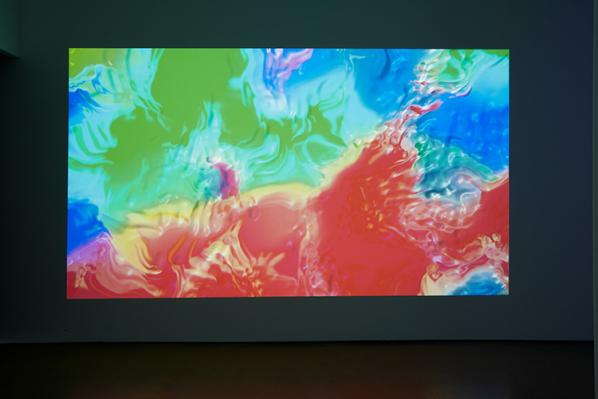
Adham Faramawy’s Lifeproof iPhone Cover revisits the metallic Photoshop filter and puts it in motion, his work simultaneously harking back to late-90s era Drum n’ Bass, while having the look and feel of a vapourwave.jpg – except instead of vapour-wave’s marble, the plinths and stands for Faramawy’s work ooze black foam, like an ashtray left in the alley behind your mum and dad’s for thirty years.
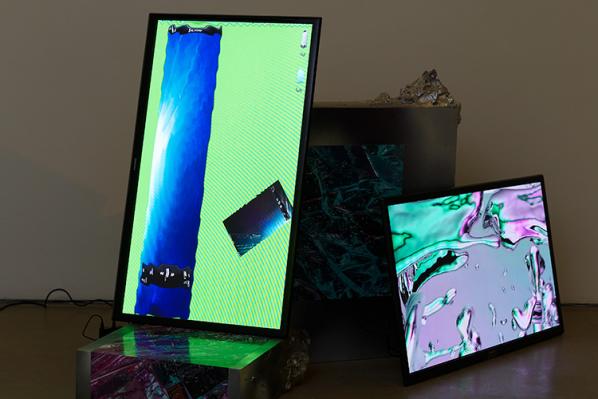
This incongruous collection of perspectives, along with the jostling beats across the whole show provoke a kind of nervy excitement. Installations in the show also play and elide bliss and paranoia. Harry Burden inverse-casts a crumpled car wing and paints it in a pearlised blue and green like a strange beetle.
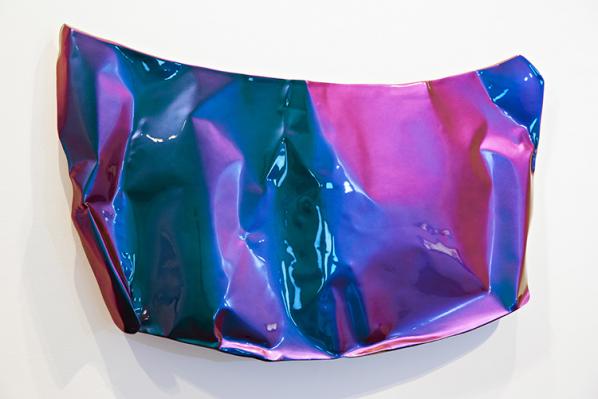
Alexandra Gorczynski’s liquid dream-like video peers up queasily from under a glittery canvas bedcover, and Maria Olsen’s gold tapes in a heap on the floor; each item together and the same, but the artifacts themselves – the music, the person – alone in their capsule.
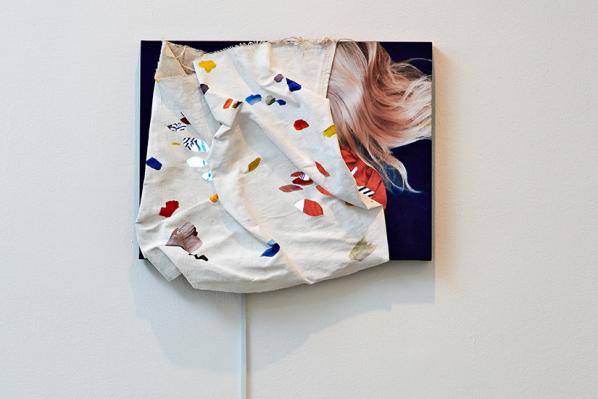

Only Rhys Coren’s playful video-loop doodles set across three screens to a chirpy four-four house beat seem unequivocally ‘happy’ – but we notice that even here, the screens face away from each other, and the animations jiggle on their own buzz.
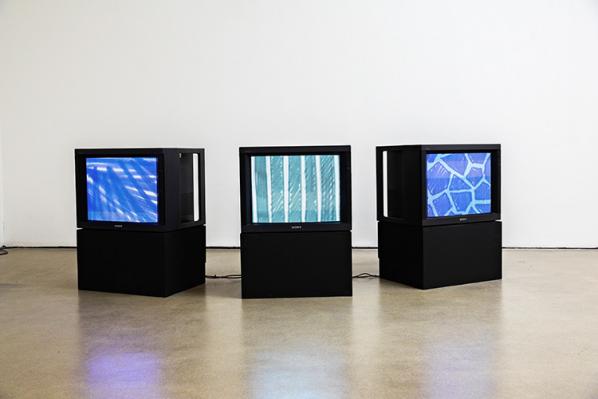
Sitting off in the corridor like a rushed-out raver afterwards, the trouble with this show sinks in. In her short introductory essay, curator Francesca Gavin acknowledges that many of the young artists she features are not old enough to have experienced the first ‘white glove’ rave referenced in the title of the show, but neglects to acknowledge the life of rave and dance culture which these ‘subsequent’ generations find ourselves mourning. To an extent, the use of Acid House here has more to do with marketability than criticality – but to jump right from early 90s rave to the work of an artist like Harry Burden, Adham Faramawy or Fatima Al Qadiri, and to locate the older Jeremy Deller’s smiley-face poster artwork at the ‘fulcrum’ of this show, is to willfully ignore the racial and social complex of the Drum’n’Bass, Techno and Trance which followed (as documented most memorably by Simon Reynolds in his Hardcore Continuum series for The Wire).
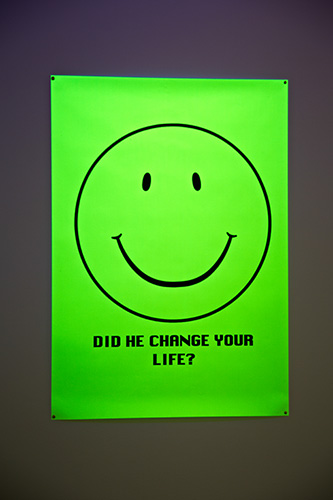
Gavin’s insistance that the exhibition ‘examines the utopian ideas surrounding rave before its failure’, seems to ignore what the artists in the show might consider the actual moment of rave’s failure. This central oversight leads to others. The choice of JG Ballard’s Crash as key-text, while obliquely relevant as an aesthetic touchstone of dystopia, doesn’t really reflect on the ‘realness’ of the scene artworks such as Gorczynski’s reference – it would be nice to have a chance to review the impact of a novel like Irvine Welsh’s Maribou Stalk Nightmares on this generation, or reflect on how current novelists such as Tao Lin use prose style to echo the afterlife of re-illusioned rave and drug culture.
The best works in E-Vapour-8 exist as echoes a UK club culture with more ambiguous relations to capitalism and politics than the radical and resistant Acid House rave. The void left by the hedonistic lifestyle is a simulacrum in a work like Faramawy’s, for the void left in our lives by the death of the hope of capitalism, and our continued afterlife within it – like a club we’re forced to keep revisiting even though it’s too expensive the DJs are shit and people keep getting shot.
The deep cuts in Sophia Al Maria’s and Fatima Al Qadiri’s How Can I Resist U are reconstituted and assimilated into an elegy – to the ‘bootyshake’ and bass, but also to social distribution and emptying out of utopian modernist architectures, using the lo-fi and hi-rise as distinctly modern hallucinations, and touching clearly on Sheffield’s own rave heritage in buildings such as the Park Hill flats.
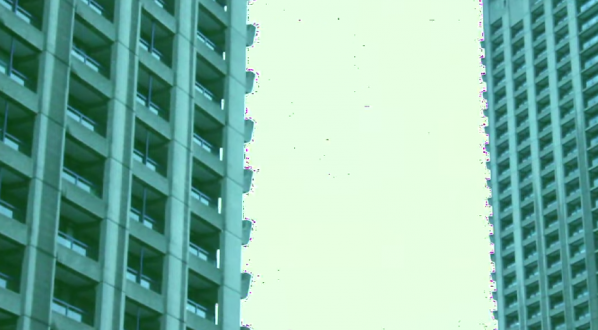
Seen in the light of her generational ‘shortfall’ (being too young to have been seen Altern8 in the Hacienda, but old enough to have got down to Ed Rush at The End) Petra Cortright’s subtle and lyrical cutting and smeering of an original video and its soundtrack in Lara Practice, reminds me of the millenial dancefloor vibe – how out of place those moves were, how re-territorialised they immediately became.
“I start to wonder if she, like me, got sucked in by Ardkore’s explosive euphoria, its manic, fiery-eyed glee, and then got carried along by the music’s logical evolution to wind up at another place altogether, dystopian rather than utopian.” Simon Reynolds ‘”Slipping Into Darkness” The Wire #148
As examples of the thematic depth offered in this show, the Al-Qadiri/Al-Maria and Cortright videos capture the implosion of a naïve energy. By focusing on the female body in the throes of bass, they present distinct and equally valid breakages taking place between anticipation and experience – and the emergence into a darker real and global hyper-real. The artists’ contemporaries in the music scene (including vapourwave artists such as Vektroid and Oneohtrix Point Never) deserve some credit for informing a culture which can act in this way.
It would seem that a gallery of this stature, and a curator with the contemporary culture credentials of Francesca Gavin – visual arts editor at Dazed – would be more keen to link visual art with actual dance culture, rather than a fully assimilated cultural caricature like happy hardcore… but then, the exhibition itself is an opportunity for us to do just that.
I recommend a visit – the show is on until August 17th. Those who were in a circa-1998 nightclub will recognize the nervy and unsettling sensation of the corridor or cloakroom queue, the combination of E-high with screw-face attitude. A steady, percolating dark bass among the hallucinatory imagery and tongue-in-cheek synth refrains. Those who weren’t will undoubtedly find their own touchstones in these independently deeply poignant and distinctly contemporary works.
Play with the Rubik Cube simulator online! Drag the pieces with your mouse to unjumble the puzzle.
Featured image: Image from “Otherworldly” at Manchester Urban Screens 2007. Curated by Michelle Kasprzak
Eva Kekou interviews Michelle Kasprzak, a Canadian curator and writer based in Amsterdam, the Netherlands. She is a Curator at V2_ Institute for the Unstable Media and the Dutch Electronic Art Festival (DEAF). She has appeared in Wired UK, on radio and TV broadcasts by the BBC and CBC, and lectured at PICNIC. In 2006 she founded Curating.info, the web’s leading resource for curators. She has written critical essays for C Magazine, Volume, Spacing, Mute, and many other media outlets. She is a member of IKT (International Association of Curators of Contemporary Art). Michelle is also an avid weightlifter with current personal records of 80 kg squat, 52.5 kg bench press, and 90 kg deadlift.

Eva Kekou: Can you give us some info about your work as an artist and curator and specifically your work at V2_?
Michelle Kasprzak: I was trained as an artist, but my art career feels many moons ago now. My first love was photography, and I spent many hours in the darkroom as a teenager. Later on I moved into live video mixing for performance contexts and parties, single channel video works, and integrating technologies like speech recognition and found objects into performance.

I was also curating throughout this time, though for many years it took a back seat to my artistic practice. Eventually I realized that I was more interested in curating and writing than making the artworks myself. Of course, one should never say never, so I may return to art making someday, but from that point onward and until the present time I focused full-time on curating and writing.
This was the mid 2000s and it was a pretty exciting time to be a media arts curator. It felt as though things were gaining traction. So many years after Cybernetic Serendipity had laid the foundations, we had exhibitions such as The Art Formerly Known As New Media curated by Sarah Cook and Steve Dietz to stimulate the dialogue about new media art and how to exhibit it, and take it all to the next level.
Fast forward to now: a few years later, I’m a curator at V2_ Institute for the Unstable Media in Rotterdam, the Netherlands. V2_ loomed large for me as a young undergraduate in Toronto studying new media – it was this far away place in a city I didn’t know with this massive reputation for doing edgy, interesting things. I wouldn’t in my wildest dreams at the time ever imagine I would one day work there.
As an institute, V2_ has been through a number of key transformations and I think it’s interesting to map that on to what was happening at the time both in art and in society. It started in the 1981 as a squat (which was common in the Netherlands at that time) and the founders called it a “multimedia centre”. Sonic Youth, Laibach, and Einsturzende Neubauten played there. The “Manifesto for the Unstable Media” was written in 1987 and arose out of a dissatisfaction with the status quo and it said things like “Our goal is to strive for constant change”. Following the Manifesto, a series of “Manifestations of the Unstable Media” were created, which evolved into the Dutch Electronic Art Festival (DEAF), a festival which continues today. In 1994 V2_ moved from s-Hertogenbosch to Rotterdam and has remained there ever since.
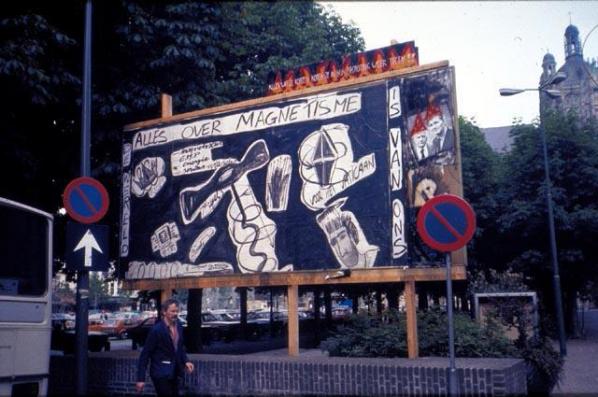
Around that same period of the mid- to late-90s, the growth of internet access and support for artists working with networked technologies caused V2_ to change its focus in this direction. In 1997, V2_Lab opened as a hub within V2_ to initiate and support the production of artistic projects investigating contemporary issues in art, science, technology, and society.
EK: So today, in this age of ubiquitous technology and information, where does an institute like V2_ find its place?
MK: I see media art as a category splintering and dissolving, with bits of its ethos absorbed into design, contemporary art, craft, and hacker culture – and vice versa. One way to find a place in the world is to stay true to the origins of V2_ in terms of its squatter ethic. So for example, we (myself and my colleagues, particularly Boris Debackere and Michel van Dartel) recently rewrote the mission statement of the Lab, declaring it “…an autonomous zone where experiments and collaborations can take place outside of the constraints of innovation agendas or economic and political imperatives.” Which is not to say that anything goes, but states explicitly that we’re especially open to people looking for a home for a risky or unconventional idea. Also, following on from several years where V2_Lab hosted residents based on three fairly technologically-driven themes (wearables, augmented reality, and ecology), the Lab has taken on a new direction of being methodologically-driven, and looking at themes like re-enactments, design fiction, and extreme scenarios.
I think it’s a key shift, because in order to “strive for constant change” as we said in the original manifesto, linking to any one technology of the moment seems too static and limiting, as well as reducing our reach into areas with interesting and relevant artistic research occurring, but which might not have much technology involved in an apparent way. The fact is just about everything being made right now is a product of the technological age we live in, so it’s more useful to think in terms of methods and approaches rather than whether something fits a classic definition of what media art is or not.
Take for example one of our latest commissions, Paper Moon by Ilona Gaynor in collaboration with Craig Sinnamon. Ilona and Craig were at V2_ for a few months at the end of 2013 and both have design backgrounds. The work, to describe it in a formal sense, is a series of objects and paper-based work arranged in a specific fashion along with a short screen-based animation. This seems a little different than what one might expect to see at V2_, except for small clues in the creation of some of the items (the animation is generated with 3D animation software, some of the objects have been 3D printed). But more significantly, in its thematic Paper Moon enters the realm of the unstable by exploring the emerging legal definitions and loopholes of outer space – particularly the treatment of the moon and other celestial bodies. Our legal system on Earth, as Ilona put it “…has no definition for what ‘Outer Space’ actually means, what it is, and where it is. The problem we face with such literal unmarked territory is the emergent field of ‘Space Law’ becomes genuinely speculative.”


Ilona’s residency was part of V2_Lab research project Habbakuk, about Innovation in Extreme Scenarios. The Innovation in Extreme Scenarios research thread was generated in reaction to the introduction of an innovation agenda for the arts as part of the Dutch government’s ambitionto be “one of the world’s top five knowledge economies” by 2020. As a way of directly addressing this policy direction, V2_Lab began undertaking research into the nature of and appropriate contexts for innovation through a series of expert meetings, workshops, site visits and interviews over the course of 2013-14. The final outputs of the project, which will comprise project commissions and a final publication, will be used as a tool to engage with the policy conversation on innovation in a more profound way. So we’ve been doing work on this at home and abroad, holding expert meetings and interviews in the Netherlands, Canada, Hungary, and Denmark.
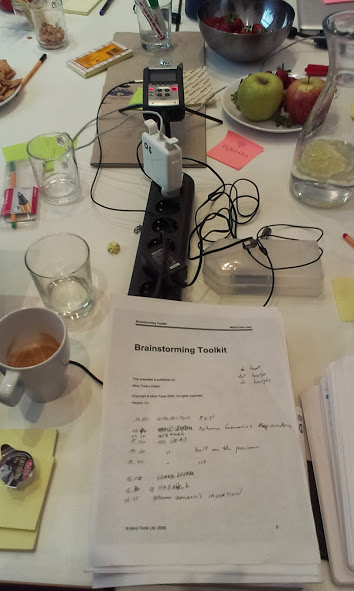
The Dutch policy context explains the “innovation” part, but the “extreme scenarios” part came from somewhere else. For that I was inspired by the World War II story of the Habbakuk aircraft carrier which was commissioned by Winston Churchill. The Allies were plagued by German U-boats, and Churchill desperately needed an innovative solution to this particular problem. In the extreme scenario of war, Churchill authorized the production of a radically innovative solution: building an aircraft carrier made of ice – specifically Pykrete, a frozen mixture of water and sawdust.
Pykrete seems like ordinary ice but the addition of sawdust makes it into a kind of wonder material that takes longer to melt and invulnerable to bullets. In the end the massive ship, which was to be christened “Habbakuk”, never saw the theatre of war but considerable effort was put into developing a prototype in total secrecy deep in the Canadian Rockies.
Inspired by both the Habbakuk story and our own policy situation brewing at home, some of the questions we’ve been trying to answer with this research are things like: What are the best contexts for innovation to take place? What are the myths surrounding how innovation occurs? Does the pressure of an extreme scenario inspire innovative solutions, or only eccentric, unrealisable concepts? What’s the U-boat problem of today?

The theme of Innovation in Extreme Scenarios is also being explored in the programme that I devised and curate at V2_ called Blowup. Blowup refers to a number of things: the way that you can blow up a photograph, a balloon, a situation, and of course – the Antonioni film. I see it as a container that presents things in a slightly different way each time, and that its main remit is to examine the things that are changing the way we live now, or reinforcing the status quo of today. The formats for Blowup have varied a lot: from a workshop, to a talk show, to a talk show within a talk show, to a five day booksprint, to an exhibition in a pop-up space. The topics have been equally eclectic: art for animals, outer space, journalism as an art practice, object-oriented ontology, and so on. The most consistent element is that each event has an eBook released along with it, and that these eBooks explore the topic in a little more depth, but also combine previously released material with newly commissioned material. We all have bulging bookshelves and intend to always read something later – by bringing relevant old texts back into the forefront, I hope to give them a chance for a second look (or a first look if you missed it when it was released).
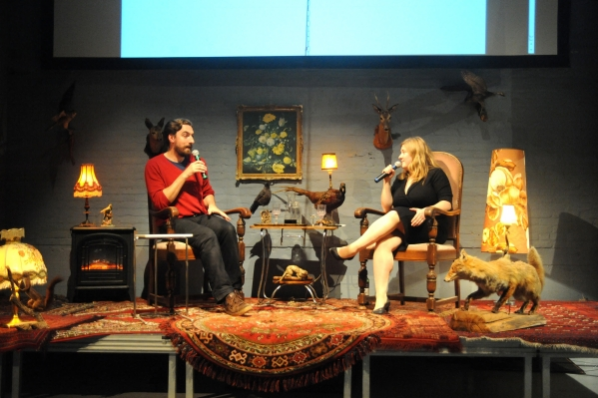
EK: What are your hopes and dreams for the future?
MK: For the future, I think new ideas are incredibly rare, and that doesn’t bother me at all – what interests me is that dreams that were previously impossible are becoming possible, and so my passion continues to be seeking out the inventive eccentrics with grand master plans, and being a part of realising that. Churchill dreamed of ending the war with a boat made of ice more than ten times the size of the Queen Mary. These are the kinds of big wild dreams – in scale and in scope, if not in my discipline – that I dream of.
Die GstettenSaga: The Rise of Echsenfriedl review. SPOILER WARNING!
Johannes Grenzfurthner’s Post-Apocalyptic DIY Epic on Makers, Hacktivism and Media Culture.
“A mad post-collapse satire of information culture and tech fetishism, in a weird sort of melding of Stalker, Network, and The Bed-Sitting Room.” (Richard Kadrey)
Die GstettenSaga: The Rise of Echsenfriedl is an Austrian hackploitation art house film by Johannes Grenzfurthner, mastermind of the international art-technology-philosophy group monochrom, co-produced by the media collective Traum & Wahnsinn. Reimagining the makerspace as grindhouse, the story is set in the post-apocalyptic aftermath of the “Google Wars” – an armed global conflict between the last two remaining superpowers China and Google – which has turned what remained of the Alps into a Gstetten.
In Austrian German, “Gstetten” translates to wasteland, outback or ‘fourth world’ (Manuel Castells) and is a popular name for provincial towns – and sometimes just the less sophisticated parts of them. The area’s biggest semi-urban sprawl is Mega City Schwechat, the former home of Vienna International Airport, a refinery and a beer brewery. It is governed by the evil media mogul Thurnher von Pjölk (Martin Auer), a pretender who claims to be the inventor of key publishing technologies such as letterpress printing and rules the area with his tabloid newspaper. But the hegemony of his yellow press empire is contested by – spoiler alert! – makers, hackers and nerds, who are more leaning towards electronic media such as the recently rediscovered television. In order to get rid off this bothersome opposition, Pjölk devises an evil plan for wiping out Schwechat’s insubordinate creative class.

In an insidious political move, he pretends to reach out for the technophile faction by commissioning two of his reporters, the bootlicking opportunist Fratt Aigner (Lukas Tagwerker) and the brainy geek girl Alalia Grundschober (Sophia Grabner), to conduct an exclusive TV interview with the ultimate Gstetterati icon, the legendary innovator Echsenfriedl (“Lizard Freddy”) – on the basis of precarious employment conditions. The title character, who turns out to be an basilisk, embodies a mix of Steve Jobs, Richard Stallman and Julian Assange and lives in the depths of Niederpröll in his hideout much like Subcomandante Marcos – partly in order to protect the world from his killing gaze, which would, audio-visually transmitted, turn the whole of his fan base immediately to stone.
Grenzfurthner’s sci-fi-horror adaption of the Divine Comedy takes us on a retro-futuristic post-cyberpunk adventure in the tradition of cinema grotesque back to the dark days which preceded the Internet. The journey of our heroes – distinctively resembling Tarkovsky’s ‘stalkers’ – is a quest for extinct media technologies but their search for Echsenfriedl eventually leads the two protagonists to a deepened understanding of who they really are: the media industry’s precarious workforce under spectacular capitalism. While Fratt’s dirt track to enlightenment is paved with stumbling blocks, his brainy Beatrice advances with the determination of a Harawayian cyborg who makes use of her superior technical skills to save them from the zombified folk populating the Gstetten: uncanny creatures from the Kafkaesque bestiarium of Austria’s undead bureaucracy and its hanger-ons like armed-to-the-teeth Postal Service subcontractors (brilliant: monochrom’s Evelyn Fürlinger, also Grenzfurthner’s ex-wife) or the once powerful Farmers Association led by Jeff Ricketts (Firefly, Buffy the Vampire Slayer), who are worshipping antique pre-war EU funding applications as their sacred scriptures. Our friends receive the final hints for their search from the Sphinx Philine-Codec Comtesse de Cybersdorf (Eva-Christina Binder), a fantasy femme fatale who is torn between Plöjlk and Echsenfriedl, and the bearded drag queen Heinz Rand of Raiká (David Dempsey), an eccentric agricultural cooperative banker and possible descendant of Conchita Wurst.

The Gstettensaga’s fascinating cinematic pastiche is more than just a firework of rhizomatic intertextuality, a symptom of the depthlessness of postmodern aesthetics or excessive enthusiasm for experimentation in the field of form. In their infamous 1972 book Anti-Oedipus, Gilles Deleuze and Félix Guattari have identified the technique of bricolage as the characteristic mode of production under “schizophrenic” capitalism, a facet triumphantly magnified by the filmmakers. If every discourse is bricoleur, like Jacques Derrida suggested, suddenly ‘context’ can become the artist’s material or even a form of art in its own right:
“The more artists are consigned to an existence within a patchwork of niches, the more dependent they become on information resources, communication and networking. In this respect, aesthetic artefacts must take a stance toward a plethora or markedly heterogeneous contexts that sediment in one way or another: the conditions and circumstances surrounding their production, their various social fields from which (and for or against which) they speak: real or imagined audiences toward (or against) whose values a work, an approach or a position is targeted. This play with the factors affecting it and among which it must mediate has become an essential trait on an art form that might best be described as ‘Contextualism’.” [1]

What I found especially intriguing about the Gstettensaga is how the filmmakers responded to the various challenges of the feature film format by contextualising the whole production process, distribution, language adaptions (subtitles are an integral part of the story), soundtrack and even the viewing experience.
The film was initially commissioned by Austrian public broadcasting station ORF III as part of the series Artist-in-Residence for a budget of only €5000, set to be produced within a six months period. In response, monochrom used an embedded prank to raise money. The movie contains a text insert similar to watermarks used in festival viewing copies, which asks the viewer to report the film as copyright infringement by calling a premium-rate phone number (1.09 EUR/minute) and enabled Grenzfurthner to co-finance the film with proceeds from this new strategy he has named ‘crowdratting’. [2]
The Contextualist script – including outlines of scenes for improvisation – was written by Grenzfurthner and Roland Gratzer in just a couple of days in November 2013 in a Viennese restaurant. They also incorporated ideas that came up during their weekly meeting with the entire production crew, whereas some of the backstory was first created for monochrom’s pen-and-paper role-playing theatre performance Campaign. Principal photography – the camera work of Thomas Weilguny deserves the highest praise – commenced on December 2, 2013 and ended January 19, 2014, which left nearly 5 weeks for post-production and editing. Due to the fast production process and the financial limitations, no film score was composed for the Gstettensaga – instead, Grenzfurthner used an assortment of 8bit, synth pop and electronica tracks especially for their specific retro quality because “they may sound old-school to us, but not in the world of the Gstettensaga, where all retro electronic music is still impossible and futuristic.” [3]
The retro-futuristic world of Echsenfriedl is coming to a film festival, hacker con or Pirate Bay near you.
http://www.monochrom.at/gstettensaga/
Tamtam (Seara de proiectie la TT) / May 7, 2014 (Timisoara, Romania)
KOMM.ST Festival / May 11, 2014 (Anger, Austria)
Supermarkt (Dismalware) / June 7, 2014 (Berlin, Germany)
Fusion Festival / June 25-29, 2014 (Lärz Airfield, Mecklenburg, Germany)
Roswell International Sci Fi Film Festival / June 26-29, 2014 (Roswell, NM, USA)
iRRland movie night / June 30, 2014 (Munich, Germany)
qujochö Film Summer / July 3, 2014 (Linz, Austria)
HOPE X / July 18-20, 2014 (New York, New York, USA)
Fright Night Film Fest / August 1-3, 2014 (Louisville, KY, USA)
Gen Con Indy Film Festival 2014 / August 14-17, 2014 (Indianapolis, Indiana, USA)
San Francisco Global Movie Fest / August 15-17, 2014 (San Jose, CA, USA)
Rostfest / August 21-24, 2014 (Eisenerz, Austria)
Noisebridge / August 29, 2014 (San Francisco, USA)
/slash Filmfestival / September 18-28, 2014 (Vienna, Austria)
Simultan Fest / October 6-11, 2014 (Timisoara, Romania)
Phuture Fest / October 11, 2014 (Denver, Colorado, USA)
prol.kino / October 14, 2014 (Graz, Austria)
Featured image: A Tool To Deceive And Slaughter” (2009) Caleb Larsen
Accelerationism came to prominence in 2013 with Nick Srnicek and Alex Williams’s hashtag-titled manifesto. A cloud computing-era spin on the old Marxist argument that we first need to perfect capitalism in order to transcend it, its lineage is fleshed out in a new book from Urbanomic. Urbanomic claim (among others) Nick Land’s skynet midwifery, J.G. Ballard’s science fictionalization of culture, and Marx himself as precursors to Accelerationism, establishing it as a serious anti-humanistic response to the challenges that humanity faces if it is to avoid extinction. Similar to Christine Harold’s strategy of “intensification“, Accelerationism calls for us to appropriate the value of capital’s developments and transform them materially into something else rather than attempt to resist them head-on or refuse them in our hearts.
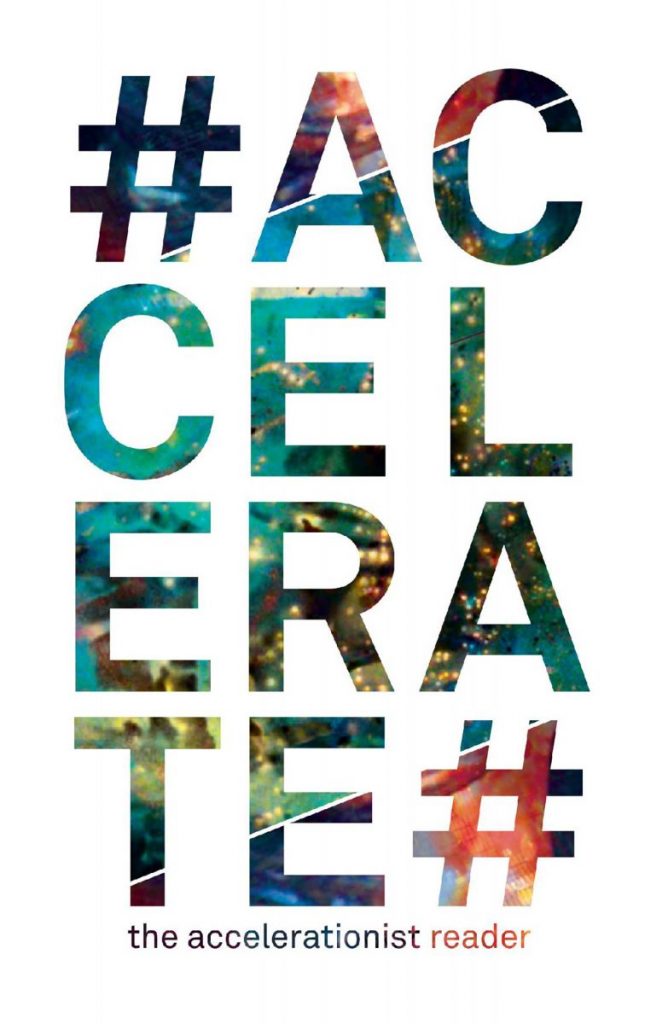
Bitcoin is an example of an accelerationist technology. It uses Internet-scale computing resources to rebuild social bonds by destroying the requirement for them in monetary exchange. You don’t have to know me or trust me or any third parties to receive money from me in the form of Bitcoins. You just have to trust the algorithms that very publicly operate the Bitcoin network. The new Ethereum project takes the blockchain technology behind Bitcoin and generalizes to contracts for purposes other than just the transfer of money, although of course those contracts can involve payments. Ethereum contracts exist as a distributed database of small programs and their state that resembles nothing so much as an economic LambdaMOO. There’s a good guide to their promise and potential pitfalls in the talk “Ethereum: Freenet or Skynet ?” by Berkman Center Fellow Primavera Di Filippi.
Smart contracts and smart property, which uses smart contracts to identify and control ownership of physical resources, were first described by Nick Szabo in the 1990s. Smart contracts are “smart” because they are implemented as computer code rather than as legal documents. Real world examples include vending machines, in which a contract to purchase goods is encoded into the simple software that dispenses carbonated drinks when you insert the correct money, Boris Bikes, RFID card payments for photocopies, and car hire schemes that unlock vehicles and track their use with QR codes. Would-be rentiers who try to launder their ambitions with the warm fuzziness of “sharing” are salivating at the prospect, as are the incorrigible snake oil merchants of DRM, but that is not what concerns us here.
Smart contracts and smart property for art already exist. The artwork “A Tool To Deceive And Slaughter” constantly re-sells itself on eBay. The GIF ownership service “Monegraph” uses the NameCoin system to track notional ownership of instances of infinitely reproducible digital art. These are extensions of pre-digital art contracts such as certificates of authenticity or ownership for conceptual and immaterial artworks. They show a way for art to continue producing a useful critique of property and social relations under technoculture, and for new technology to feed art’s ongoing critique of its own production and nature. I wrote about this in “Artworld Ethereum – Identity, Ownership and Authenticity“, which provides code examples demonstrating how simple it is to implement some of these examples with technology dedicated to smart contracts.
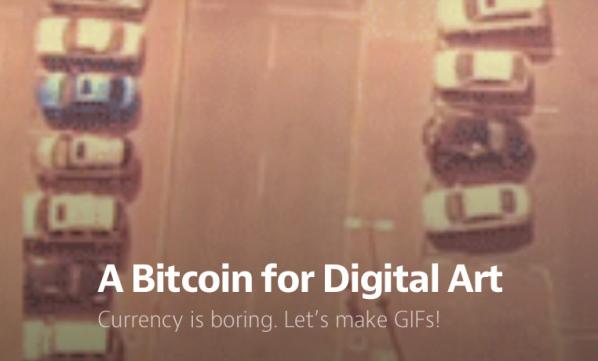
Like Bitcoin, smart contracts and smart property do not require social trust to build social value, just running code. They have very limited functionality, being unable to check RSS feeds on the Internet for information for example as that information might be tampered with. This raises the question of how individuals can be encouraged to provide valid real-world information to smart contracts rather than just entering the values that will immediately profit them the most. Capitalist economics answers this with the concept of incentives. Value, and values, can be determined by the behaviour of individuals in markets in response to economic incentives. And smart contracts are intended to make markets more efficient.
I would like to apply this agoric approach to truth to the crisis of art criticism in the face of aggregation that I identified in “The Proletarianization Of Art Criticism“. Individuals can be motivated to publish defensible aesthetic and art critical opinion in novel ways via smart contracts. I am not proposing an automated or purely algorithmic art criticism here: human activity is the core of this approach. Nor am I proposing an Amazon Mechanical Turk-style exploitation of affective labour. Rather I am proposing an Accelerationist approach, using the technology of digital capitalism to rebuild the social flows that it has destroyed.

Art is no stranger to the idea of markets, the artworld consists of one of the least regulated and therefore in theory one of the purest markets. But even ignoring the opacity and corruption of the art market, there is a problem with taking a direct approach to the art market as an arbiter of artistic value. As David Galenson‘s 2008 study of aesthetic value and market price showed there is a problem in using pure market mechanisms to establish the value of art: many “great works” have either never been auctioned or have not been to market in decades or even centuries.
I therefore propose three different approaches to art criticism via smart contracts. For work exposed to the market, the mechanisms used to price shares and other financial assets can be used. For work with less exposure, SchellingCoins and prediction markets can work alongside these mechanisms via proxies.
The prices of financial assets, stocks and shares or contracts for commodities for example, are set using a system of derivatives. Financial derivatives gained a bad reputation following their role in the global financial crash of 2008. By 2011 the notional value of the derivatives being traded was almost ten times the total GDP of planet Earth. And their automation by algorithmic high frequency trading is being increasingly scrutinized by regulators.
There are many different kinds of derivatives: short and long options, futures and exotics for example. But in theory at least their function is simple and beneficial. They enable individuals to profit by expressing whether they think a financial asset is over- or under-priced. This incentivizes them to act on this information. The resulting sharing of information and correction of prices benefits society.
Non-physical ownership, sponsorship, crowdfunding, dedications and more exotic value relationships to physical works and, crucially, to works that have not or will not be sold and to unownable digital art can be represented by smart contracts. These can then be treated as the underlying assets of derivatives, also represented as smart contracts, in whole or again crucially in fractional parts or shares. Buying and selling derivatives of shares in digital artworks, and particularly going short or long on them, represents a critical position on their worth. Where the underlying asset does not represent actual ownership of the artwork, we are closer to a prediction market than a financial market. But if the assets themselves attract prestige or value regardless of their proxy status they may become art objects in themselves.
Art criticism in such a market is a matter of financial investment and returns. Critics express their opinion of art, artists and artistic trends by buying and selling different kinds of derivatives at different times. If they are shown to be correct over time, the market will reward them. Derivatives are a prime candidate for implementation as smart contracts, there is already a project to create a standard language of (non-aesthetic) derivative smart contracts.
Since Ethereum contracts have no direct access to the outside world (or the Web), contracts that require information about the outside world must access it through intermediaries. This means that contracts must trust those intermediaries, and if it is more profitable for them to lie to the contracts that creates a problem. To remove this requirement of trust we can use a system that rewards people for independently supplying information that accurately reflects the true (or most likely) state of the world.
A SchellingCoin is an Ethereum contract that allows people to send it messages registering their opinion about (for example) the current temperature in Berlin or exchange rate between dollars and yen. Those that set the majority view are rewarded for doing so, similarly to the operation of a prediction market. But how do they know which value to choose? The game theory concept of a focal point, or Schelling point, is an answer to a question that people who cannot communicate will give independently because it seems natural, appropriate or special. SchellingCoins reward people who give the consensus answer to a question, and people can determine the right answer by converging on a Schelling point. For real world phenomena, such as temperature or exchange rates, the Schelling point is likely to be the correct answer. SchellingCoins can be implemented as smart contracts, removing the need for a trusted entity to run them.
Schellingcoins are designed to address external, quantitative phenomena. Opinions regarding cultural works are personal and qualitative, and spontaneous reactions to cultural works are even more so. This is different from the commonly expressed quantitative values that the SchellingCoin proposal requires. To adapt SchellingCoins to cultural criticism we must adopt the methods of collective intelligence and the digital humanities and use some tricks to turn personal opinion into cultural appraisal.
Collective intelligence algorithms work well with star rating systems and tags. These are popular methods for rating books, films and music on ecommerce and review sites. They can be represeented, aggregated and extrapolated from easily by software, which makes them ideal for representing opinion in SchellingCoins. There are risks in using such systems, as the low rating of the film “Gunday” on IMDB shows, but they are easy and accessible to use.
Digital Humanities approaches often involve counting the frequency of words in texts or other unstructured phenomena. The results of binary checks or of counts can be applied to Schelling coins. For example, whether an artwork appears on CAD or Rhizome or not, or whether the words “blue” or “postbinary” appear the most in reviews about it on major review sites can be reported via further SchellingCoins or via trusted feeds or oracles.
To turn these approaches into a SchellingCoin, we do not ask what people think of an artwork. We ask them what they think the average reviewer will think of the artwork (or to protect against gaming, we ask them to predict the curve for all the star ratings for the work). Given the theory of focal points, the most likely answer is the one that people suspect will be true.
Cultural SchellingCoins can therefore function as aggregators of opinion-about-opinion-about artworks, producing qualitative but consensual evaluations and critiques of works of art that contain more information than purely price-based mechanisms. Using SchellingCoins to aggregate opinion about other schellingcoins, Meta-SchellingCoings, can provide more general cultural critique.
To turn reviews into art criticism with a longer or broader perspective we can ask people not what the current state of reviews of the artwork but about what they will be in a year’s time, five years’ time, etc. How highly starred will they be and what tags/words will be used to describe them? Will the work (or the artist) be used as a point of comparison in reviews and articles? Will it (or they) still be being exhibited or purchased, and in what kind of galleries? How much will the work sell for, or in the absence of sales how many people will visit it at exhibitions? Will the artist still be working in that style, or how will their work have changed?
Each prediction can be represented as a security in a prediction market, and the current price of that security can be interpreted as the probability of that prediction. For example, a prediction market security might reward a hundred Satoshis or ten points if a particular artist has a headline show at Tate Modern. If you think there’s an 80% chance of that happening, you can pay up to 80 Satoshis or 8 points for the security representing that prediction. If you’re right you gain in return for improving the market, if you’re wrong you lose instead. There is evidence that prediction markets are successful, although they have been banned as a form of gambling in the US and the Pentagon’s 2003 attempt at a political prediction market was quickly labelled a “terrorism futures market” by the press and taken offline.
There is already a successful cultural predicton market, Hollywood Stock Exchange, where the price of “shares” in actors, directors and movies function as a prediction of their performance at the box office. The art market itself can be considered a kind of hybrid prediction market, but separating out that predictive function into a pure prediction market concentrating on critical evaluation can remove distortions that result from manipulation of the secondary market and solve the problem of representing critically valuable artworks that aren’t part of the art market.
It’s also possible, as with Hollywood Stock Exchange’s use of directors and actors as well as movies, to have prediction markets for other artworld entities. Not just artists and galleries, but movements, styles, genres, subject matter, even formal and aesthetic properties such as colours can be represented as securities in a prediction market. Buying and selling them can help set a shared understanding of their potential and impact.
Prediction markets can be represented as Distributed Autonomous Organizations (DAOs) on Ethereum’s blockchain, free from central control. DAOs present an opportunity to re-think and re-implement organizations on the blockchain. As well as markets they can be used to manage events, publications, co-operatives and educational or artworld institutions on various organizational models in a public and transparent way.
Cultural SchellingCoins, Artistic Prediction Markets and Aesthetic Derivatives are Accelerationist technologies for art criticism. Not necessarily for art criticism of the kind that survives online after being exiled from print media. Rather a functional equivalent to it that recaptures its lost authority in the form of a relationship between individuals and artistic production that exerts a guiding hand on its reception and direction. As they represent an emergent ontology of art and aesthetics manipulating these technologies, whether through technical or social means, is itself art and art criticism.
The text of this essay is licenced under the Creative Commons BY-SA 4.0 Licence.